
| JAPANESE | TOP PAGE | |
|---|---|---|
| 0 | 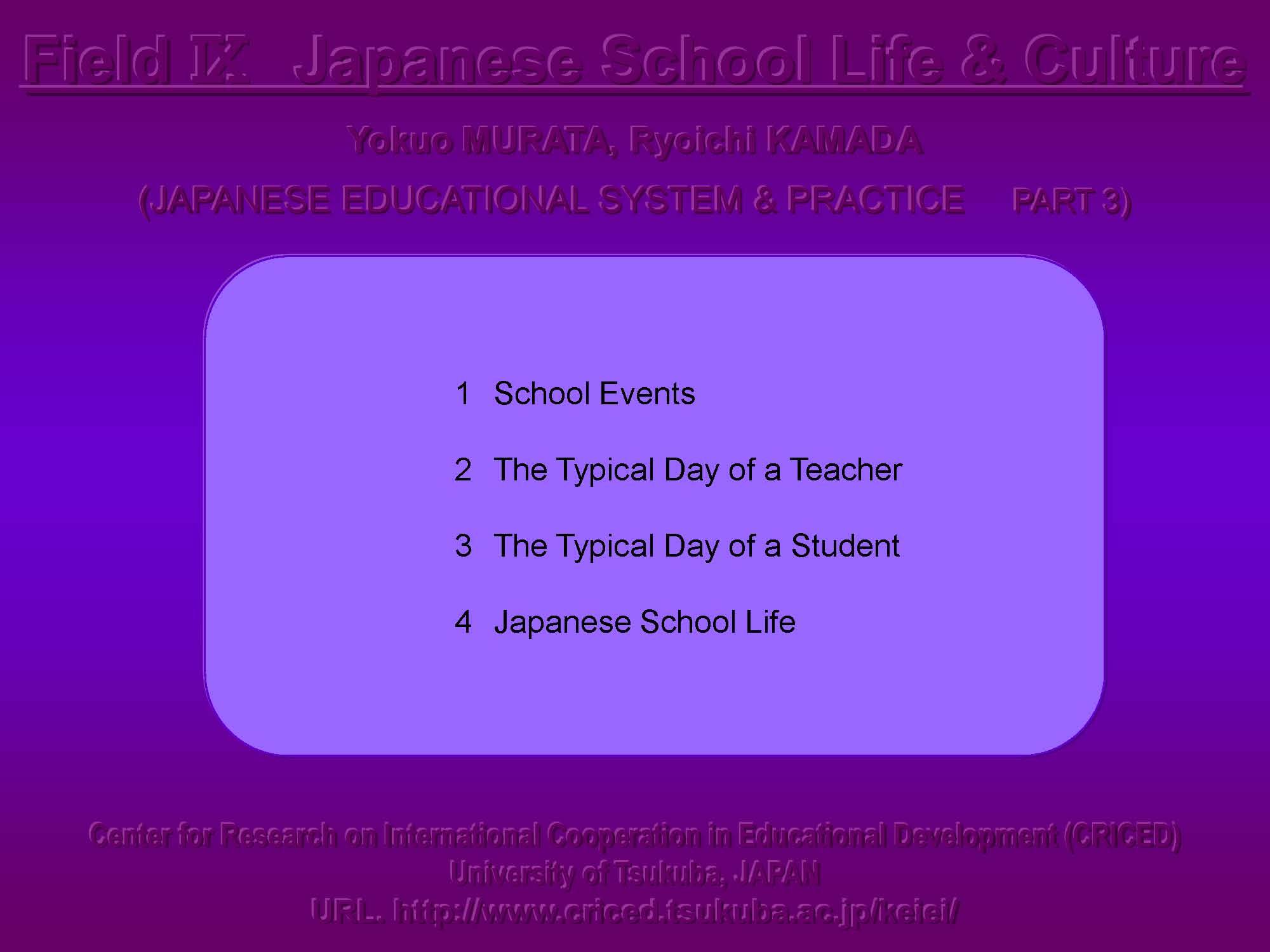 |
Download : IX Japanese School life and Culture |
| 1 | 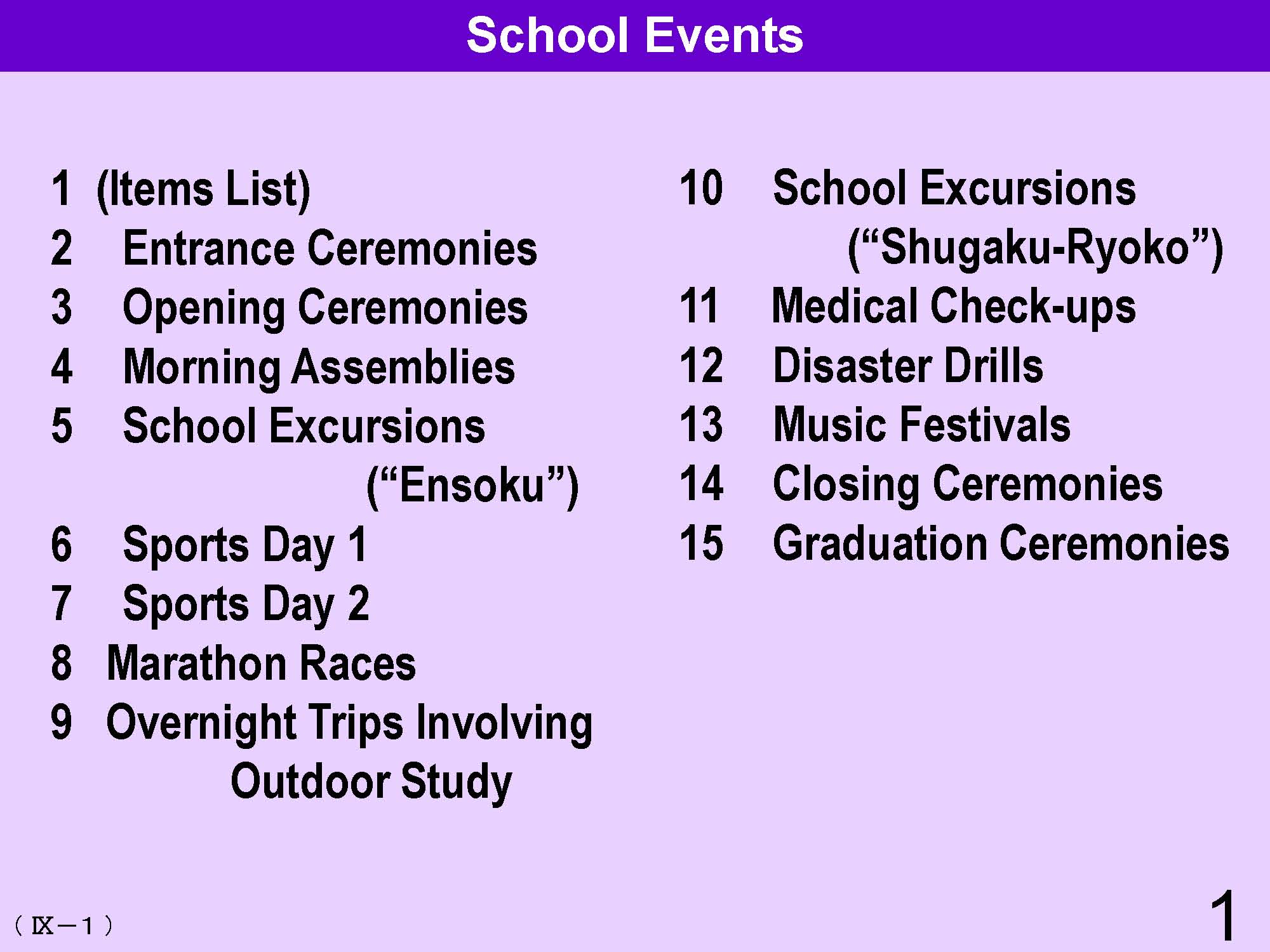 |
The course of study defines five types of school events. ①Ceremonial events ②Events concerned with arts ③Events concerned with health/safety/physical education ④Events such as a school trip/collective lodging ⑤Events concerned with labor service or volunteer (Special activities →Ⅳ-49) |
| 2 | 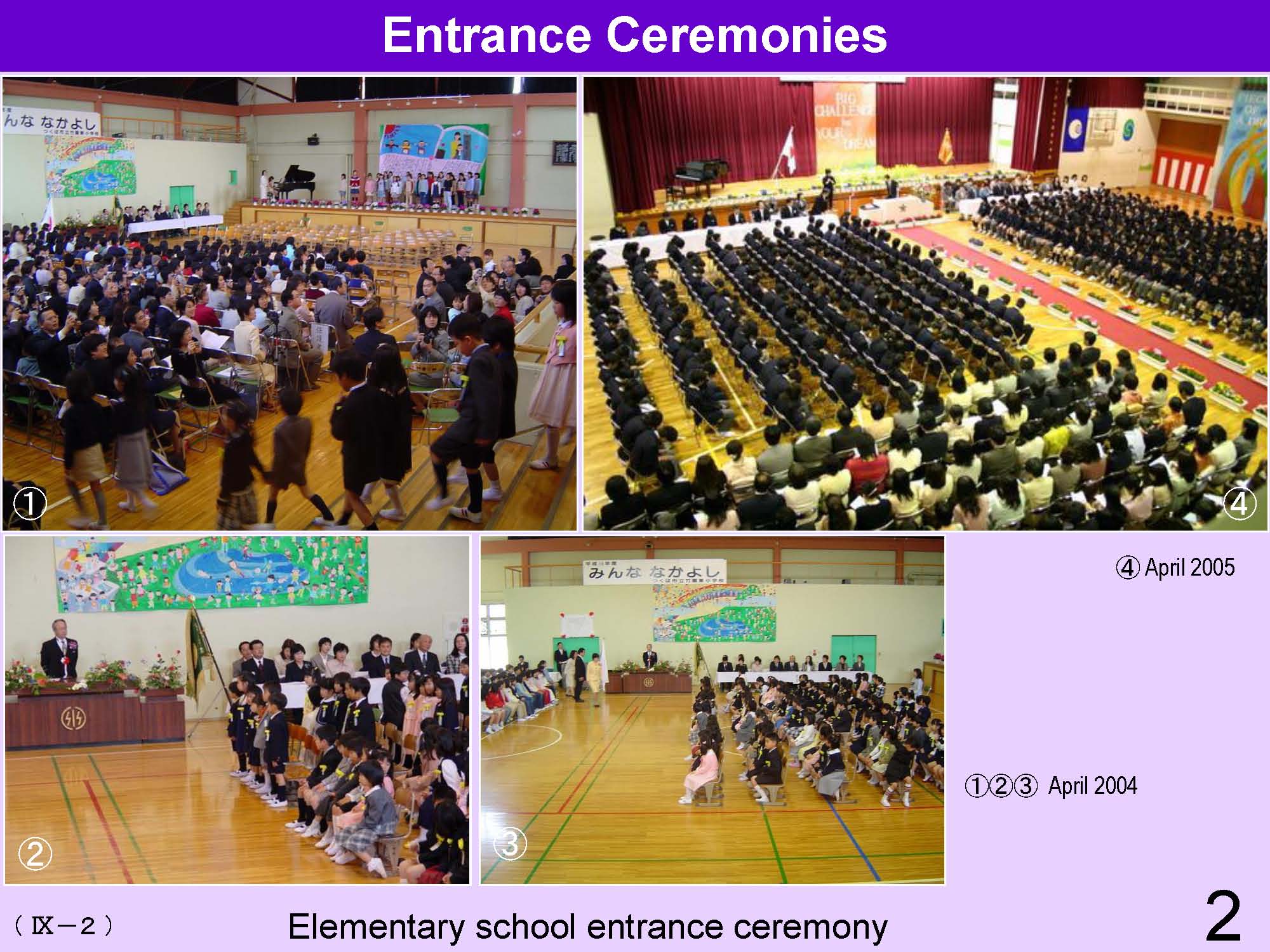 |
①Primary school entrance ceremony (admission of new 1st grade students), April 2004 ②Primary school entrance ceremony (principal’s speech) , April 2004 ③Primary school entrance ceremony (the introduction of homeroom teachers) , April 2004 ④Lower secondary school entrance ceremony, April 2005 The school draws a line between the beginning and the ending of events, activities, and classes, etc. |
| 3 | 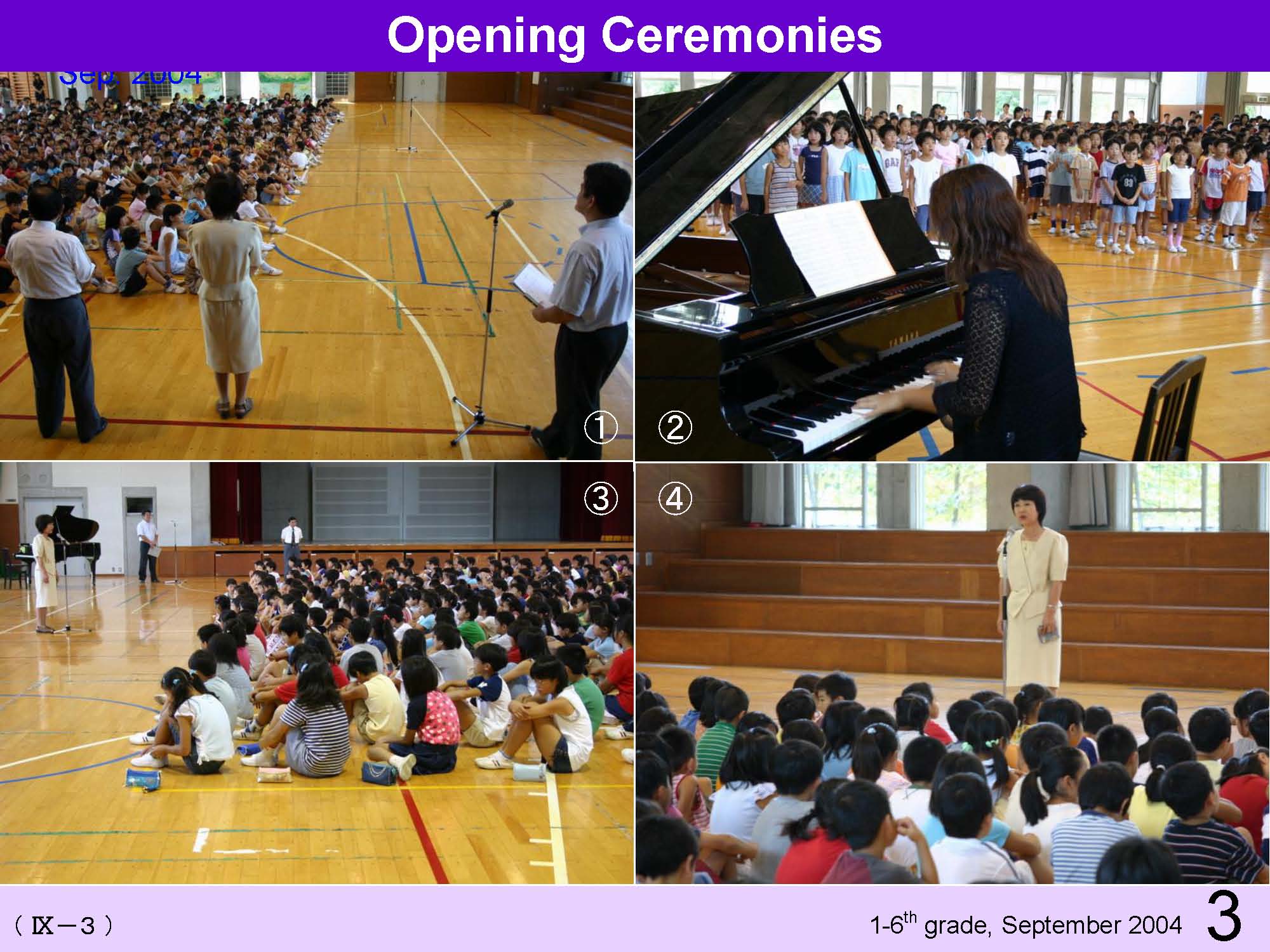 |
①The start of an opening ceremony for the new term ②Singing the school song ③④A speech from the principal In the beginning of ceremonies students usually sing a school song and the national anthem, and the principal or vice makes a speech. |
| 4 | 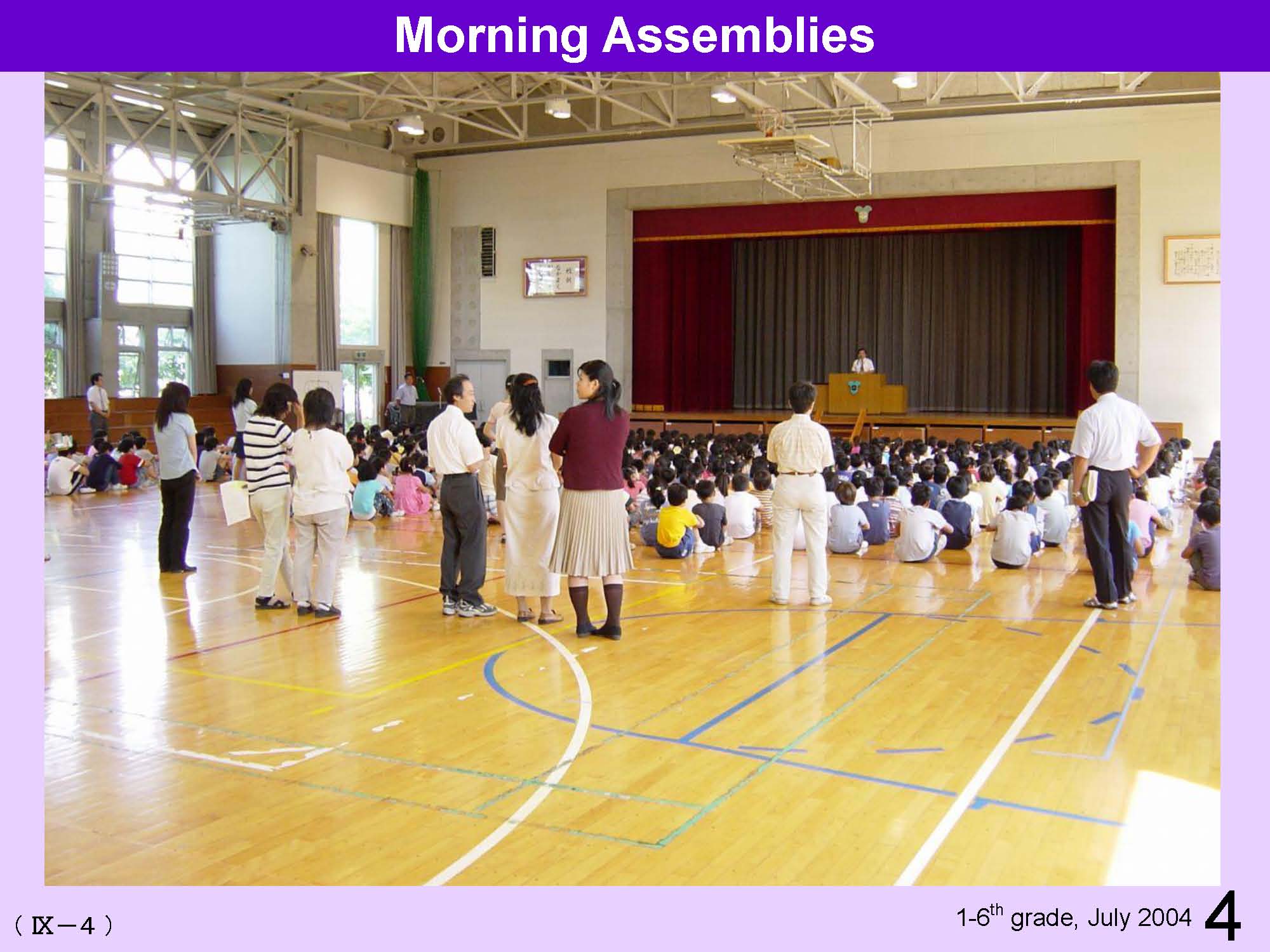 |
The morning assembly and vice-principal’s speech |
| 5 | 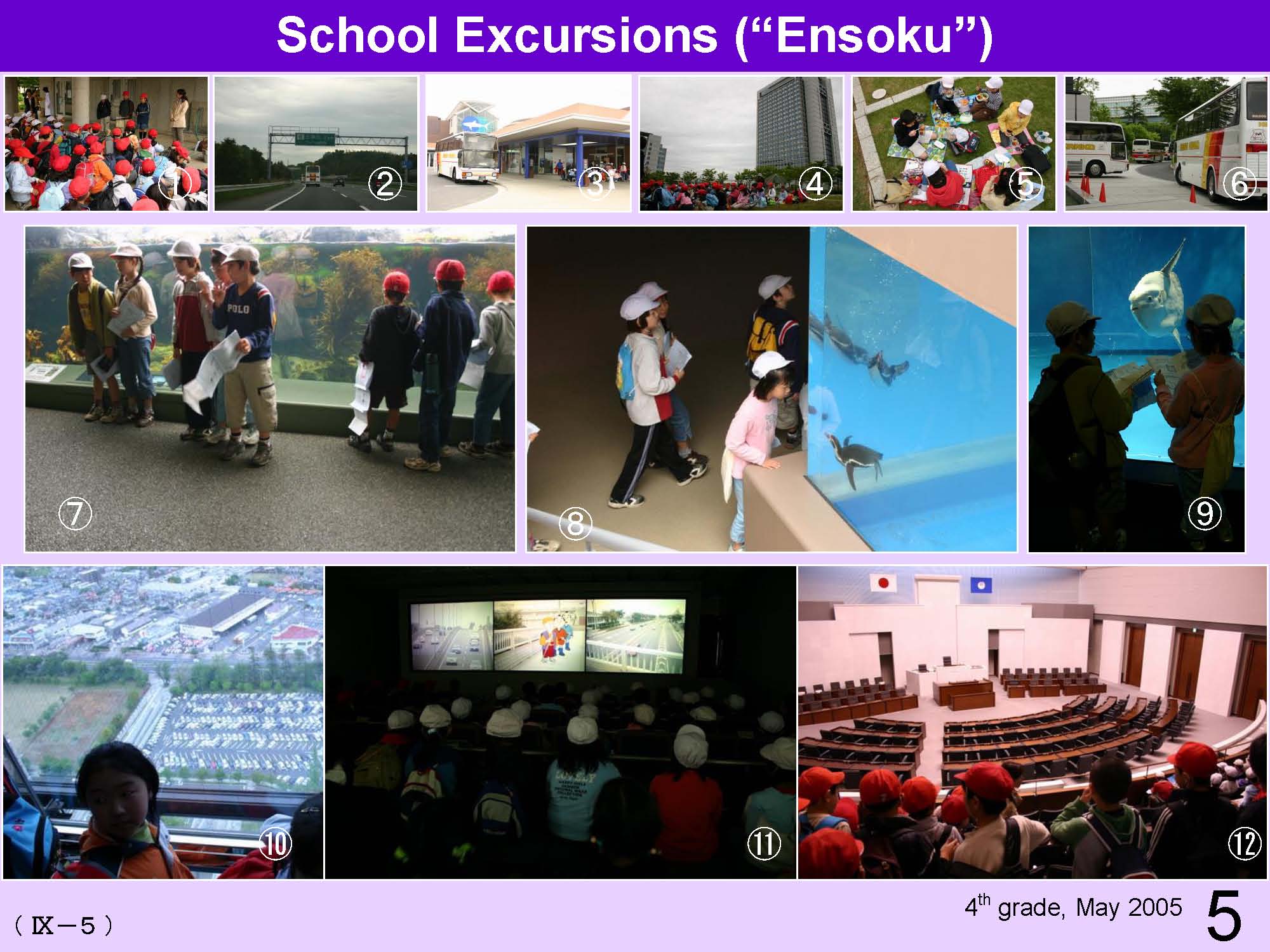 |
①② Departure from the school ③ Aquarium, ④ Prefectural office, ⑤ Eating lunch, ⑥ Returning to school, ⑦⑧⑨ Aquarium (Students in a group are moving and watching during the school excursion), ⑩ Prefectural office, ⑪ Prefectural office (an explanation with video), ⑫ Prefectural office (prefectural parliament) The students are asked to be punctual during assemblies and departures. Though school excursions students deepen their understanding of community characteristics and modern society. |
| 6 | 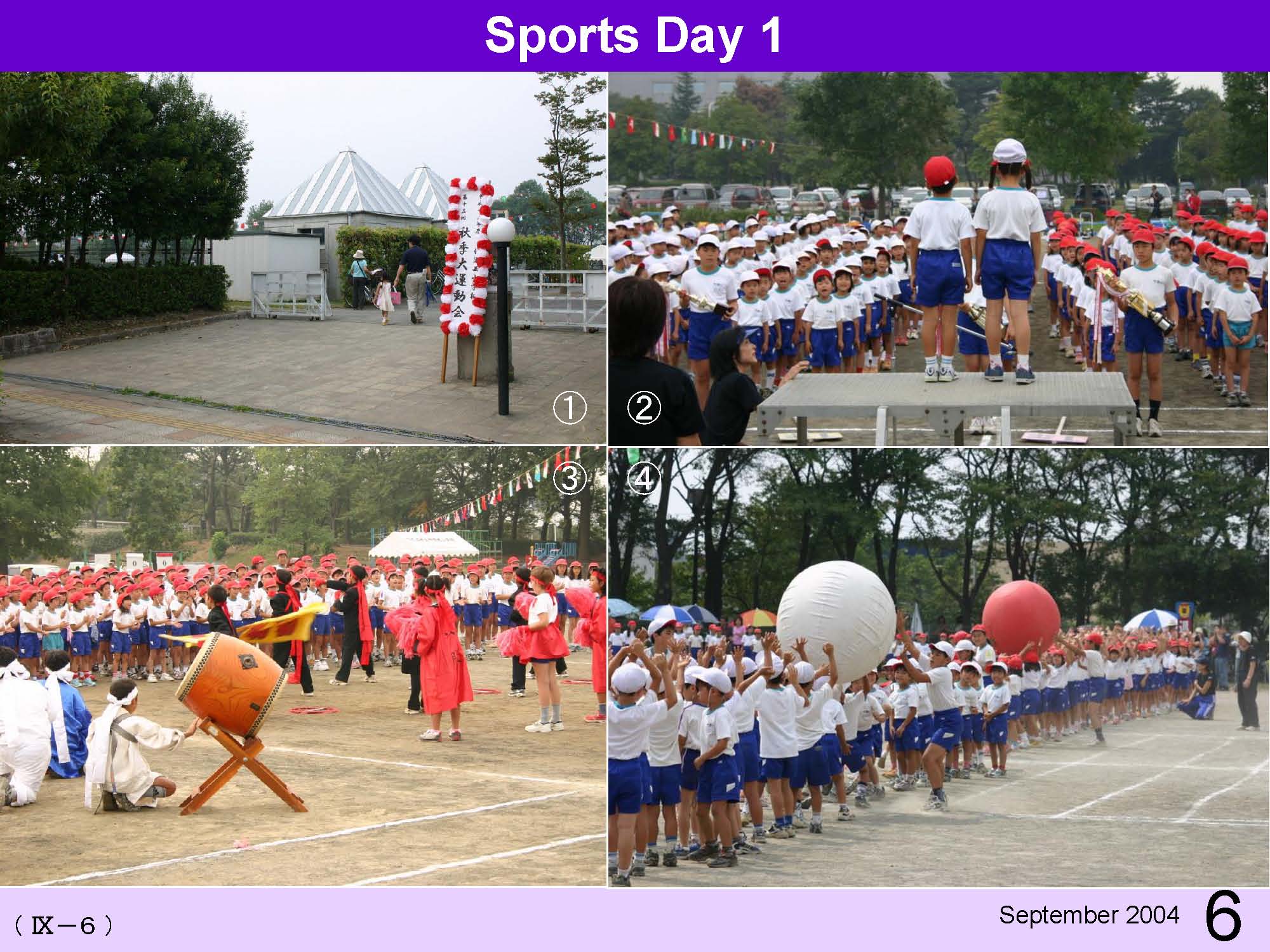 |
①School gate ②Opening ceremony for Sports Day(1st grade) ③Cheering performance ④Team sports All the students join in Sports Day activities (Undokai). |
| 7 | 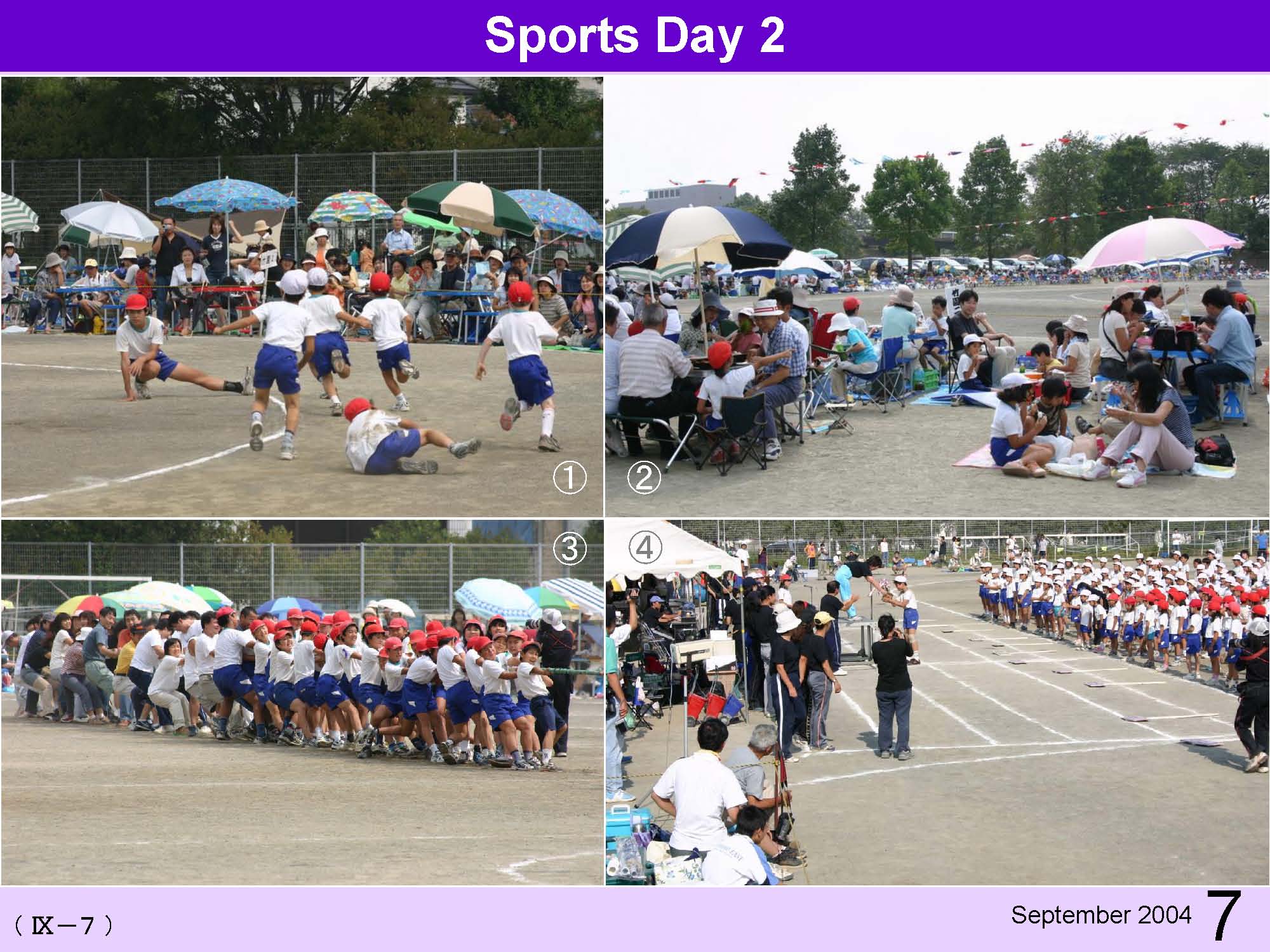 |
①Footrace (1st grade) ②Lunch with students and their family in the school yard ③Playing a tug of war joined by students’ parents (5-6th grade students and their parents) ④Closing ceremony Not only students but also parents and members of the community (including kindergarten infants) and senior citizens participate in the sports activities. |
| 8 | 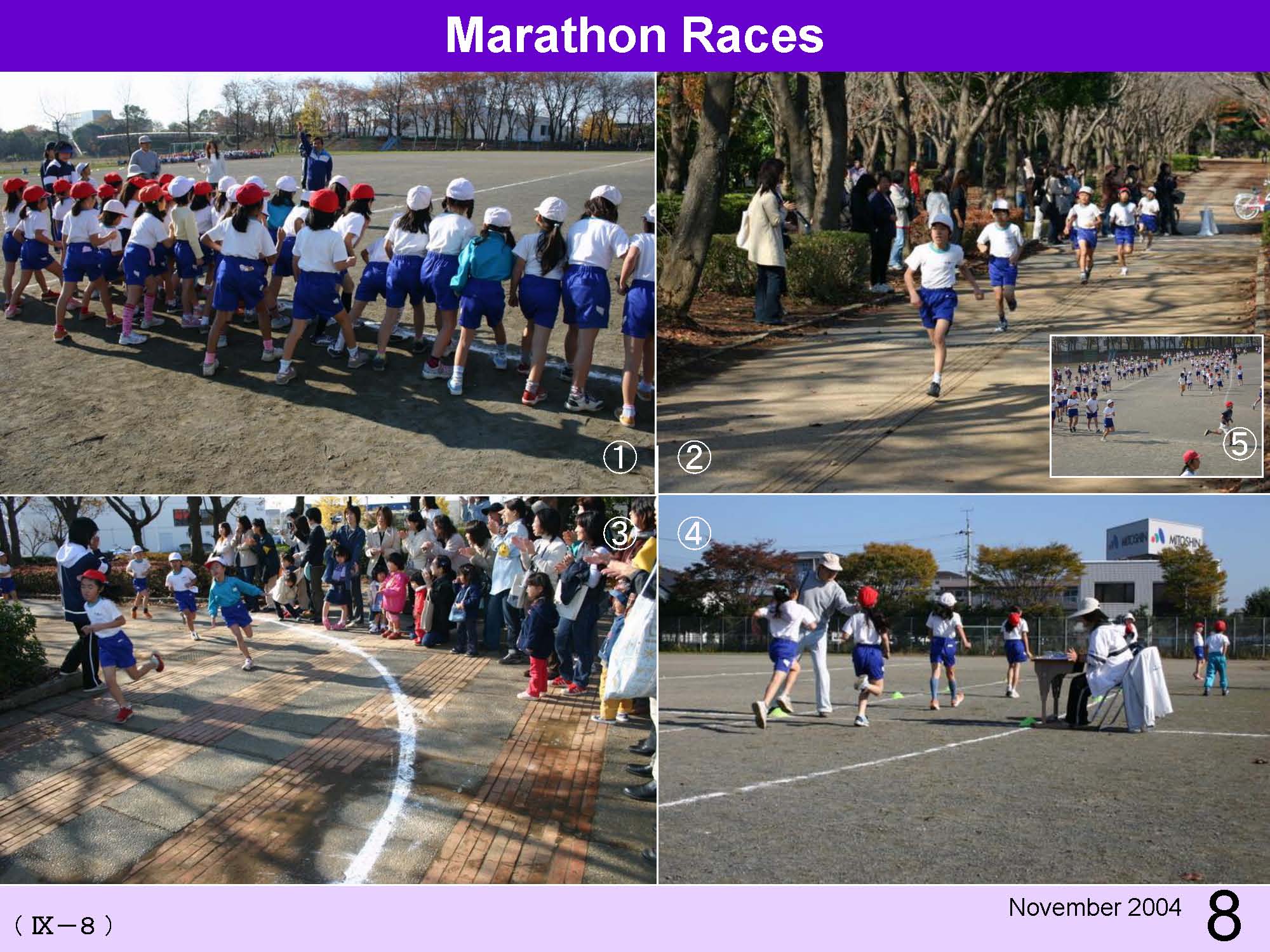 |
①Students are divided into male/female groups in each grade. Students race in this groups. ②The race course extends to areas outside of the school premises. ③Parents are cheering on and supporting their children. ④Teachers are recording the time and place at the finish line. ⑤Students are practicing in recess before the marathon race. |
| 9 | 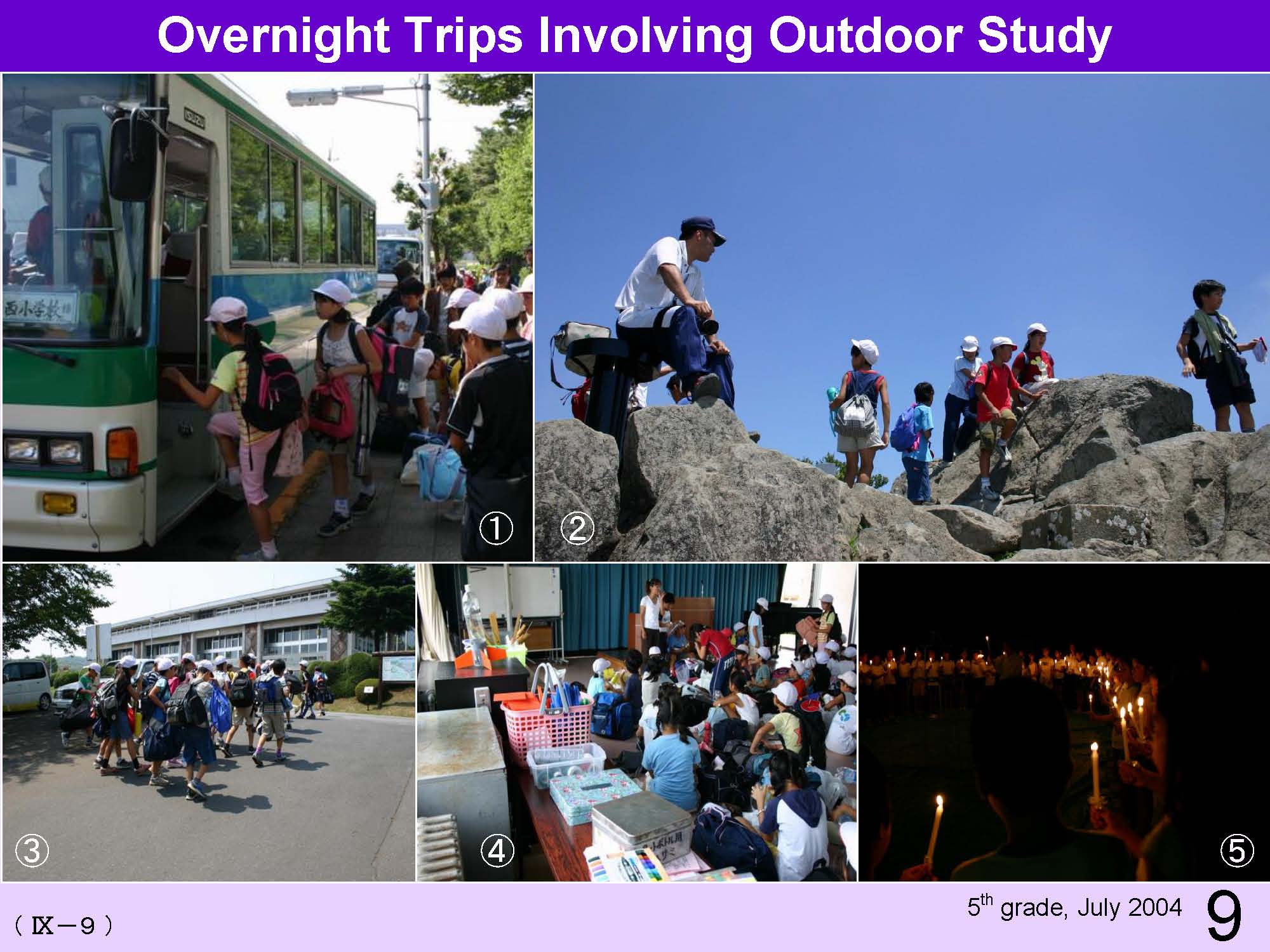 |
①Departure from the school ②Climbing a mountain ③Arrival at a Youth House (a Youth House →Ⅲ-25,26,27,28,29) ④Meeting to introduce the rules for the use of the Youth House ⑤Candle fire ceremony Youth houses (for teenagers) and juvenile houses (for children) set up as social educational facilities are often used for school activities. |
| 10 | 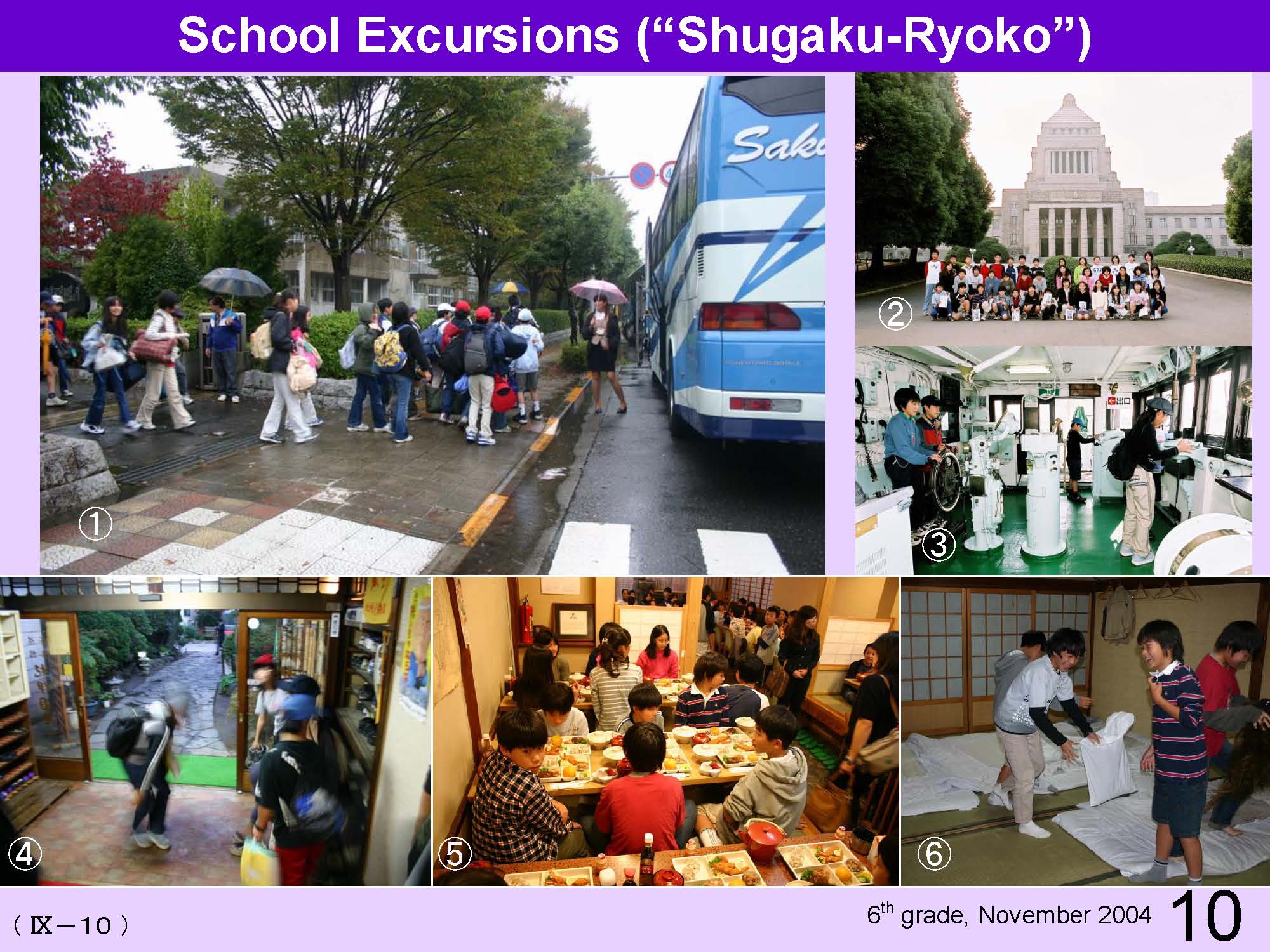 |
①Departure from the school, ②Visitation at the Diet building, ③Visitation at the Ship Museum ④Arrival at an inn, ⑤Eating dinner at the inn ⑥Preparation for sleep Students are taught group discipline while they inspect social facilities and equipment. |
| 11 | 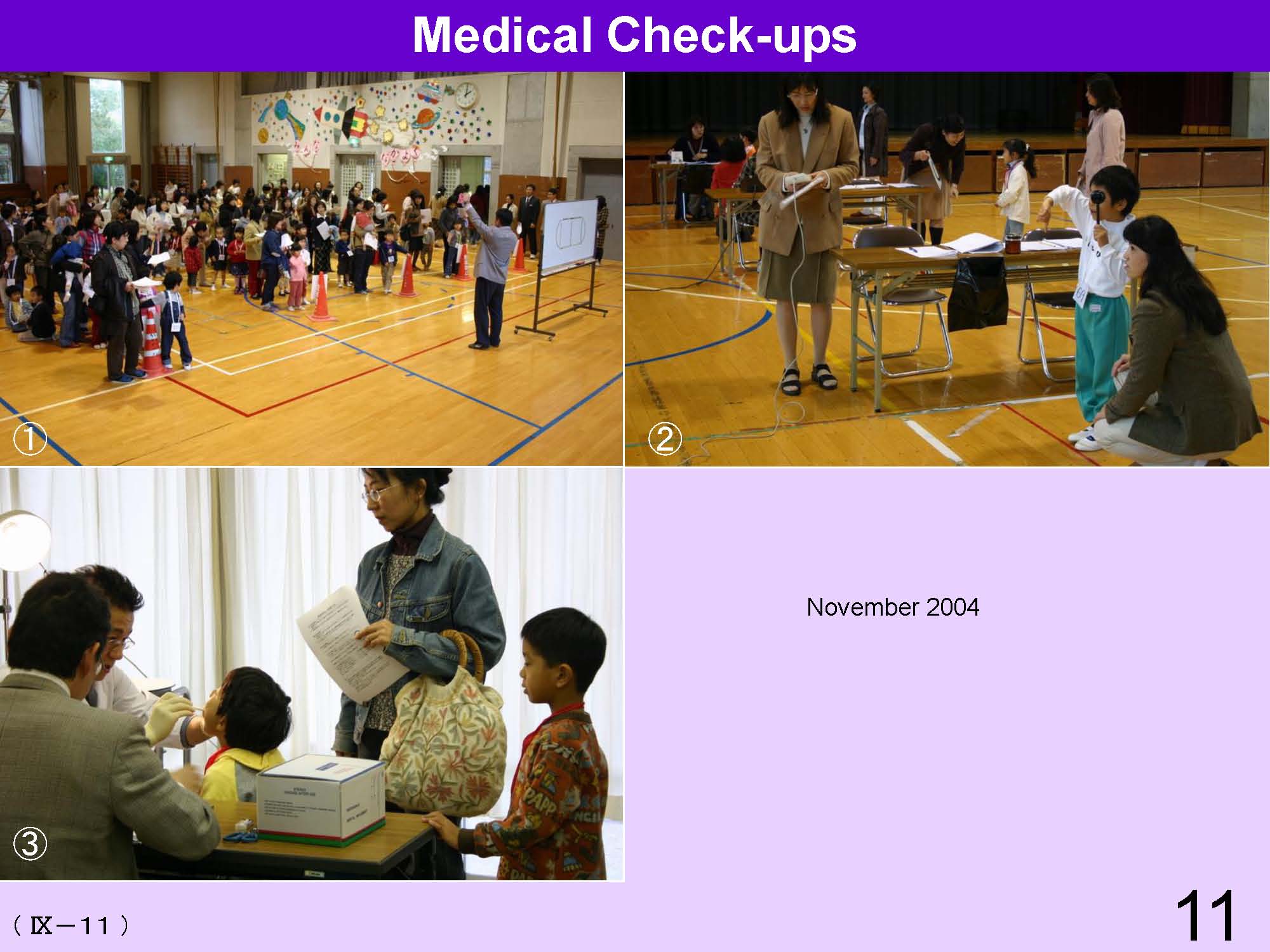 |
A medical check-up is carried out every year for all students. These pictures show the medical check-up for children who are entering this primary school next Spring. ①Explanation at gymnasium ②Ophthalmology checkup ③Dental checkup Daily health consultations and care for the injured and ill are carried out in health care rooms. |
| 12 | 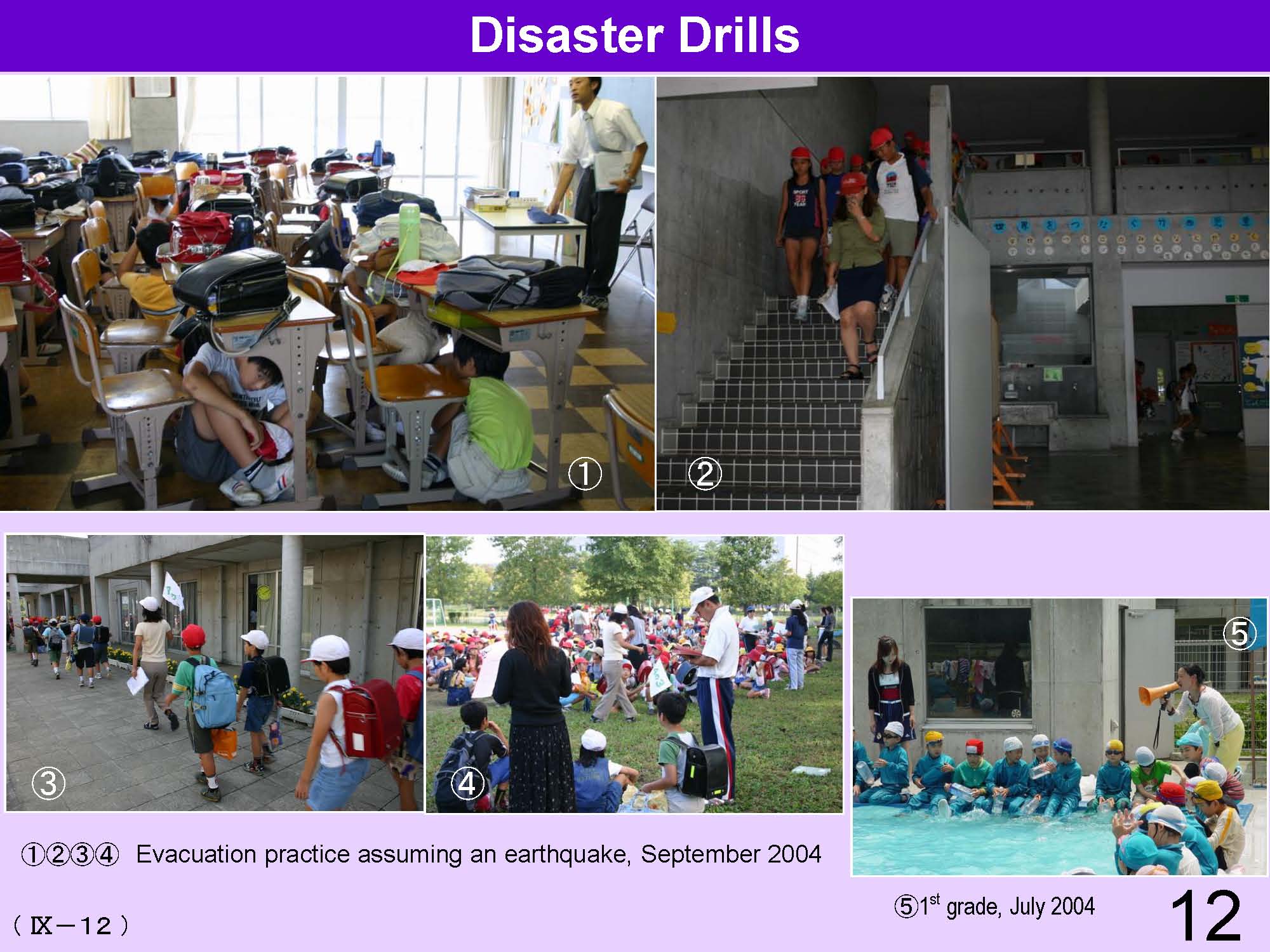 |
①At the end of an evening meeting, there is an announcement that a big earthquake has occurred. Students place themselves under desks, and begin to flee after the earthquake subsides. 6th grade ②③homeroom teachers lead students to the schoolyard. ④ A homeroom teacher is doing a roll call. ⑤Swimming with cloths on Teachers pay close attention to student safety in their school life. |
| 13 | 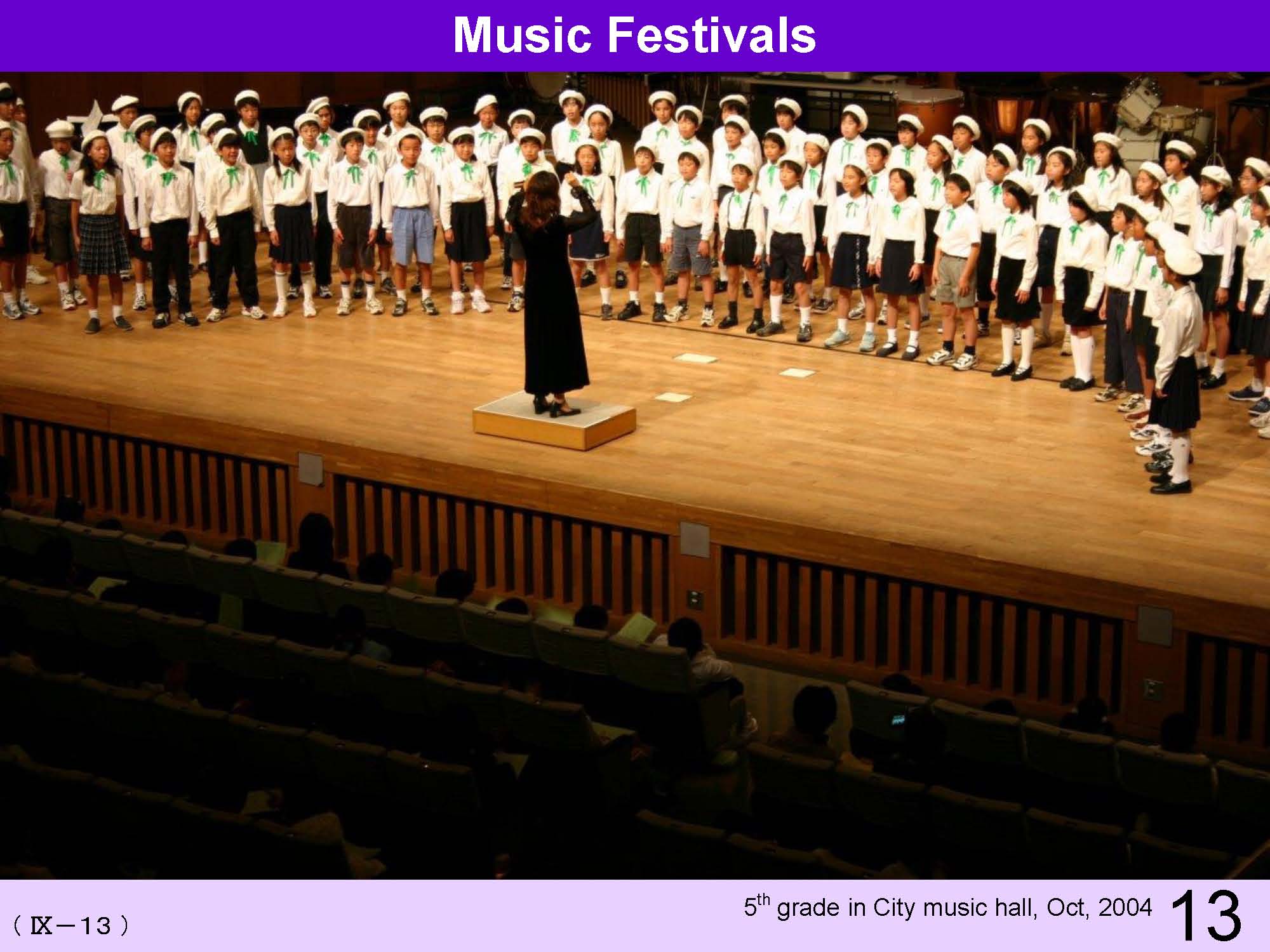 |
A primary and lower secondary concert is held by the Municipal Board of Education. |
| 14 | 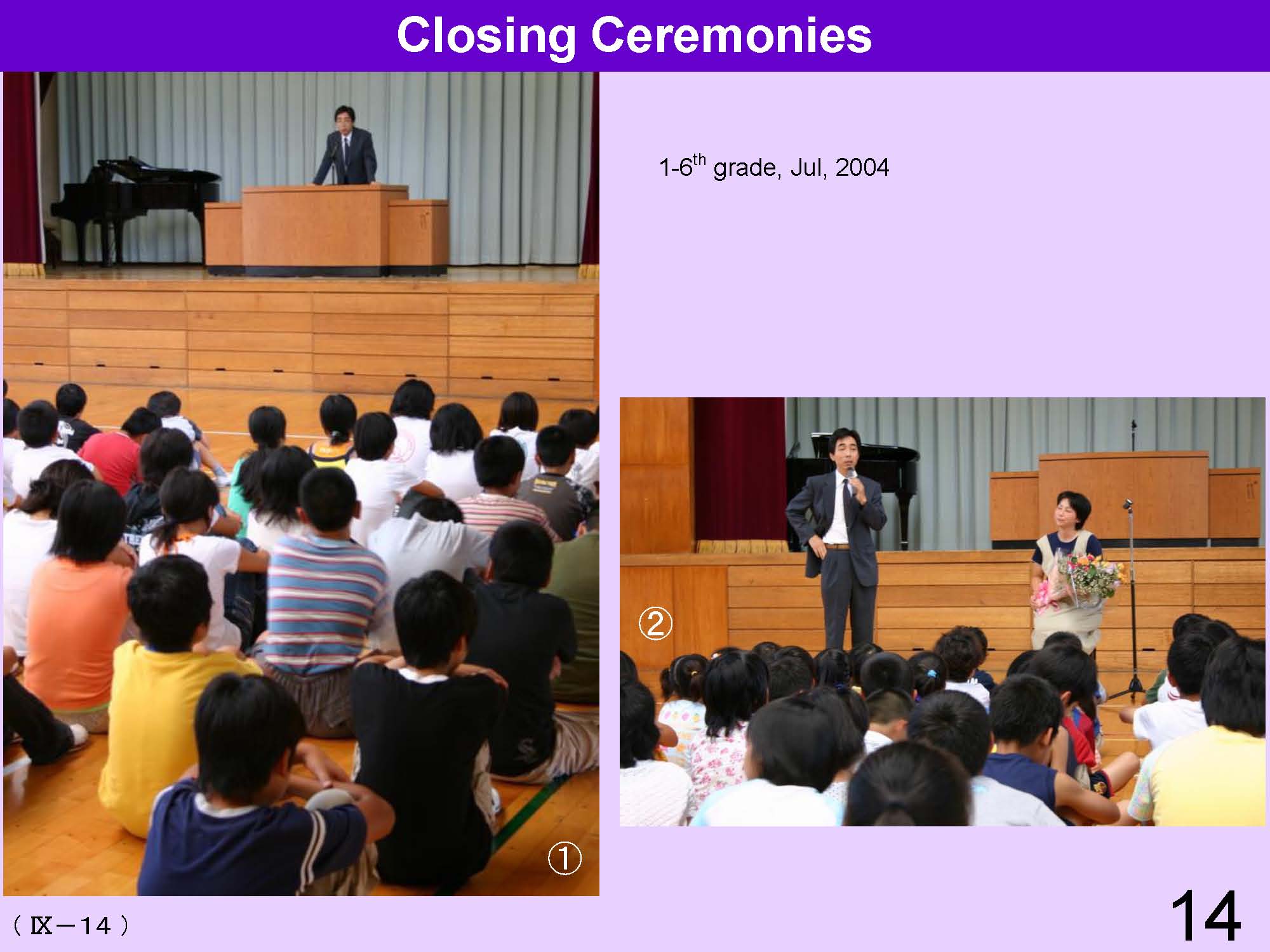 |
①A speech by the principal ②A farewell speech to a teacher who is taking maternity leave |
| 15 | 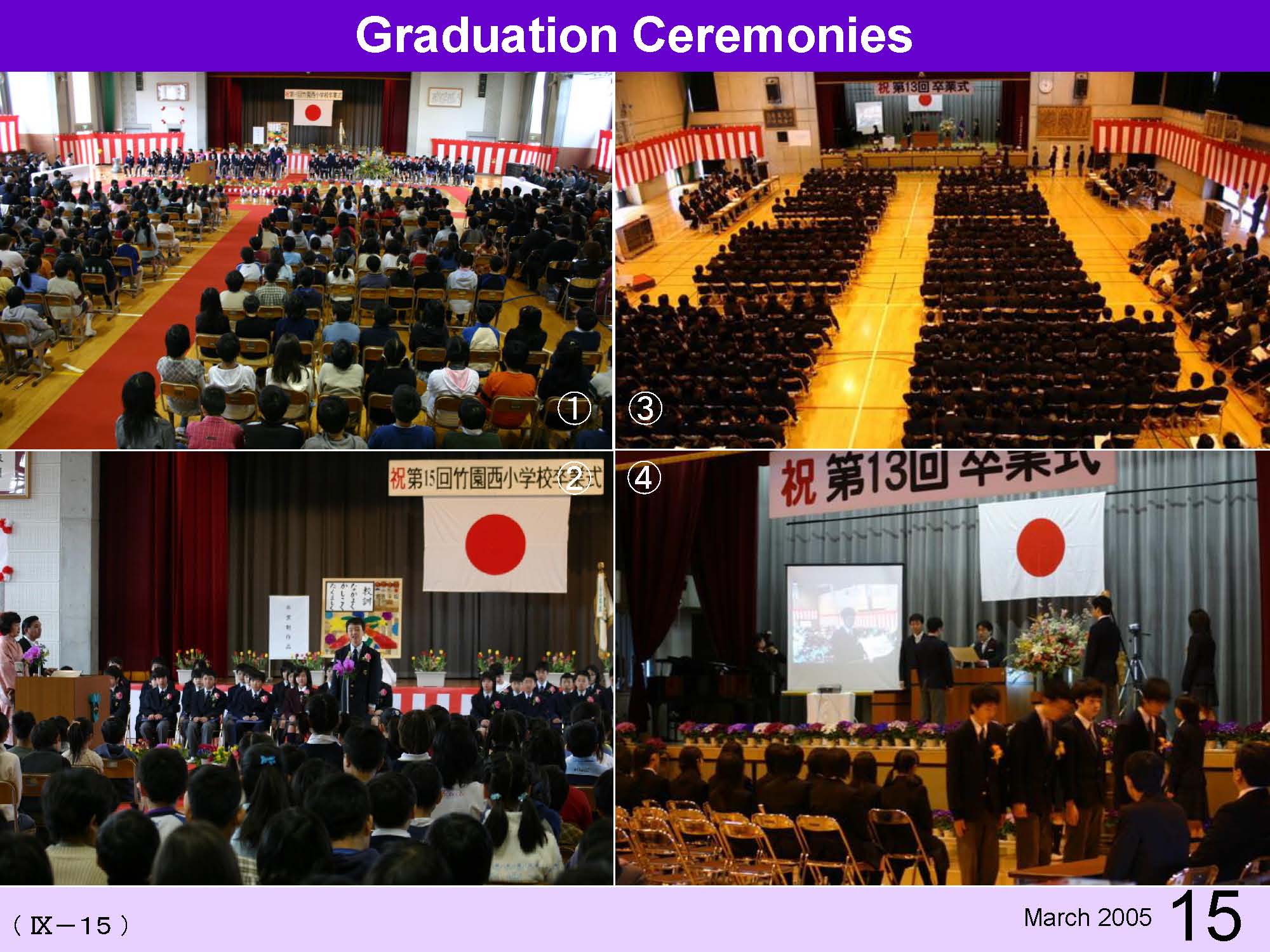 |
①②Graduation ceremony at a primary school ③④Graduation ceremony at a lower secondary schoolb The graduation ceremony is the biggest all school events. It illustrates the characteristics of school life by encouraging students’ parents to participate in the event. |
| 16 | 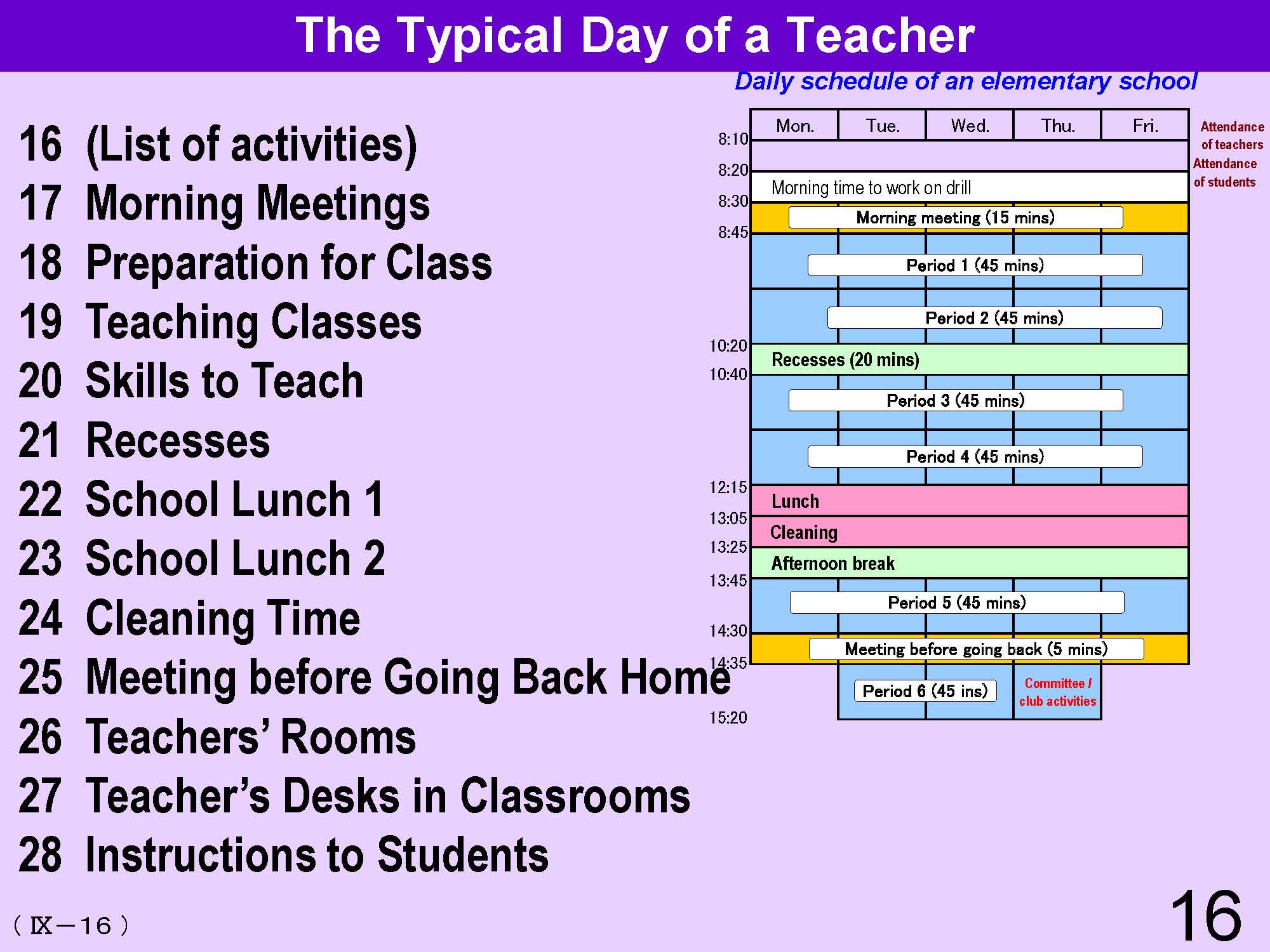 |
Teachers are responsible not only for instruction of subjects, but also for various types of student guidance. |
| 17 | 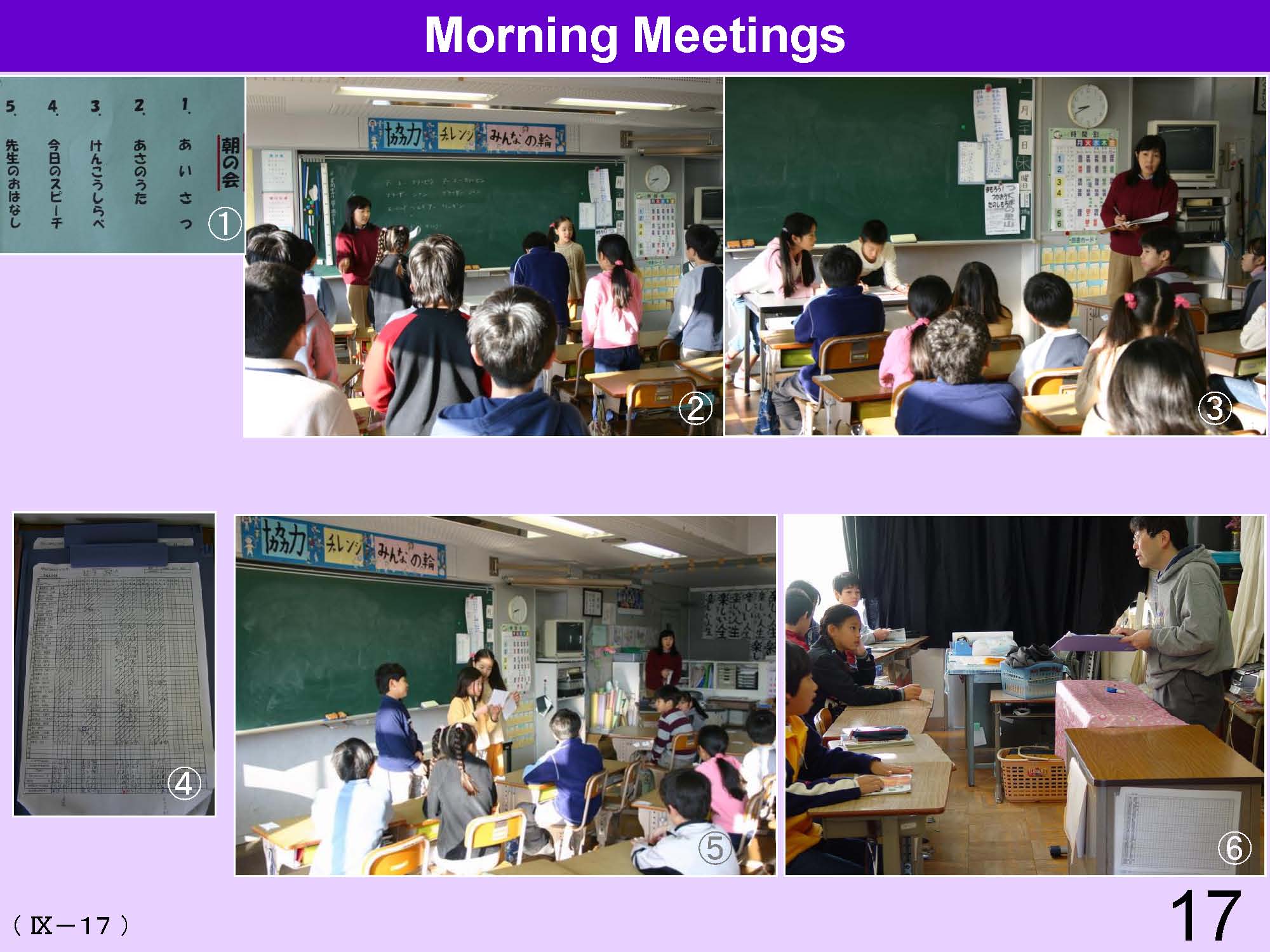 |
①The time schedule for a morning meeting, ②Morning song sung by the students, 4th grade ③A hygiene check up, 4th grade, ④A hygiene check note ⑤A one minute speech by the students, 4th grade ⑥A hygiene check up, 6th grade |
| 18 | 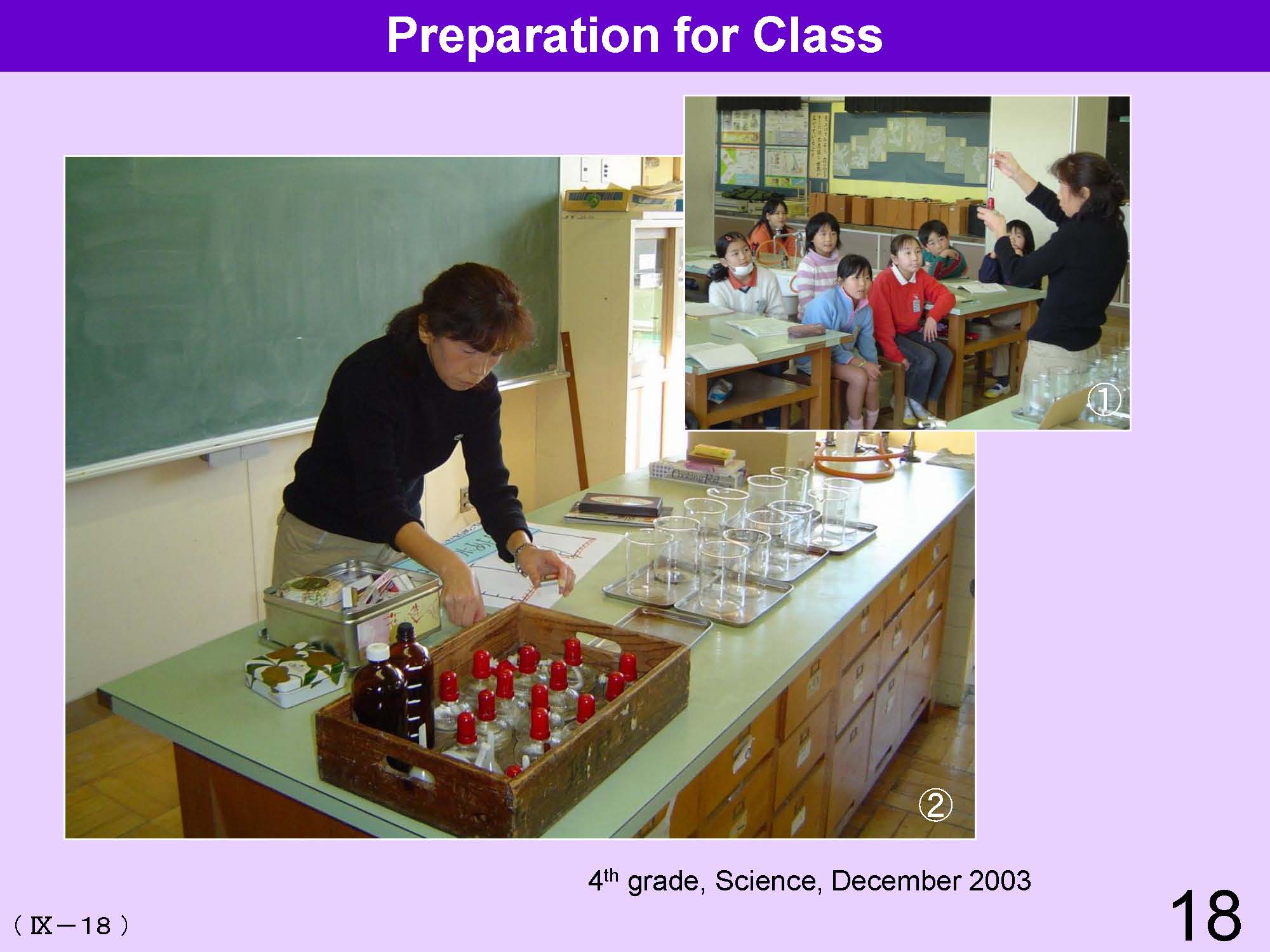 |
①A science class at the science room ②Preparation for a science class Before teaching a class teachers prepare well with teaching aids and experimental equipment. |
| 19 | 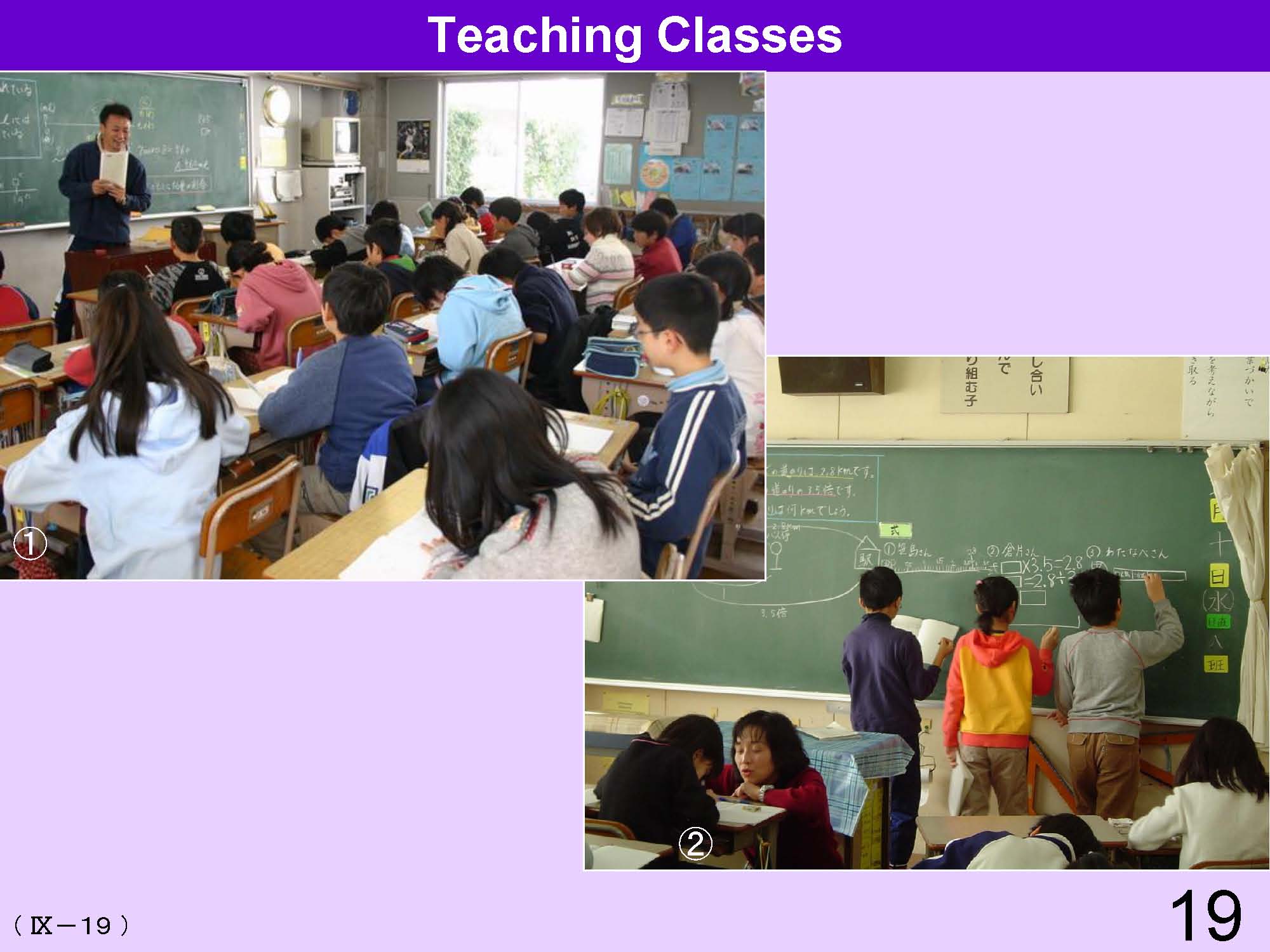 |
Teachers devise their teaching approach. Teachers teach students in a friendly manner. A teacher prepares a lesson plan. ①Arithmetic, 5th grade, January 2005 ②Arithmetic, 1st grade, December 2003 |
| 20 | 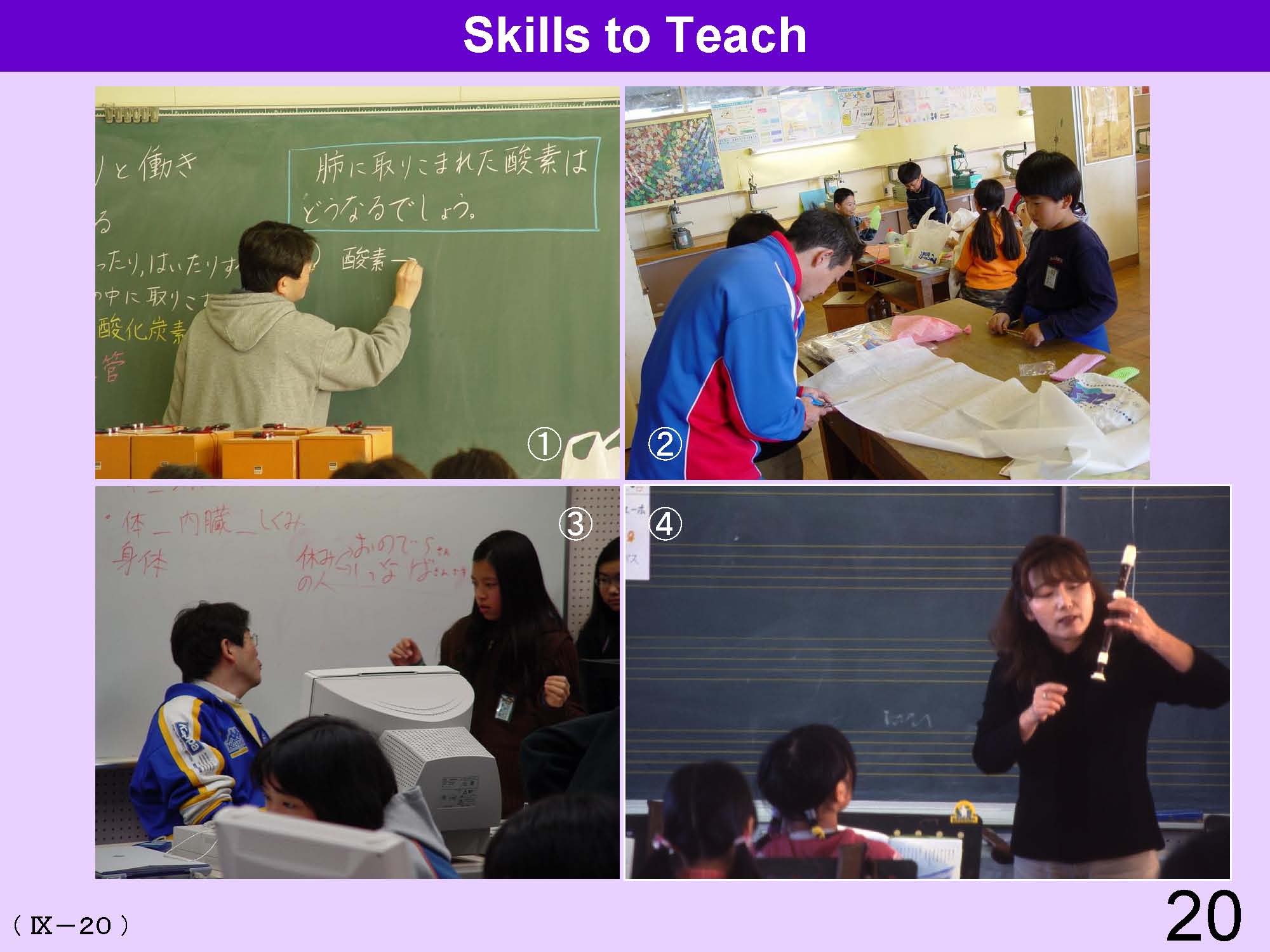 |
It is necessary for teachers to utilize various teaching aids and a computer. Teachers prepare various devices for use as teaching aids. ①Blackboard, science, 6th grade, December 2003 ②Scissors, drawing & handcraft, 3rd grade, December 2003 ③Computer, the period of integrated study, 6th grade, December 2003 ④Musical instrument, Music, 6th grade, December 2003 |
| 21 | 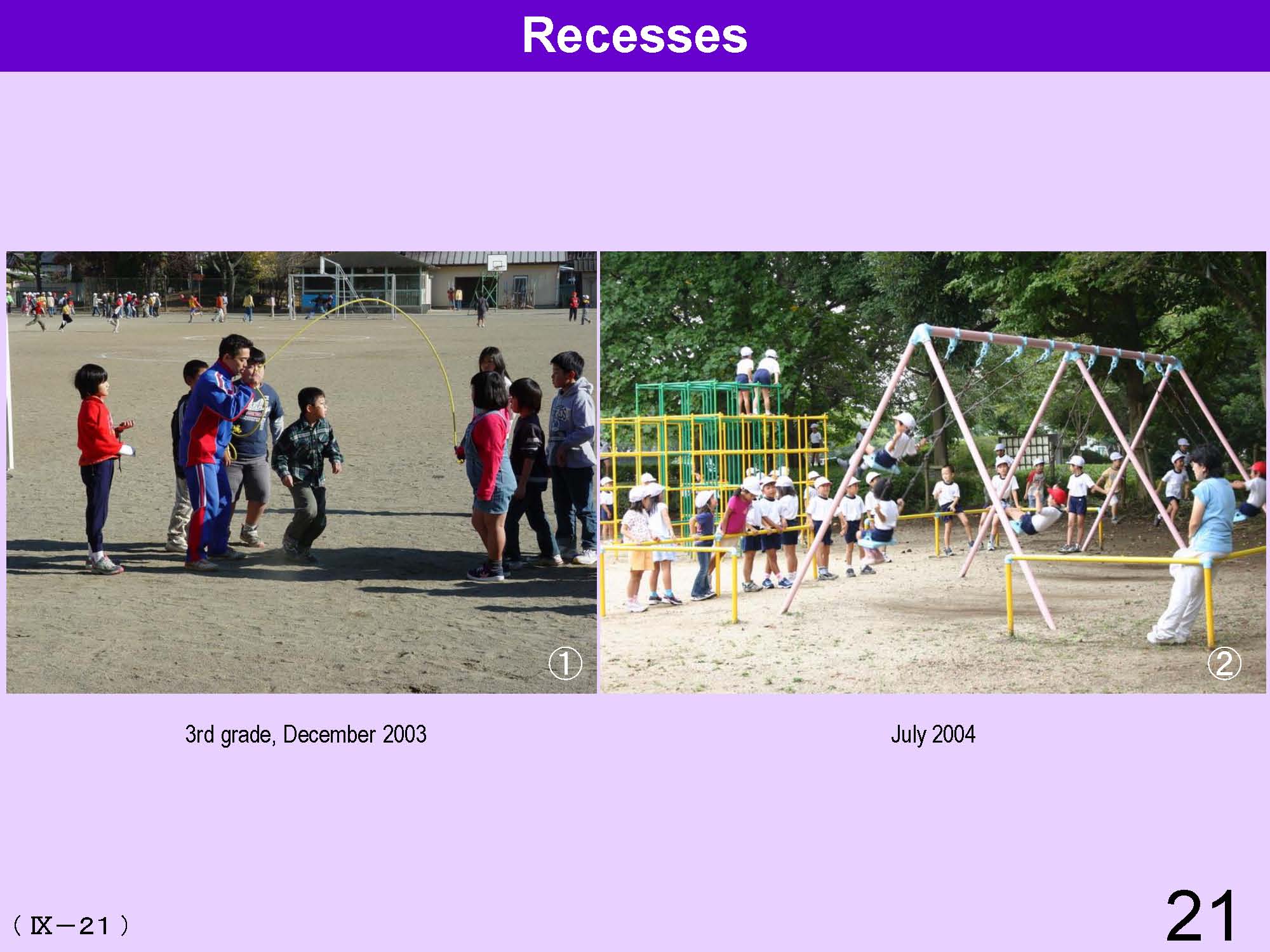 |
A long recess (between 2nd and 3rd periods) and a recess after lunch is usually 20 minutes long, so students can play in the school-yard. Teachers will participate with the playing groups and are vigilant about safety. ①The teacher is playing with students. ②The teacher is watching students’ play. |
| 22 | 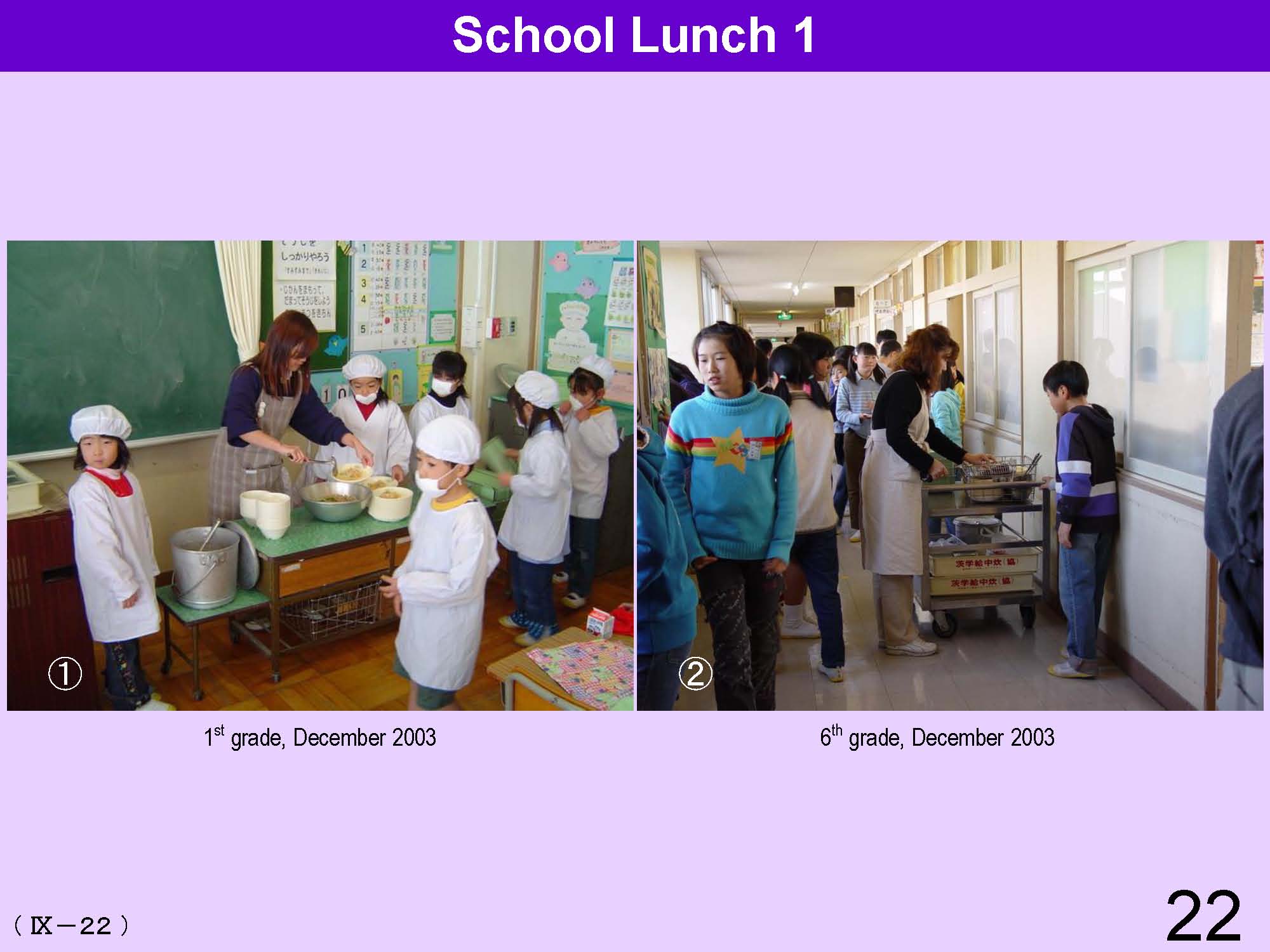 |
In the course of study it is explained that desirable habits should be developed among students through and during the school lunch programs. ①The teacher is helping students serve meals. |
| 23 | 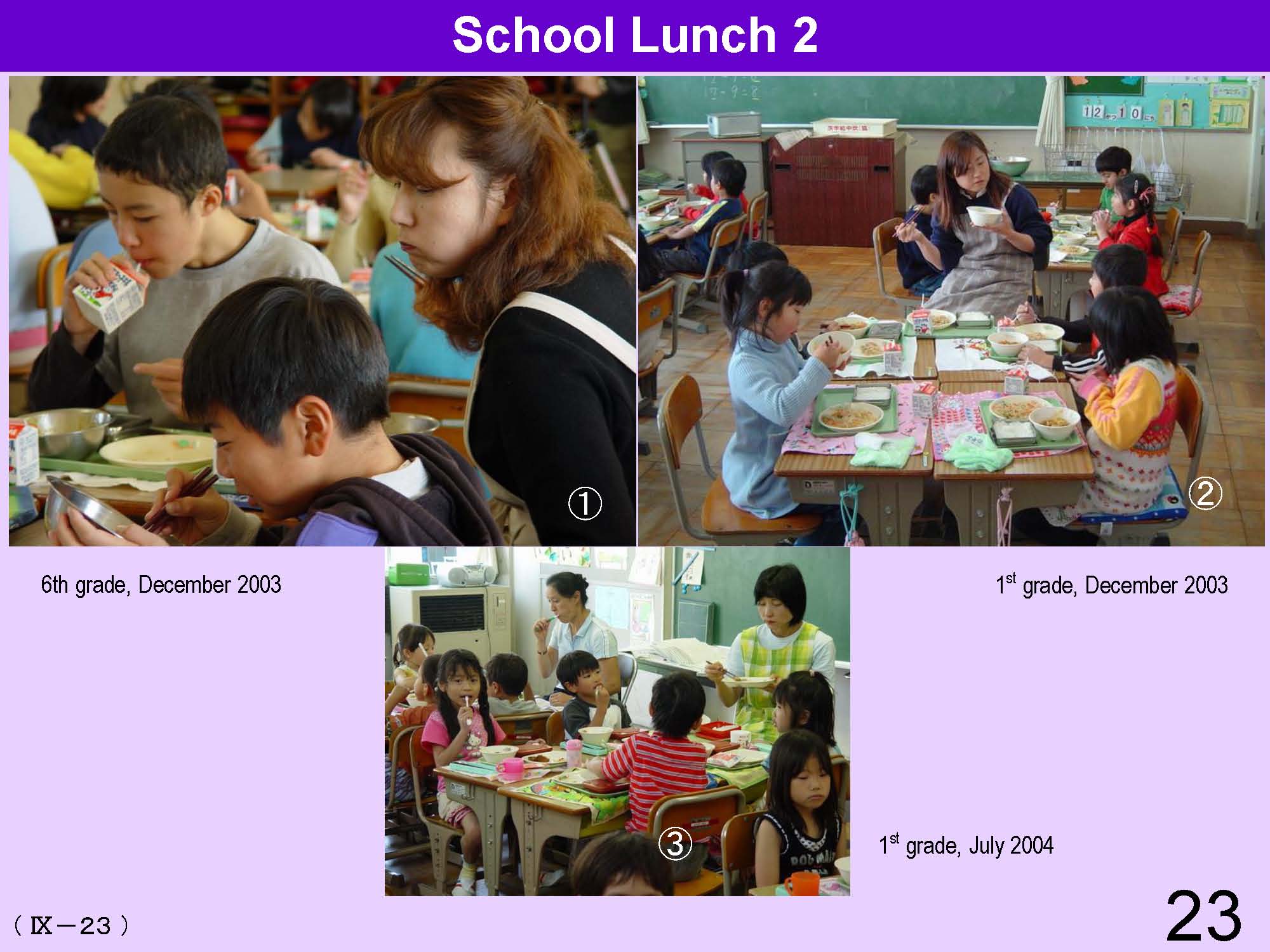 |
①②Having lunch with students ③Brushing teeth with students At lunch time the teachers take their meals together with the students of their classes. School lunch periods are regarded as an educational activity. |
| 24 | 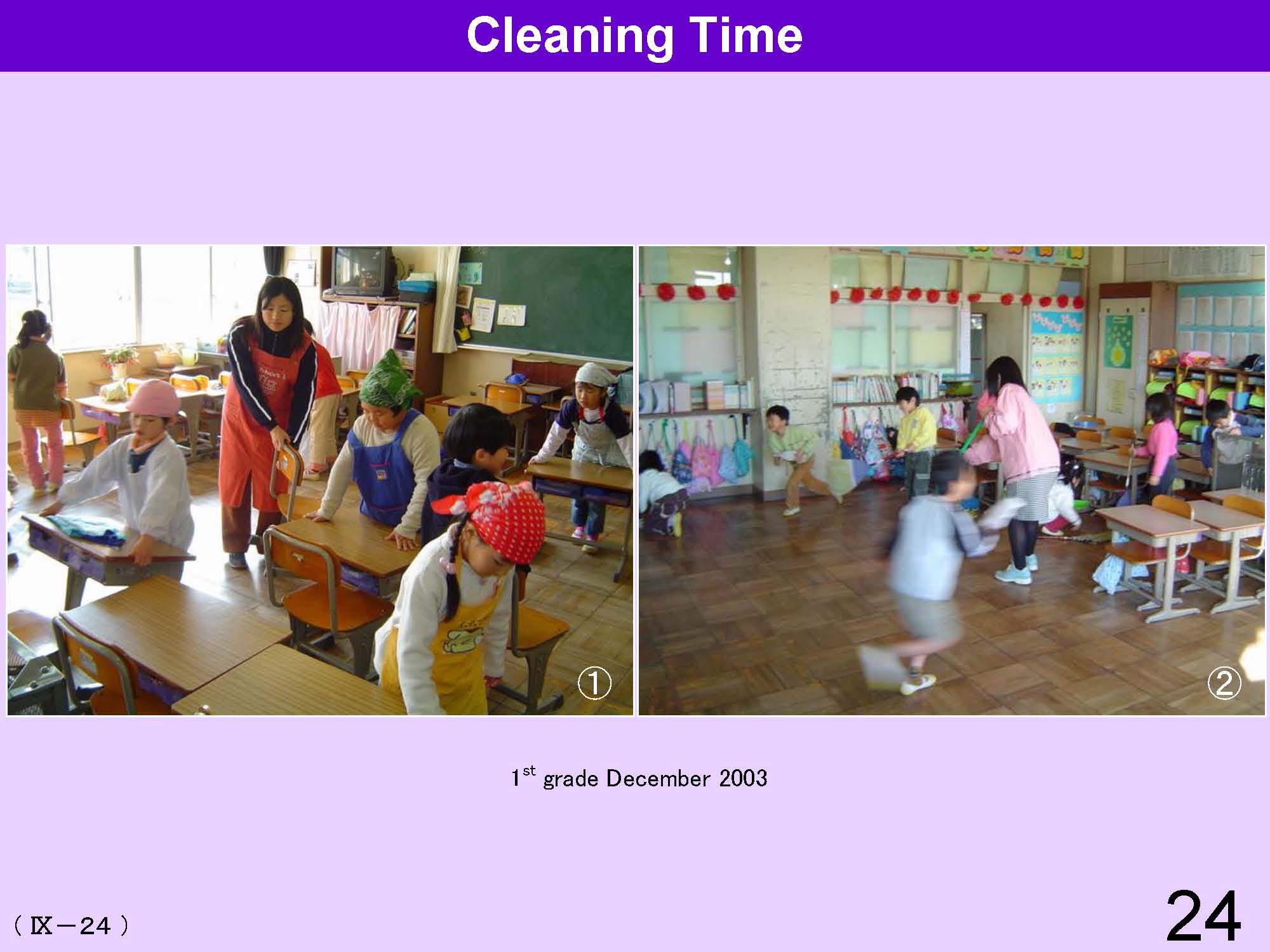 |
①②Teachers are helping students with cleaning. |
| 25 | 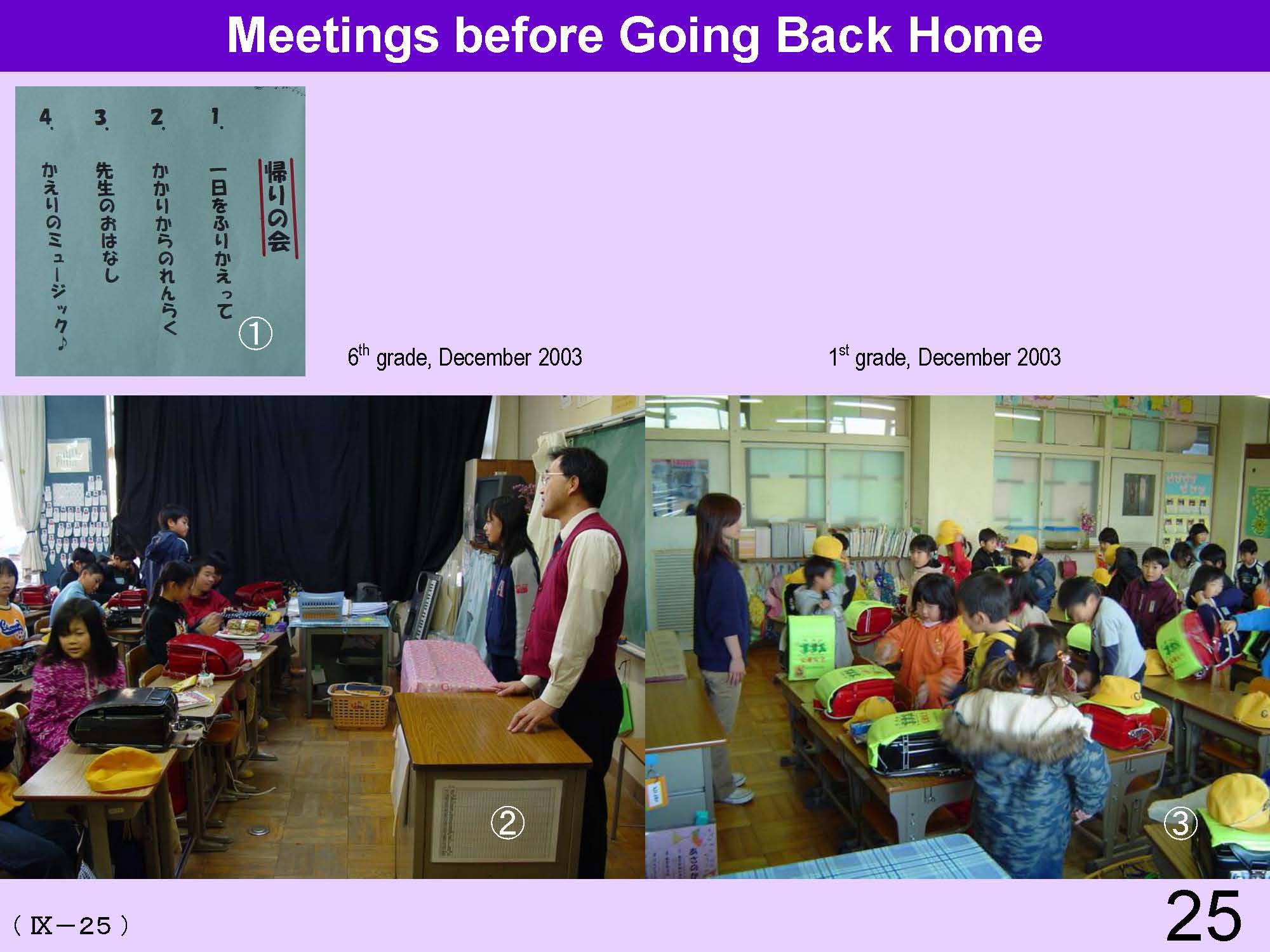 |
①Time schedule for an evening meeting ②Information from a student responsible for tasks ③Greeting |
| 26 | 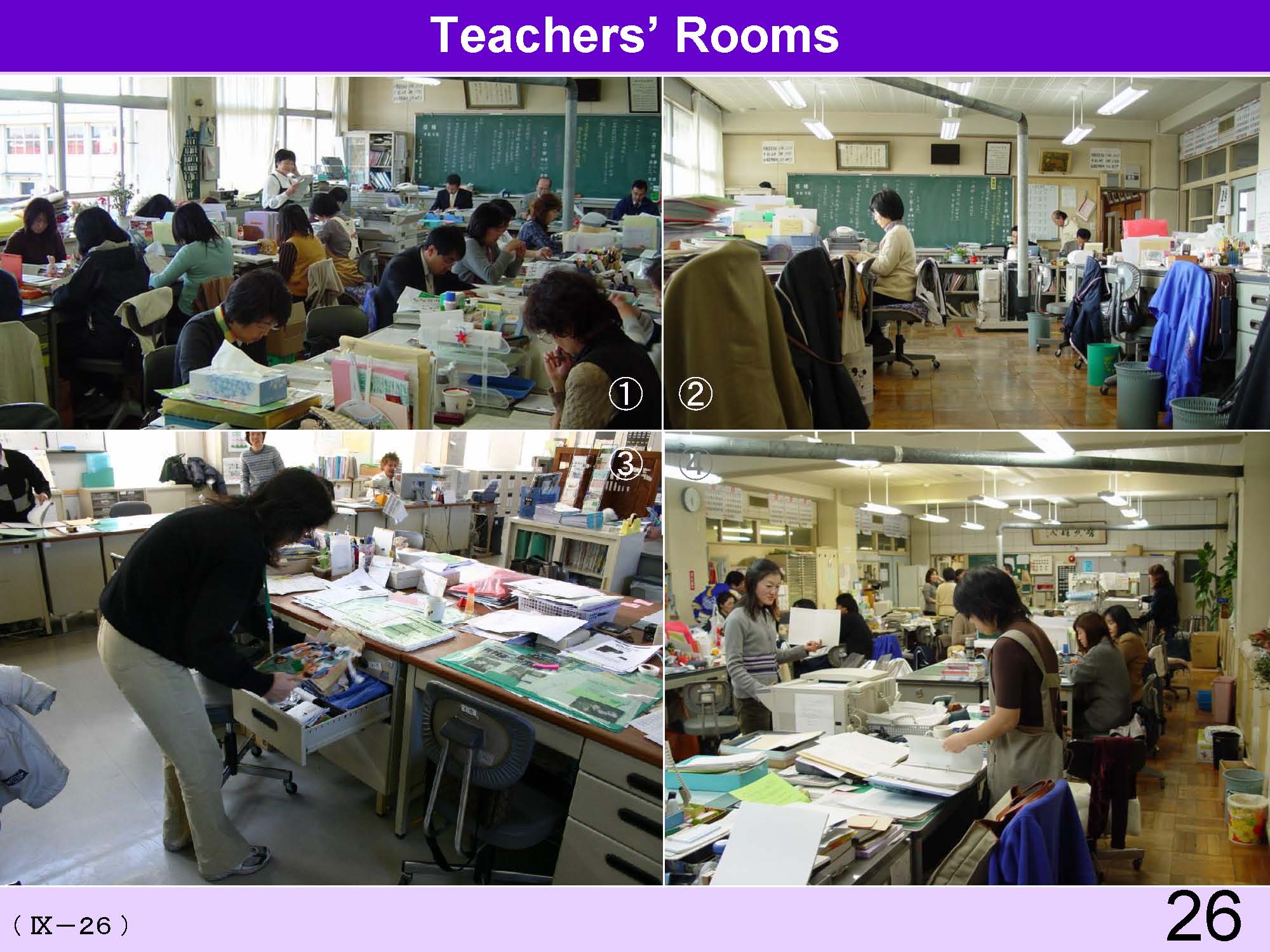 |
①Student guidance meeting, February 2004 ②Class hour, December 2003 ③A teacher at her own desk in the teacher’s room, February 2005 ④Teachers still at school. December 2003 In each Japanese school there are teacher’s rooms where teachers’ desks are arranged. At their desks teachers prepare for teaching subjects and other educational programs. Educational counseling is also conducted in these rooms. Teachers’ meetings are also held in the teachers rooms. |
| 27 | 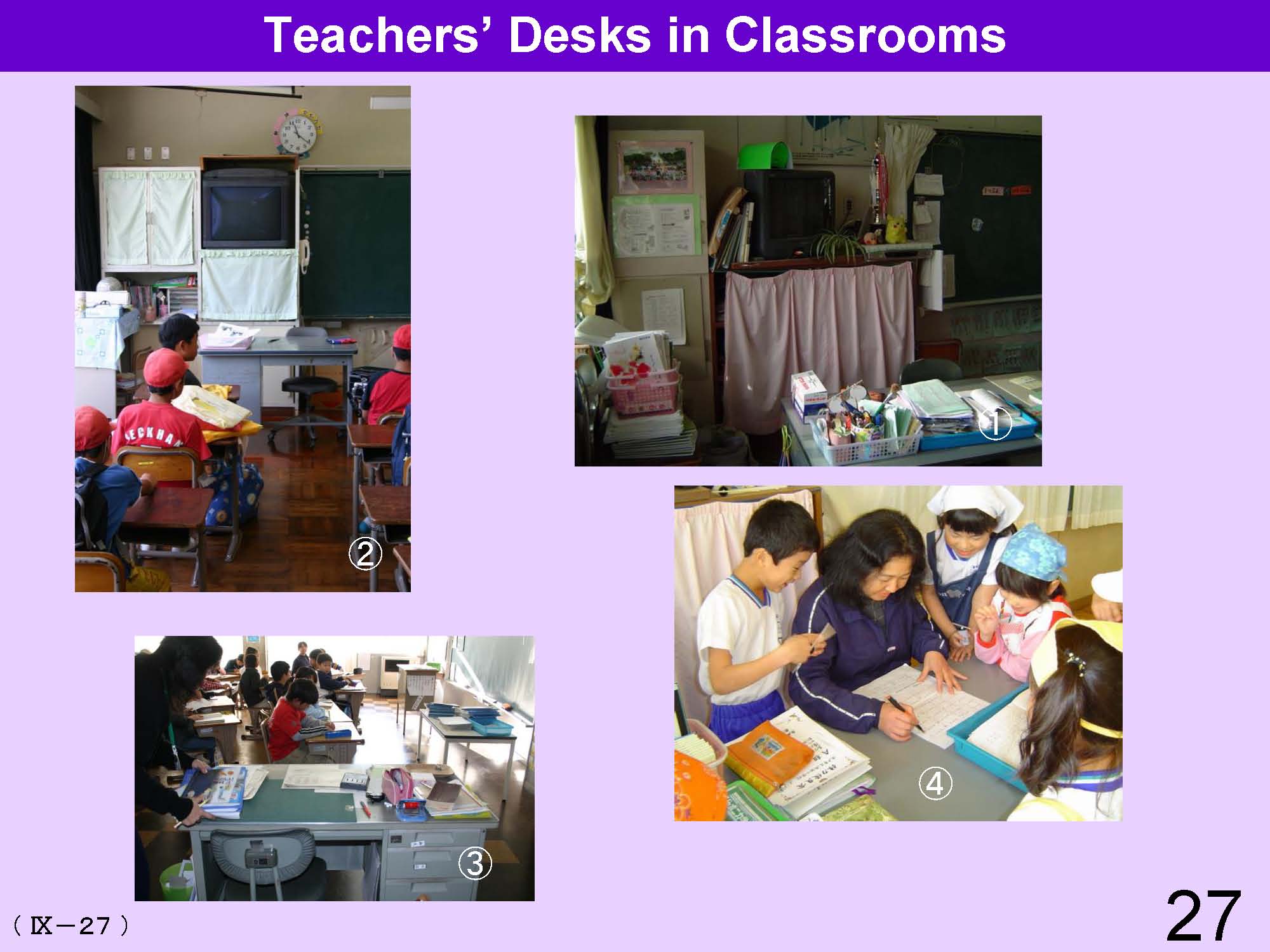 |
①② July 2004 ③Teachers’ desks in classrooms, 4th grade February 2005 ④Checking students’ notebooks at at a teacher’s desk in her classroom, Arithmetic 2nd grade, December 2003 |
| 28 | 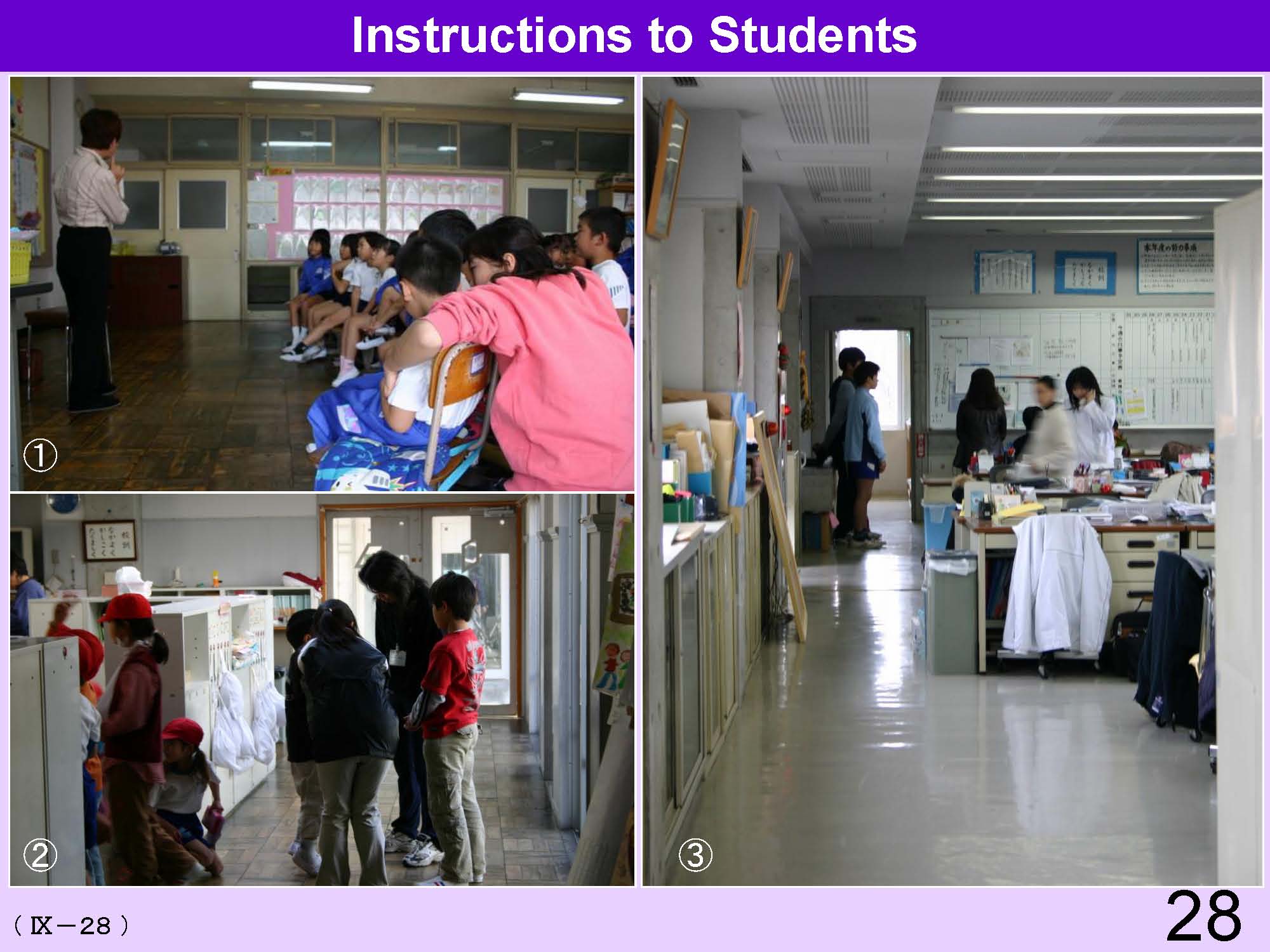 |
①A homeroom teacher is cautioning a student who is talking with his friend in class.. 2nd grade, November 2004 ②Teachers are examining the cause of trouble between students from different grades. 1st and 4th grade, January 2005 ③Teachers are directing students in the teachers’ room. 6th grade, February 2005 (Guidance meeting →Ⅴ-38) A home room teacher takes charge of educational counseling. For students guidance teachers provide academic and life guidance. |
| 29 | 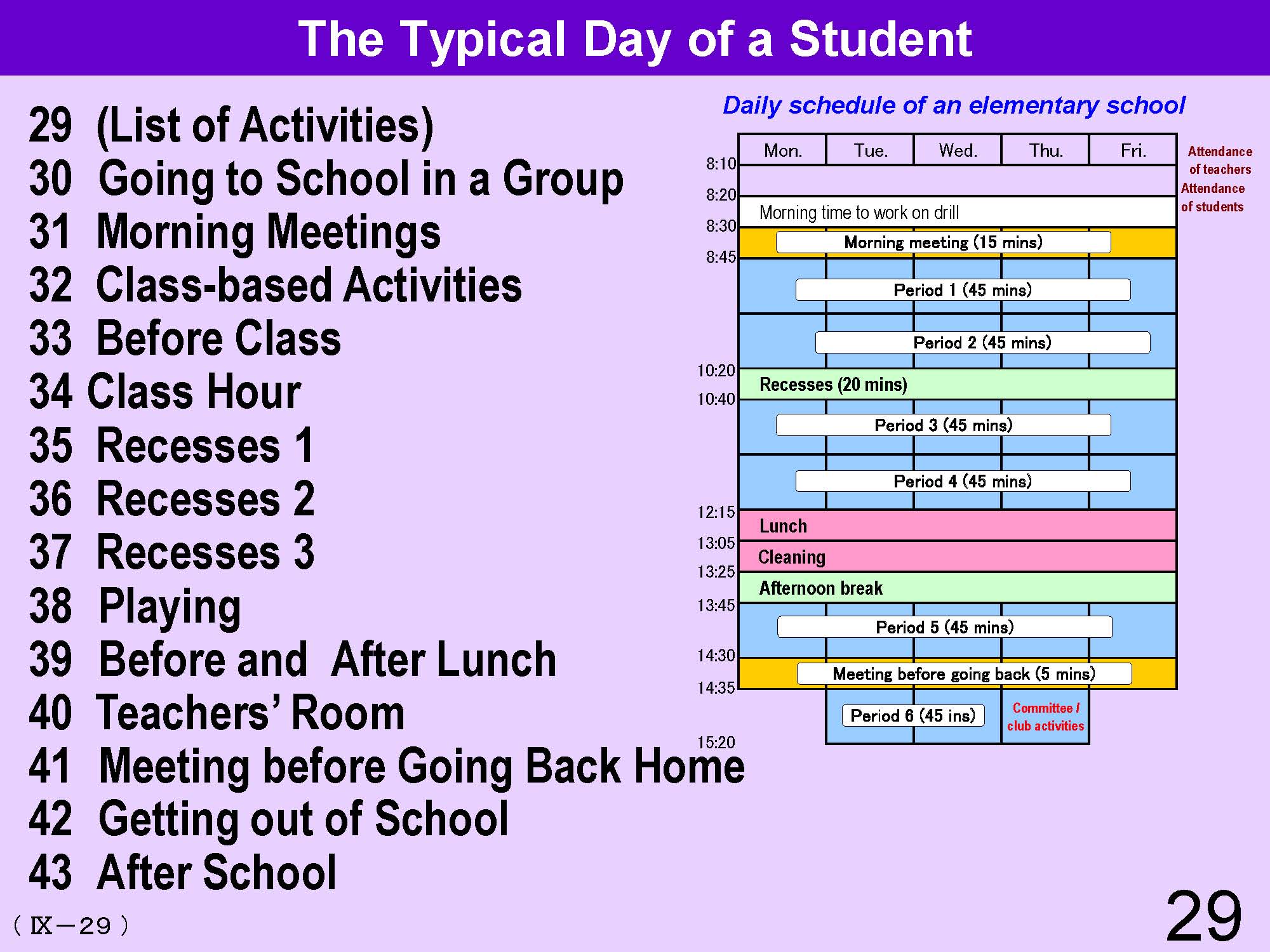 |
Teachers and students share the same time table in a class room. Students not only study and perform tasks given by teachers, but also derive their own pleasure and meaning from the activities. |
| 30 | 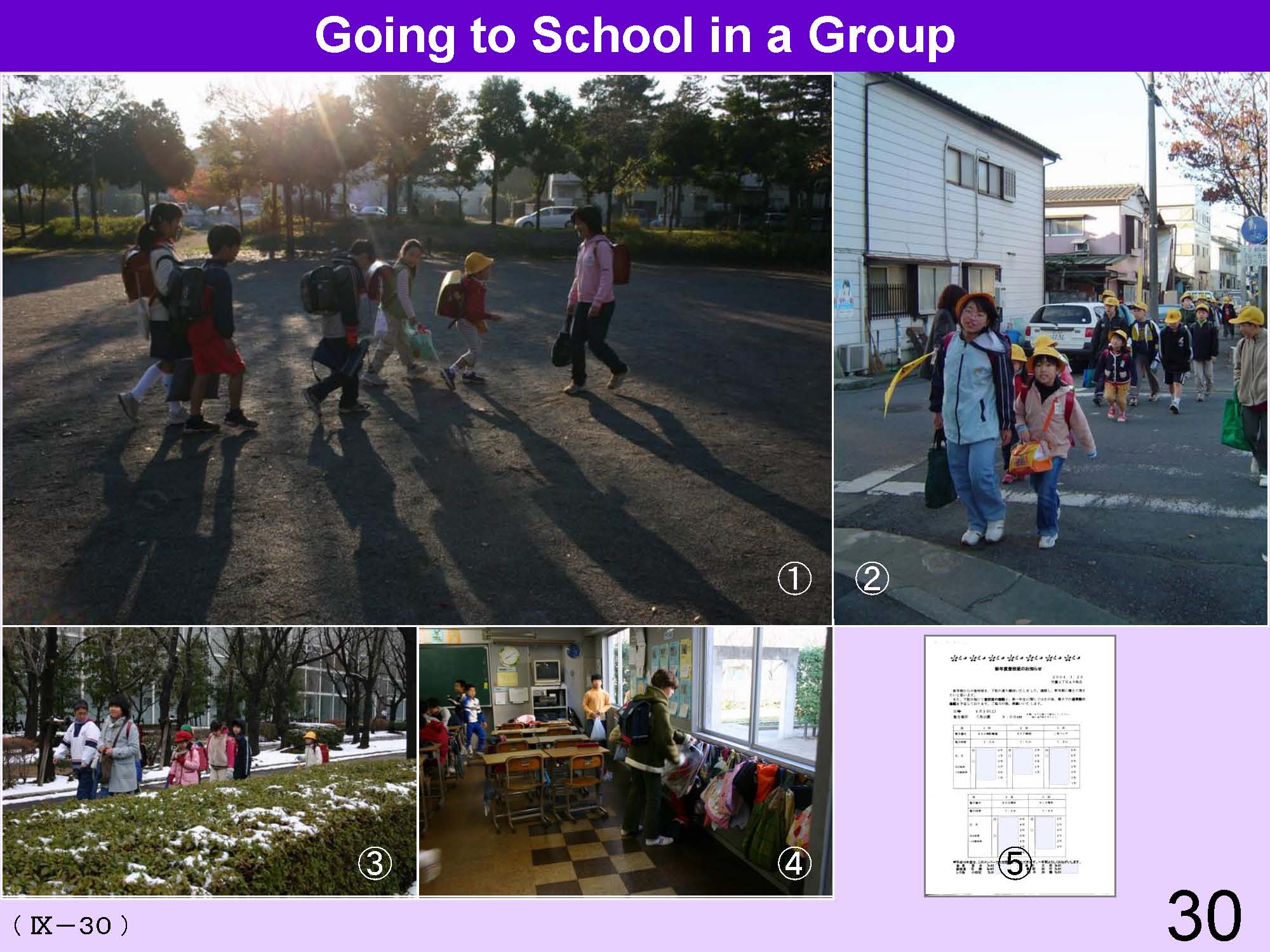 |
①Going to school in a group, November 2004, ② Going to school in a group, December 2003, ③ Going to school in a group, February 2005, ④Storing their own bags in a fixed place, 5th grade, November 2004 ⑤A list of students who will go to school together made by “Kodomokai” Students learn about group discipline and safety by going to school in a group. |
| 31 | 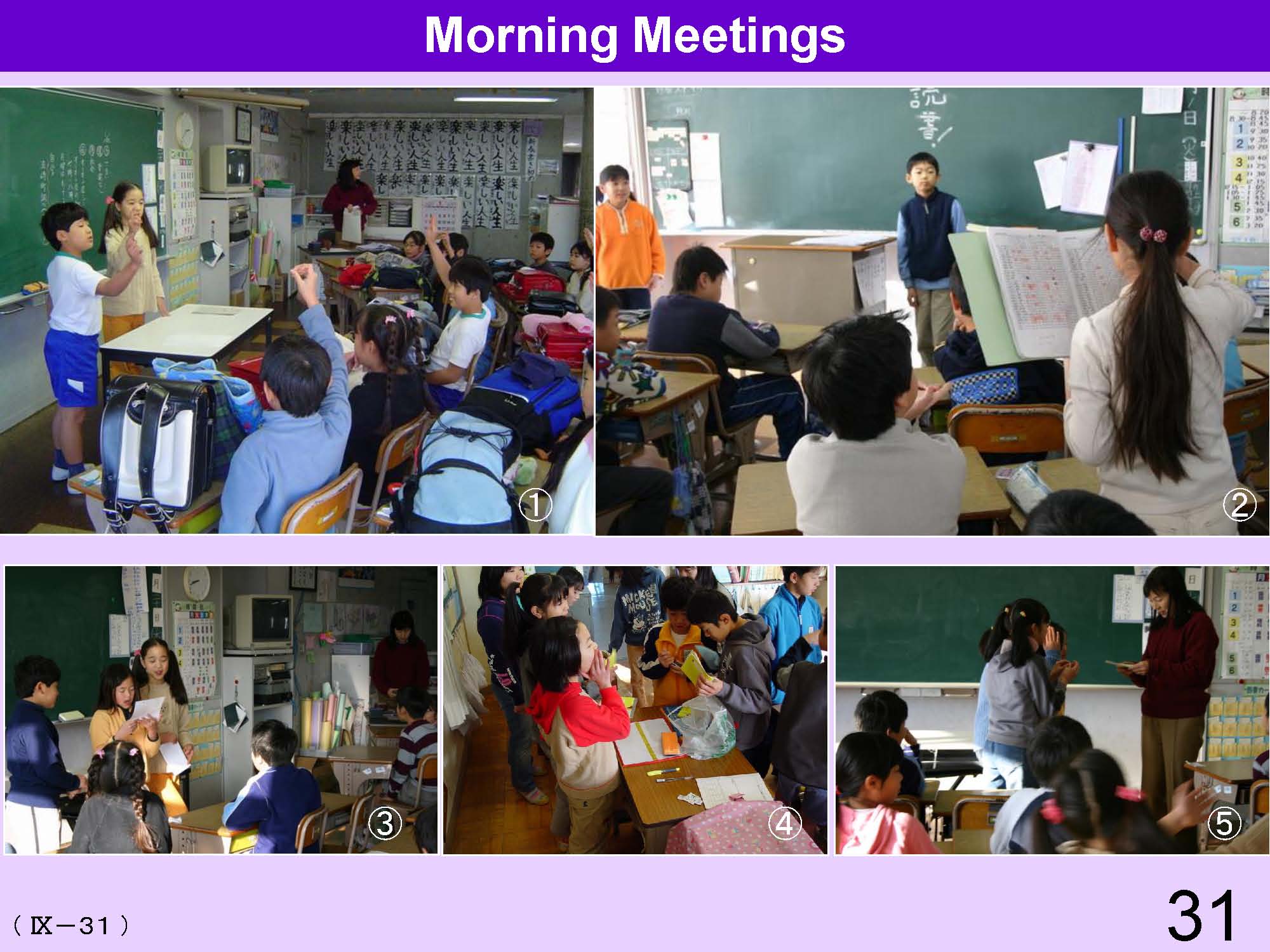 |
①A pair of students are chairing a morning meeting, 4th grade, January 2005 ②Information from a student responsible for tasks, 4th grade, February 2005 ③One minute speech by students, 4th grade, February 2005 ④Collecting money for “the Children Bank”, December 2003 ⑤6th grade students handing a birthday card to their homeroom teacher, 4th grade, February 2005 (Class activities, Group activities, Day duty →Ⅴ-7~9) |
| 32 | 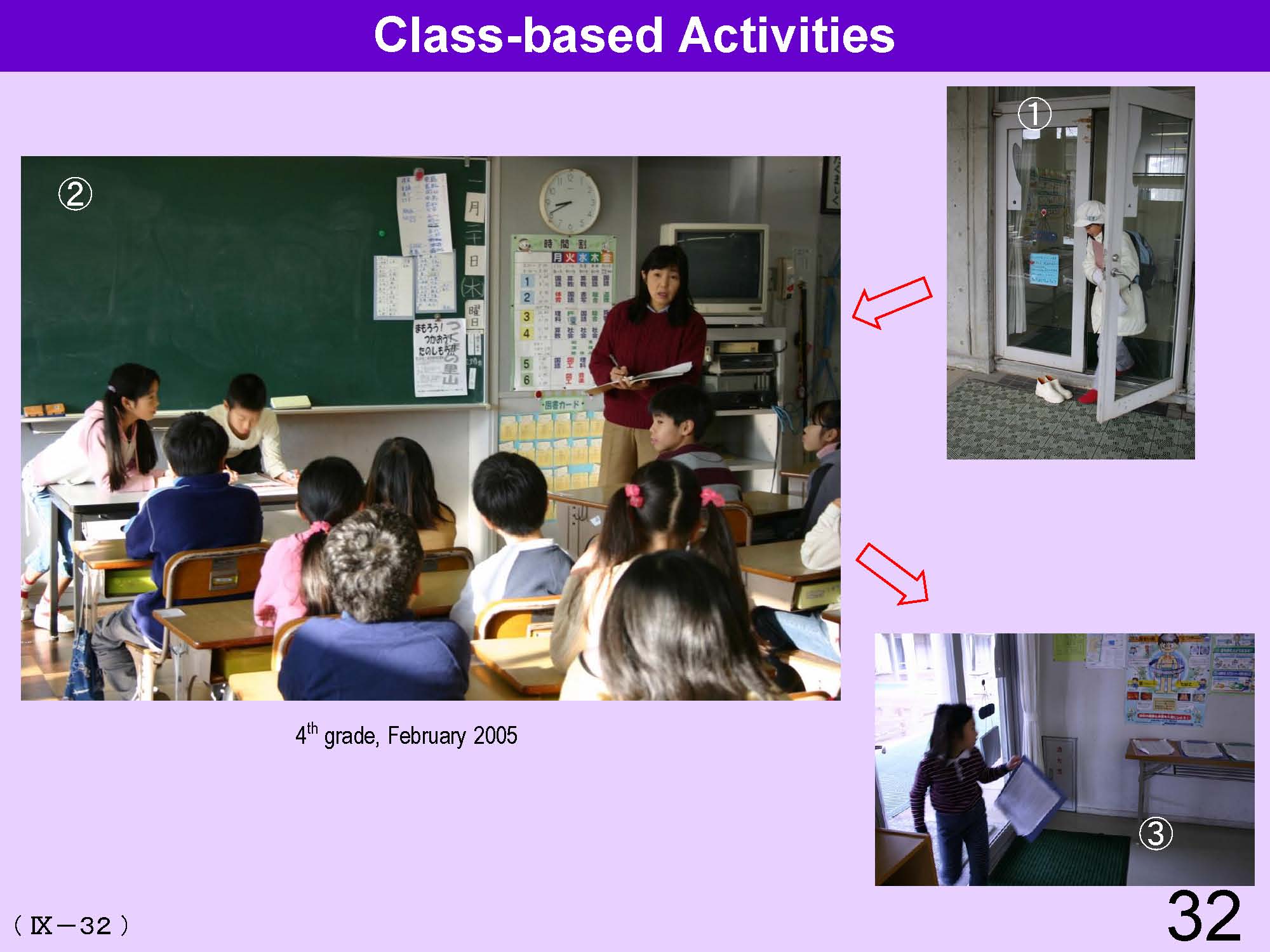 |
A student is responsible for checking the hygiene of classmates ①A student who is responsible for hygiene takes a hygiene check note from a nurse’s office before the morning meeting. ②Hygiene check in the morning meeting ③Returning the health check note to nurse’s office ( Class activities, Group activities, Day duty →Ⅴ-7~9) |
| 33 | 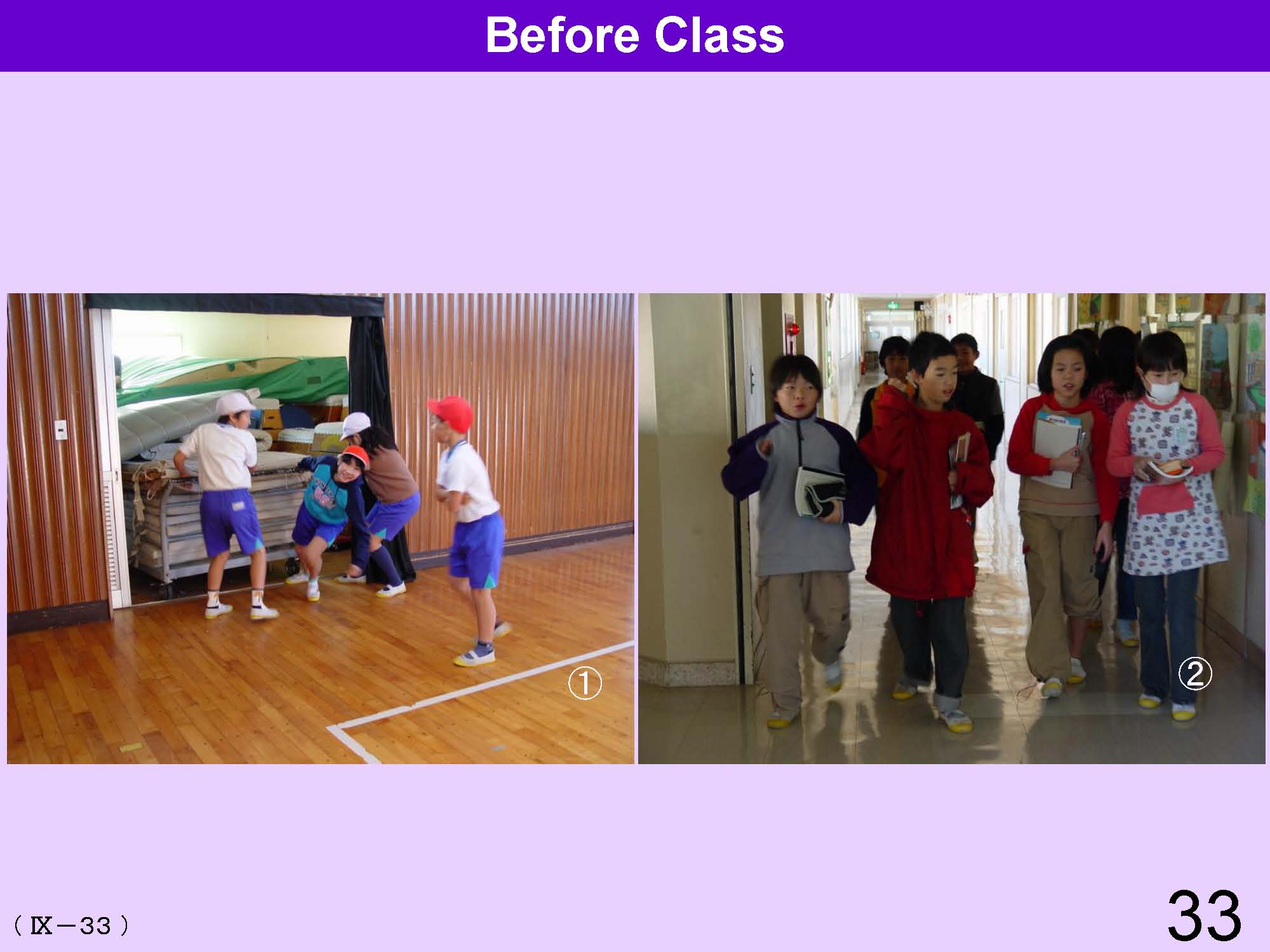 |
①Preparation for a Physical Education class, 5th grade, Physical education, December 2003 ②Moving from a homeroom to aScience room, 6th grade, December 2003 |
| 34 | 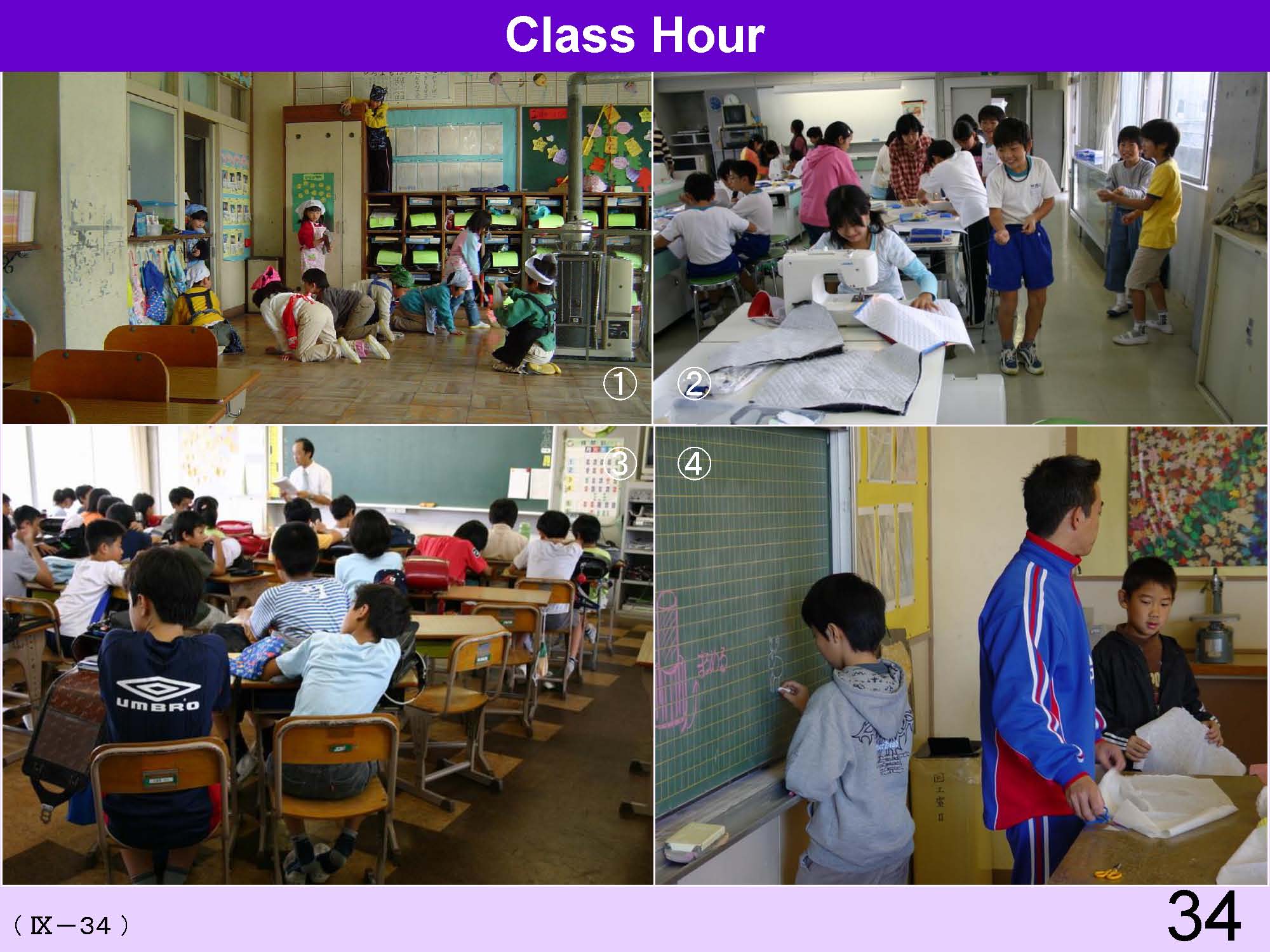 |
Students sometimes show a relaxed attitude during class hour. ①Going up to the shelf (in the cleaning time), 3rd grade, December 2003 ②A thread is tangled in a sewing machine (in the home Economics class), 5th grade, November 2004 ③What is he thinking about ? (in a meeting before going home) , 6th grade, September 2004 ④ Writing graffiti (in handcraft class), 3rd grade, December 2003 |
| 35 | 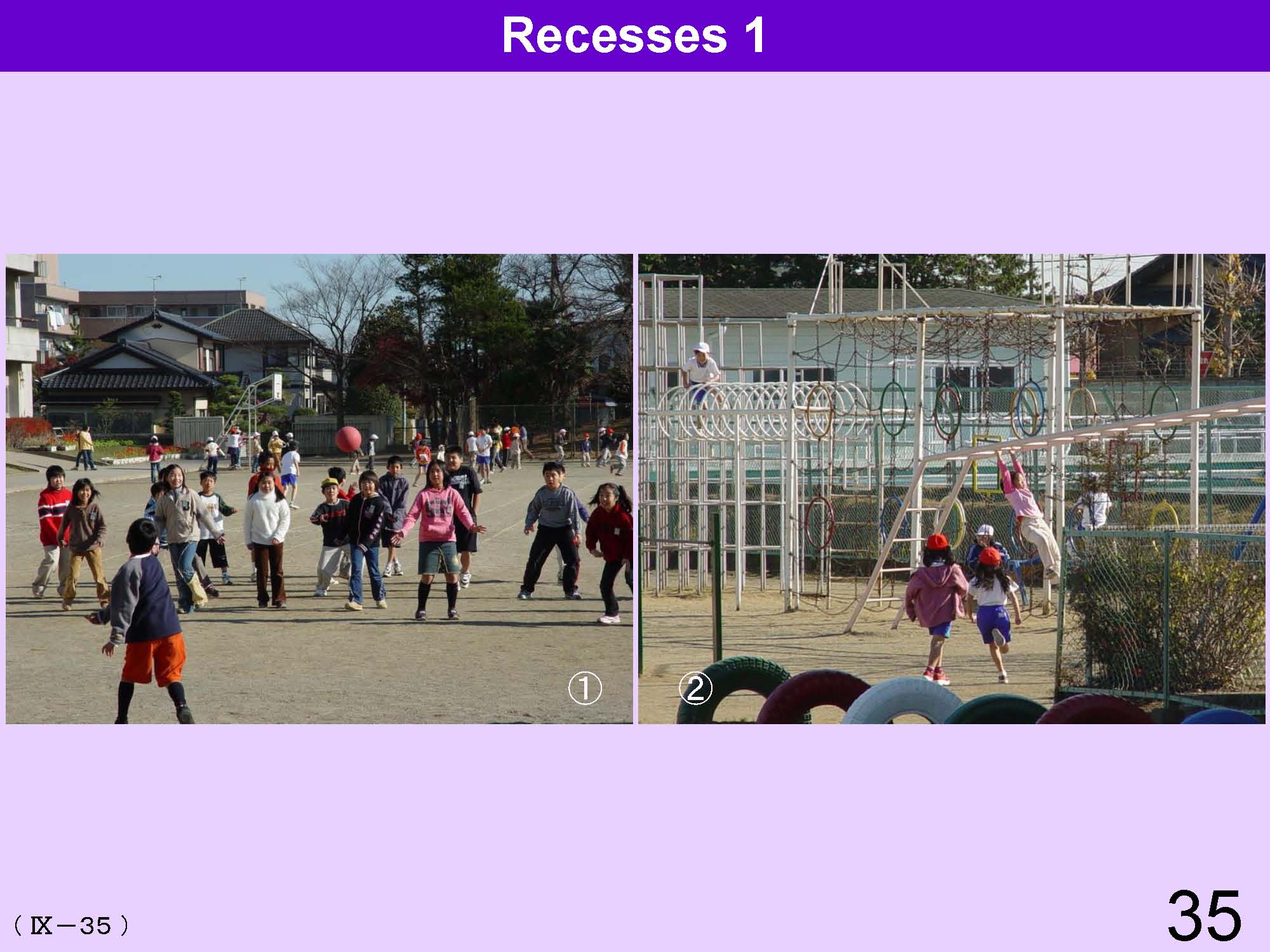 |
①Dodge ball, December 2003 ②Jungle gym, December 2003 In addition to a scheduled lengthy recess, students also have five minute intervals between classes. |
| 36 | 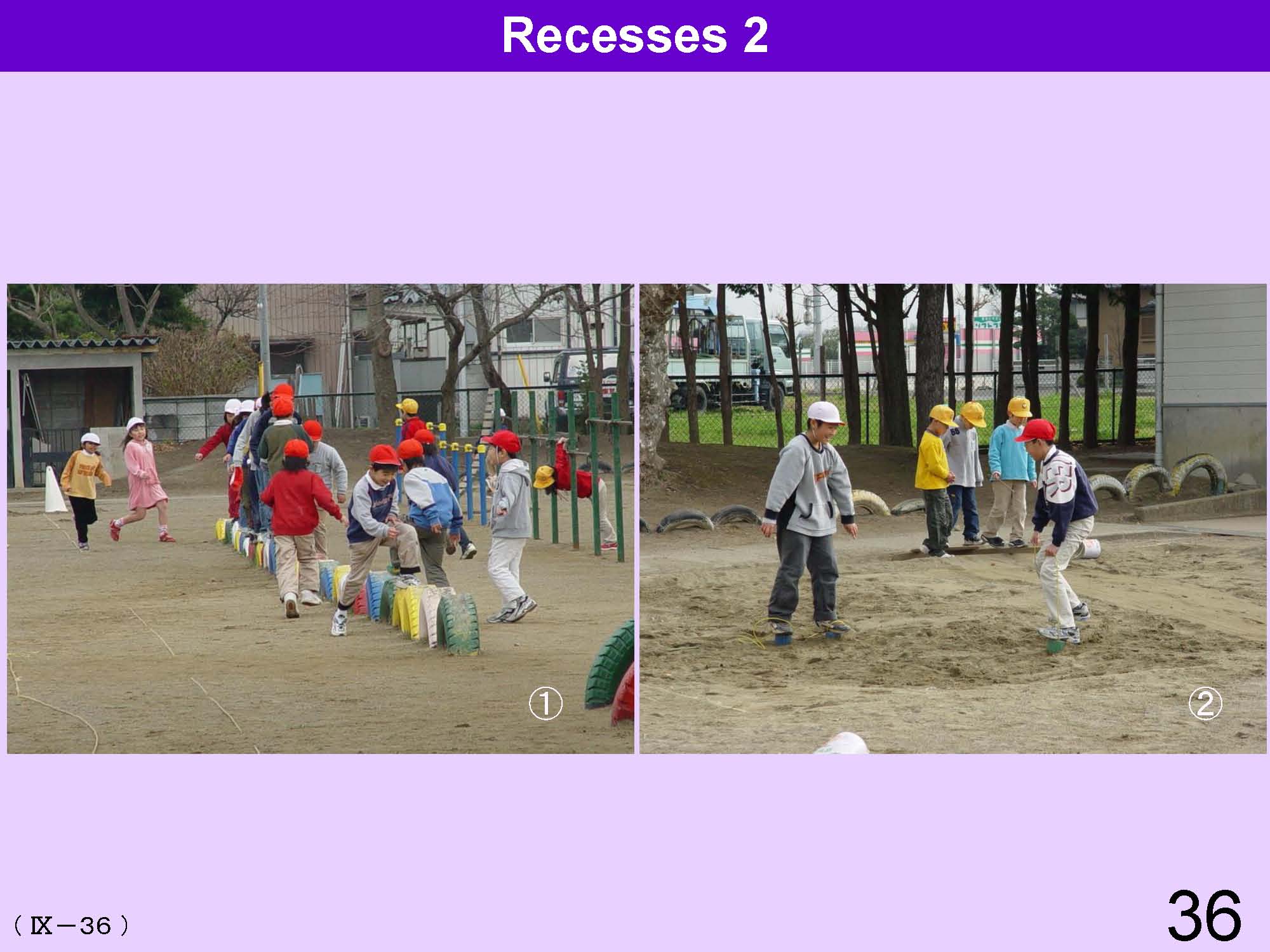 |
①Making use of recycled tires and a horizontal bar, December 2003 ②Recycle cans, December 2003 |
| 37 | 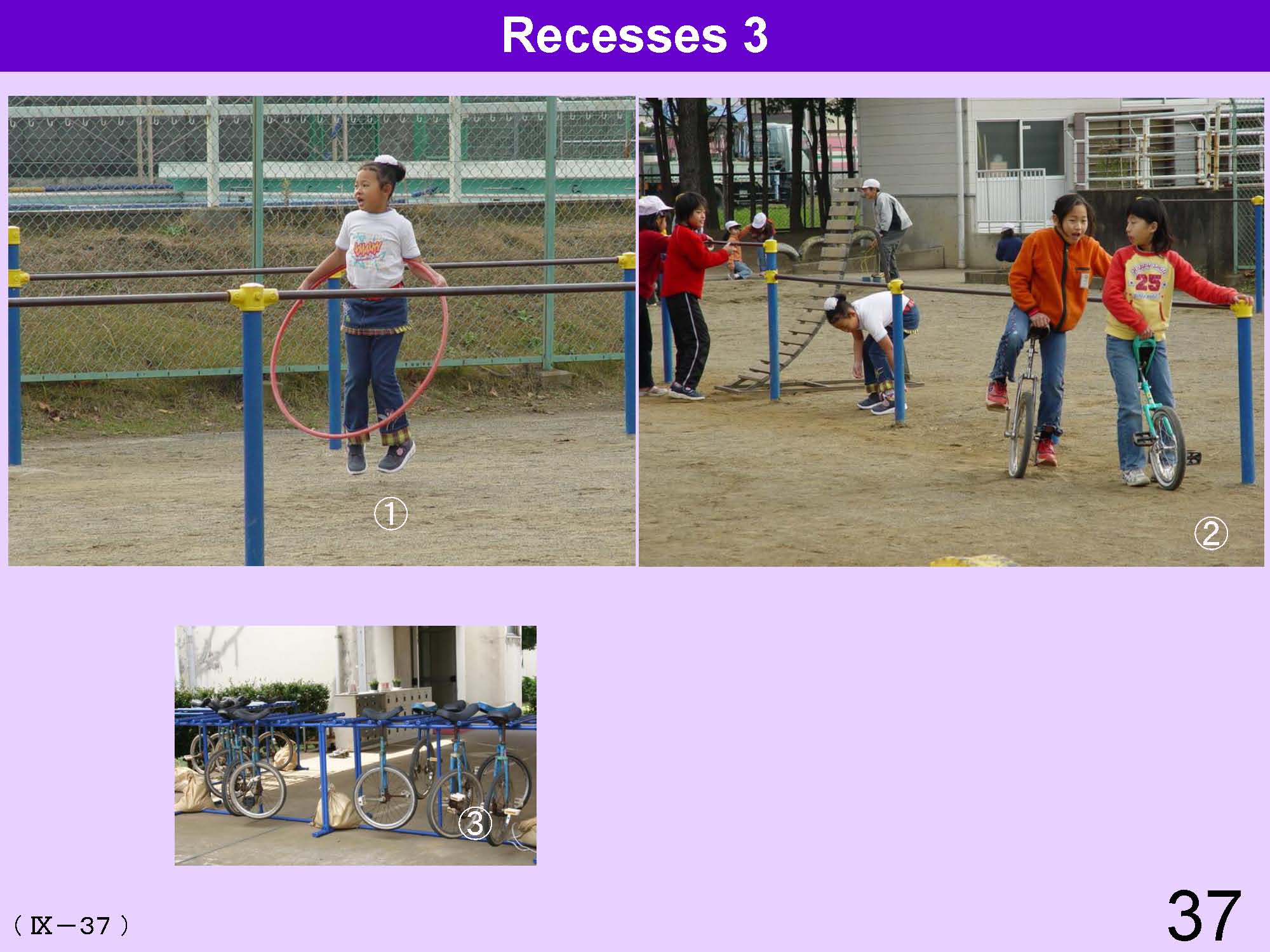 |
①Hula-Hoop, December 2003 ②Horizontal bar with an assisting tool (left side) & Unicycle, December 2003 ③Unicycles are equipped at school |
| 38 | 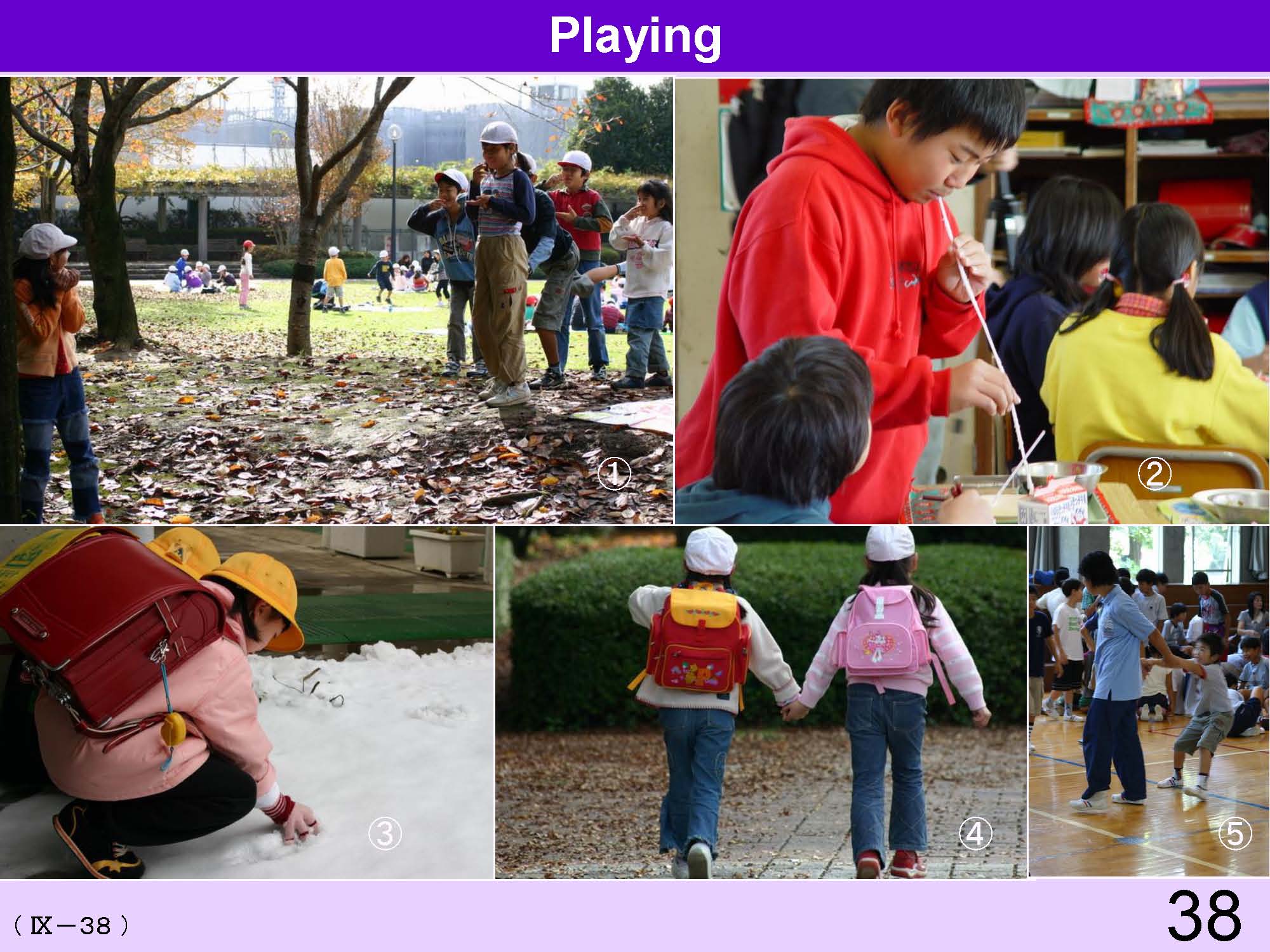 |
①On a school outing involving a mixed age group activity, November 2004 ( →V-15-19) ② During the school lunch hour, 6th grade, December 2003 ③ During the morning, February 2005 ④ During an outdoor study hour, November 2004 ⑤ After a discussion to decide what mixed age group activity will be planned for a school trip. |
| 39 | 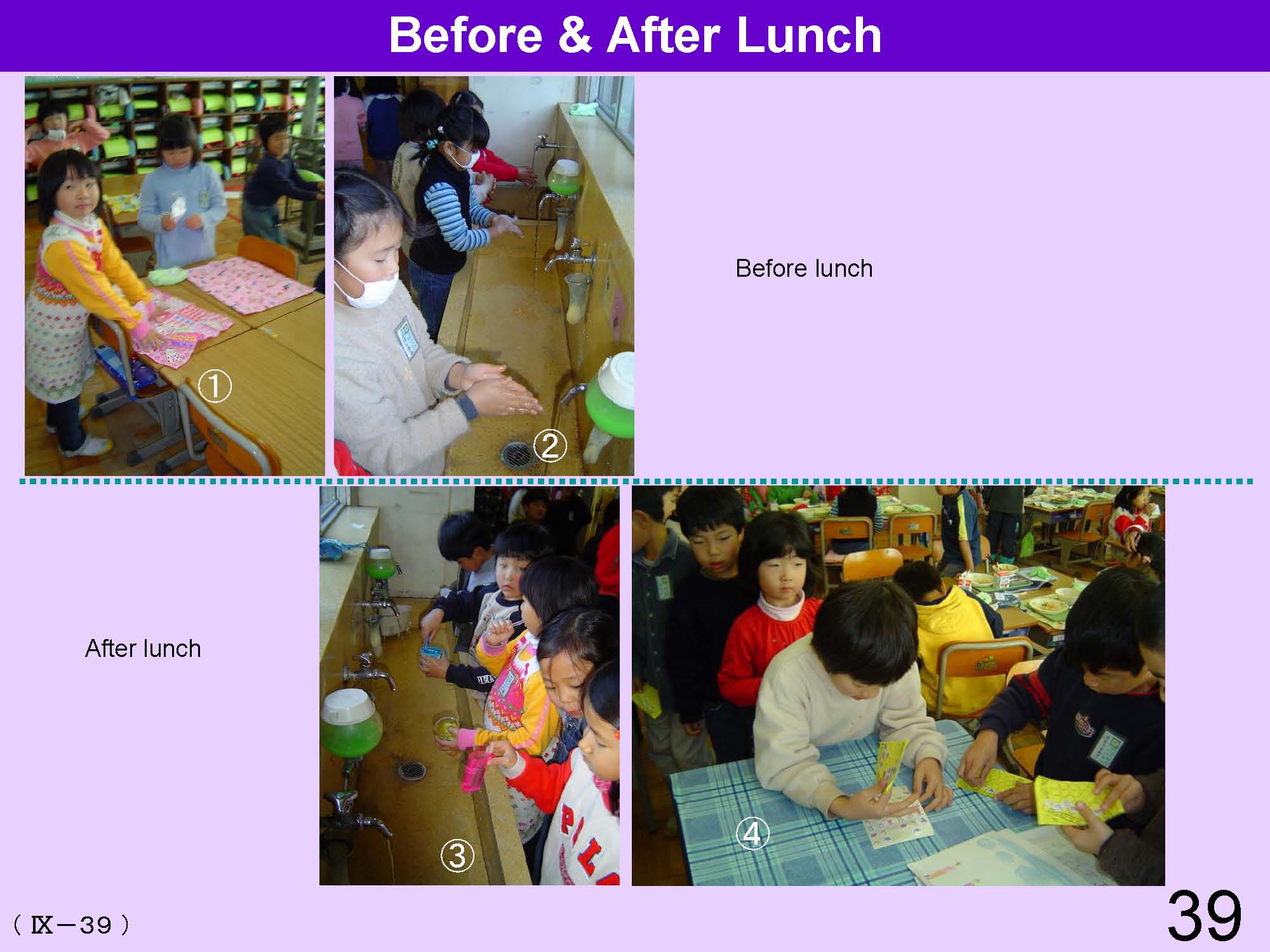 |
①Laying tablemats, 1st grade, December 2003 ②Wearing a mask and washing hands, 1st grade, December 2003 ③Brushing teeth after lunch, 1st grade, December 2003 ④Sticking a lunch seal for lunch participation after lunch, 1st grade, December 2003 |
| 40 | 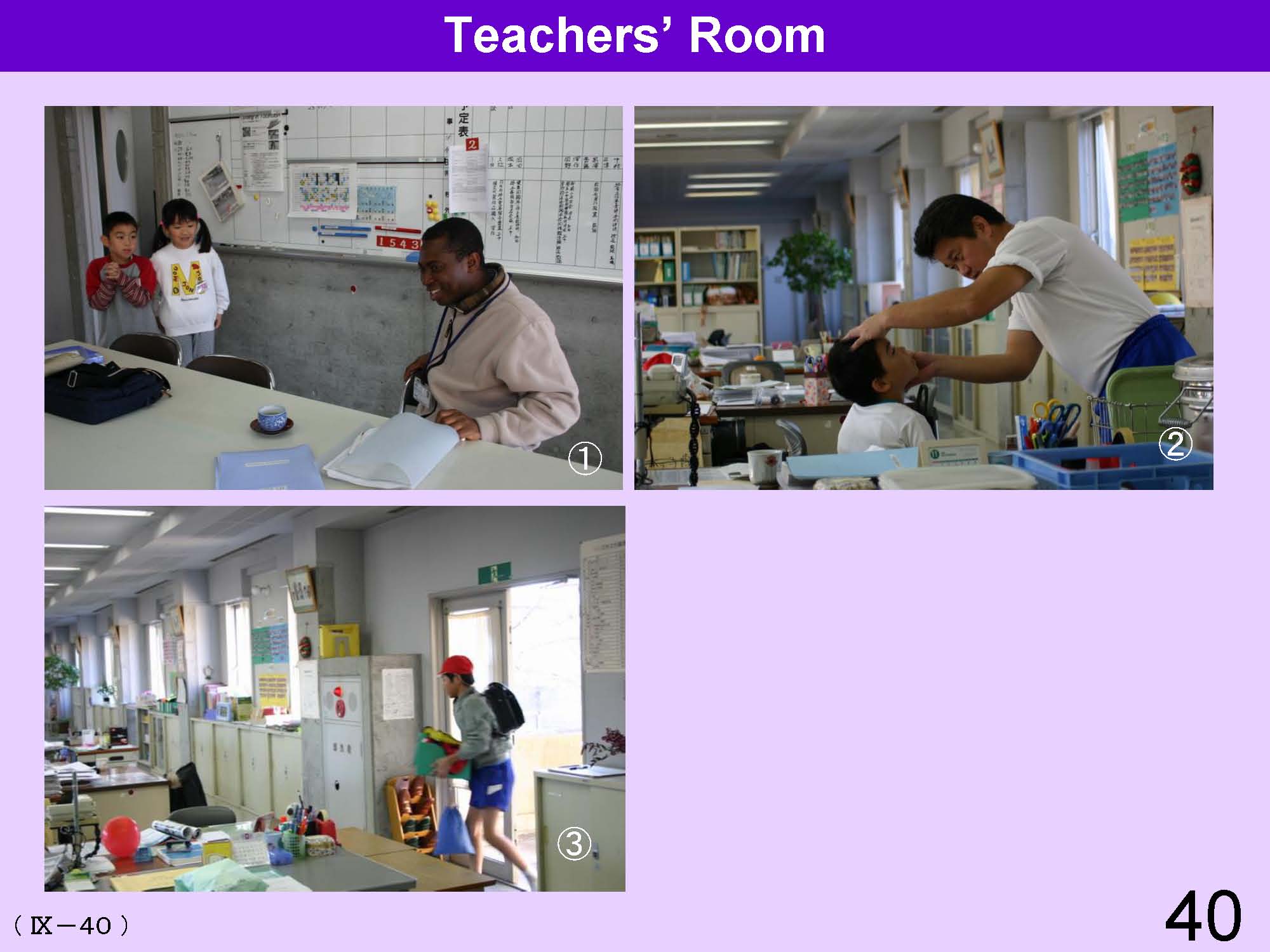 |
①Taking an Assistant English Teacher to a class, 1st grade, November 2004 ②Removing a speck of dust from the eye, November 2004 ③Returning to teaching facilities after a class, January 2005 |
| 41 | 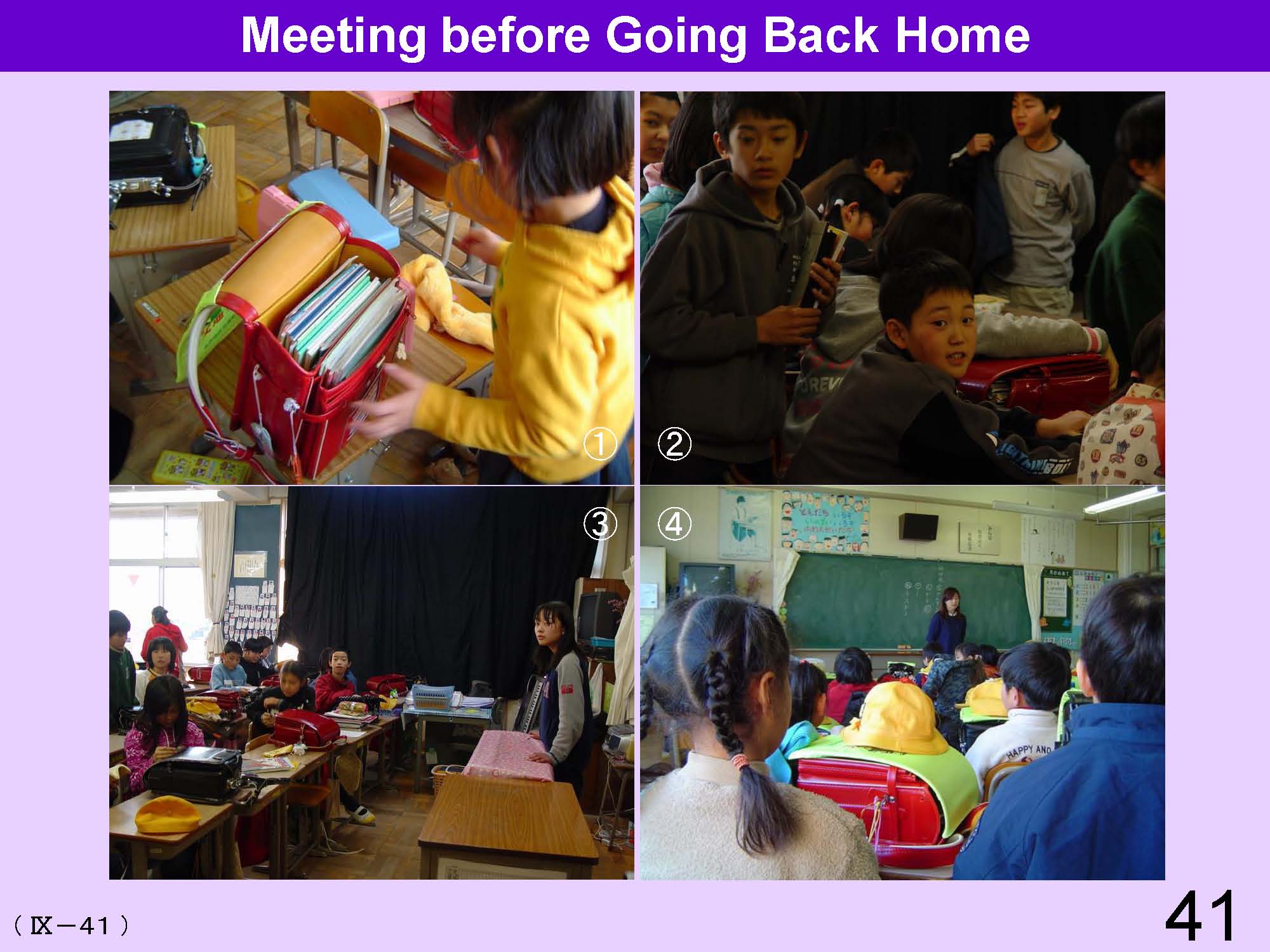 |
① Preparation for going home, 1st grade, December 2003 ② Putting on a jacket, 6th grade, December 2003 ③ The class leader for the day is announcing some information, 6th grade, December 2003 ④ Homeroom teacher’s speech, 1st grade, December 2003 |
| 42 | 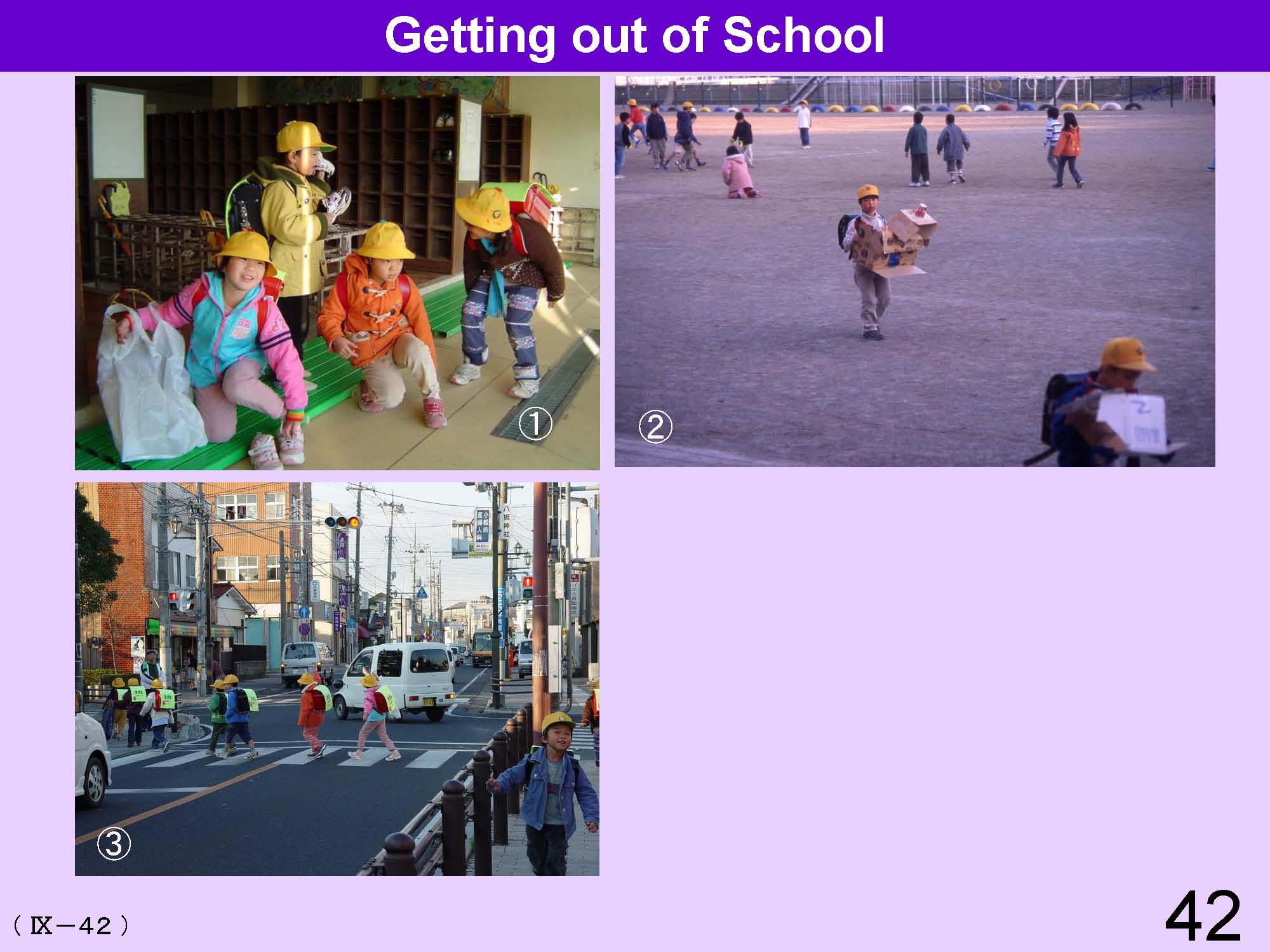 |
①Wearing a yellow hat for safety, December 2003 ②Taking craft work back home, December 2003 ③Going home in a group, December 2003 |
| 43 | 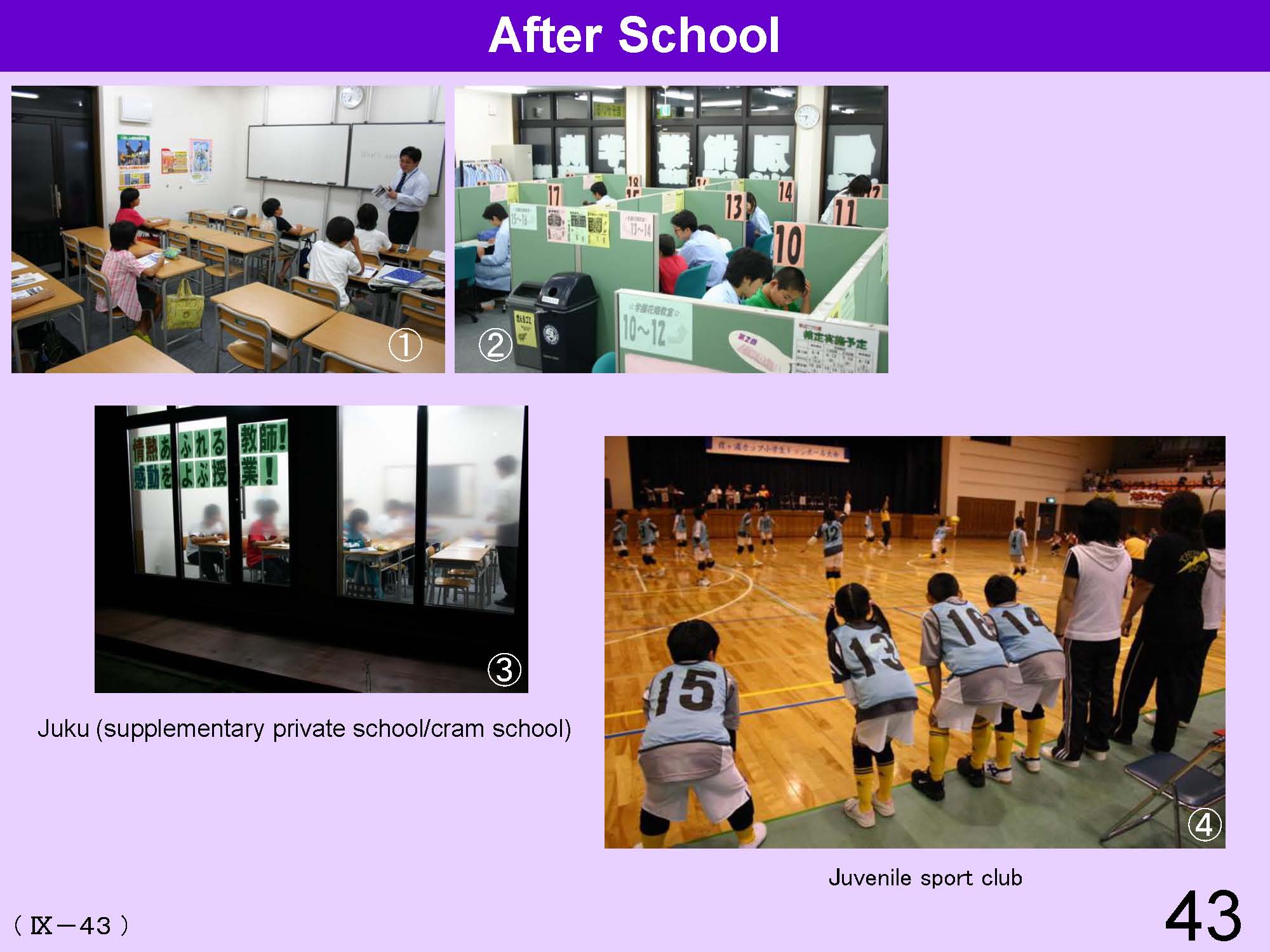 |
①②③Juku (supplementary private school/cram school) ② Play dodge ball games organized by the dodge ball club. After school many students commute to a cram school (Juku) and learn such skills as playing the piano and the violin, dancing and writing calligraphy. Some students learn such sports as soccer, baseball, kendo and judo in a youth sports club on weekends. (The five-day week system was fully implemented from2002. ) |
| 44 | 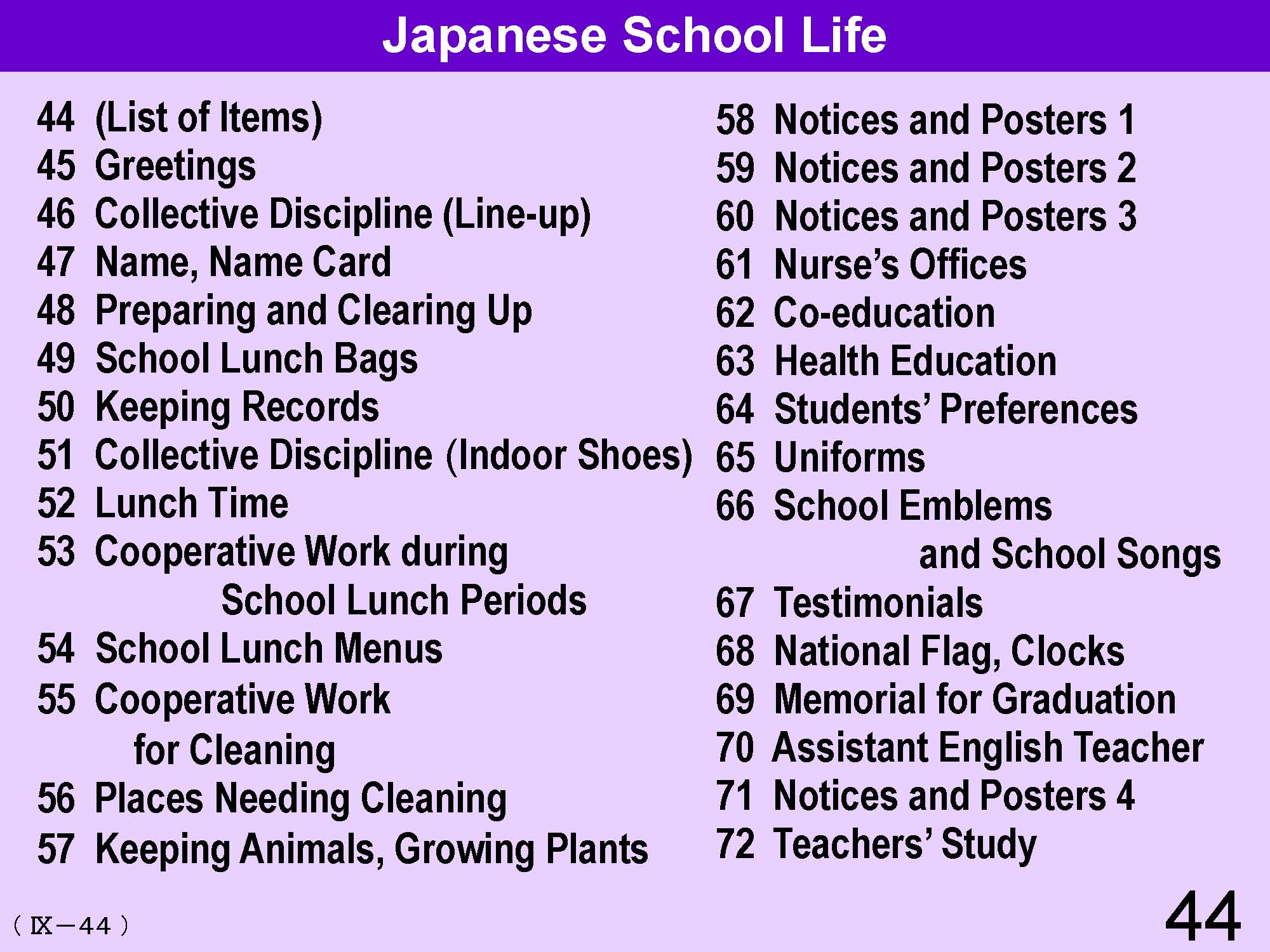 |
In school life, students are trained to develop social behavioral skills, particularly group discipline and a sense of solidarity to the community and the state. On the other hand, they also taught to recognize their own individuality through assuming individual roles and responsibilities. |
| 45 | 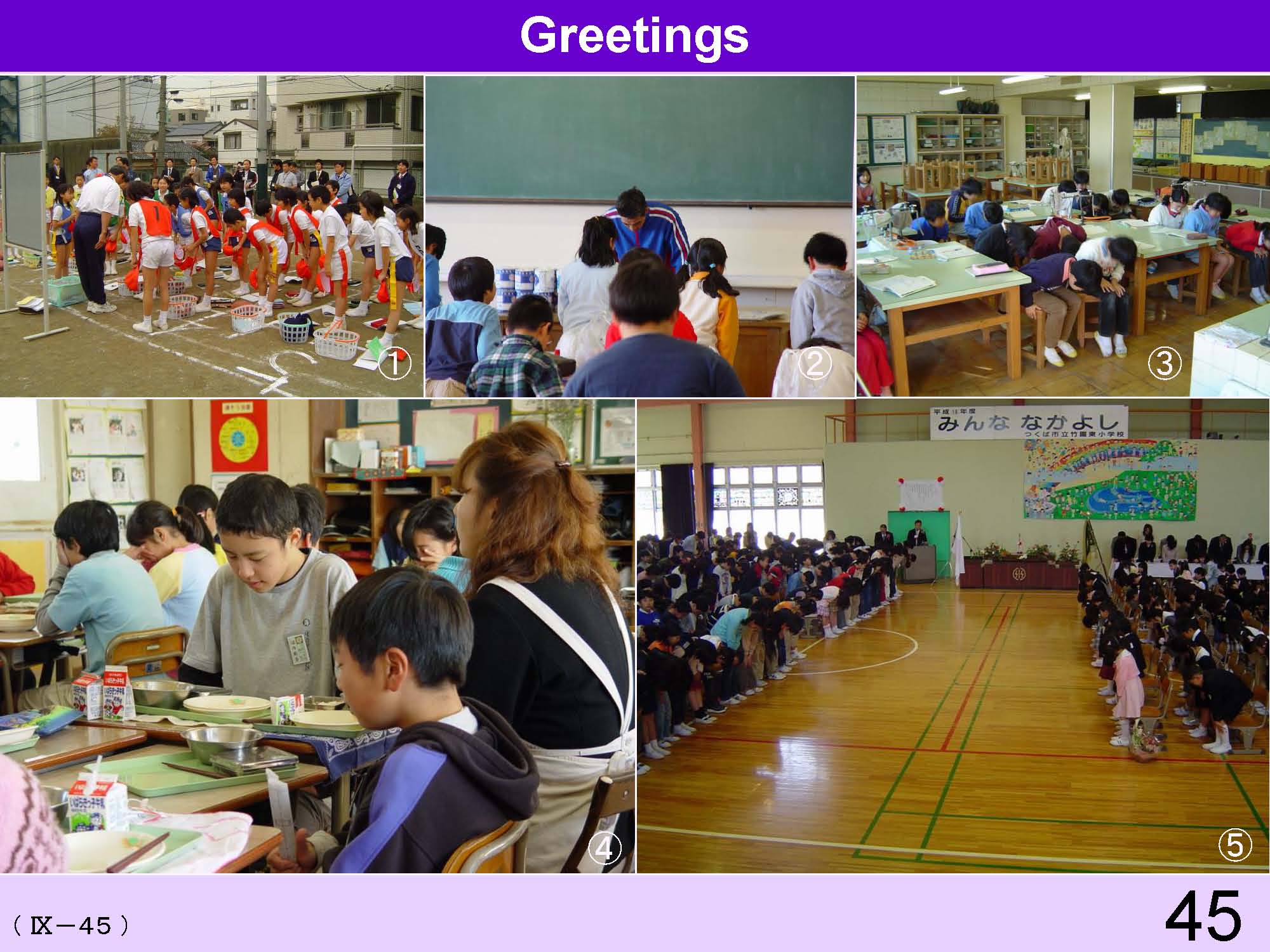 |
①Physical education class, 4th grade, November 2003 ②Drawing & handcraft class, 3rd grade, December 2003 ③Science class, 4th grade, December 2003 ④Performance after school lunch, 6th grade, December 2003 ⑤Entrance ceremony, April 2004 |
| 46 | 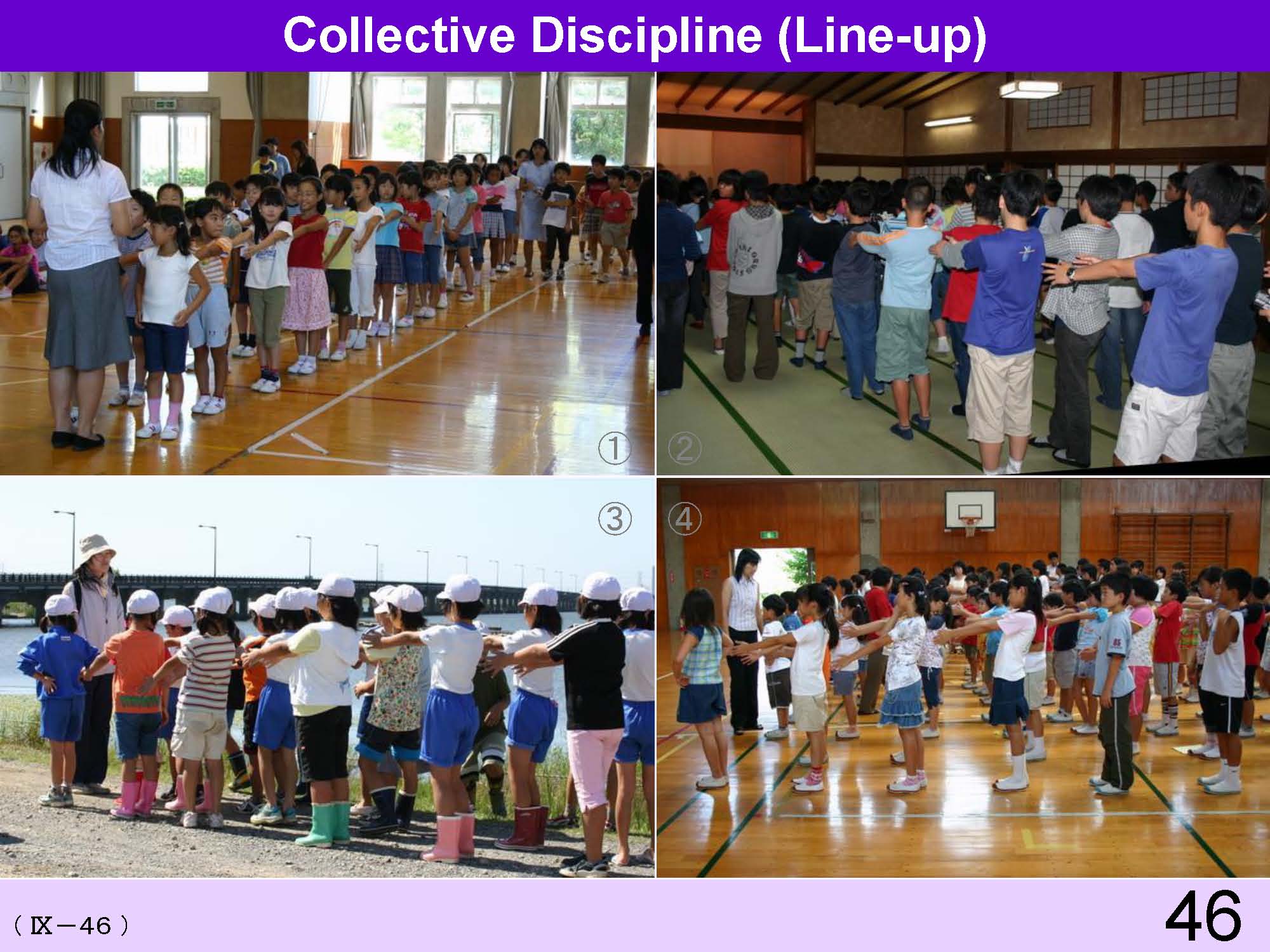 |
①Line up before the opening ceremony, 3rd grade, September 2004 ②School excursion at an inn where the students stayed, 6th grade, November 2004 ③Outdoor study (the period of integrated study), 4th grade, October 2004 ④After closing ceremony, 3rd grade, July 2004 /td> |
| 47 | 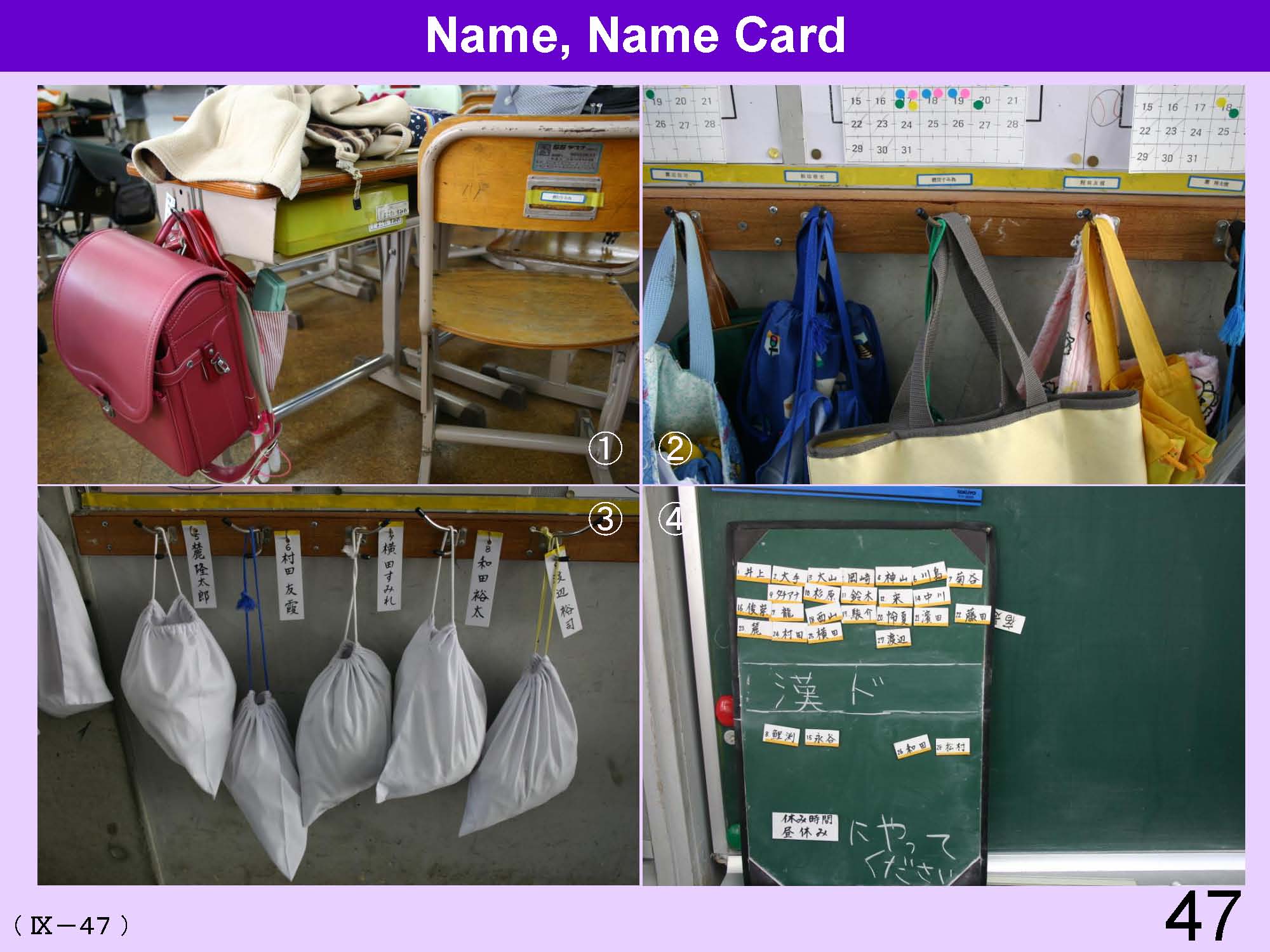 |
①Desk, chair and school bag, 4th grade, January 2005 ②Private bag, 4th grade, January 2005 ③School lunch bag, 4th grade, January 2005 ④Submission of homework, 4th grade, January 2005 |
| 48 | 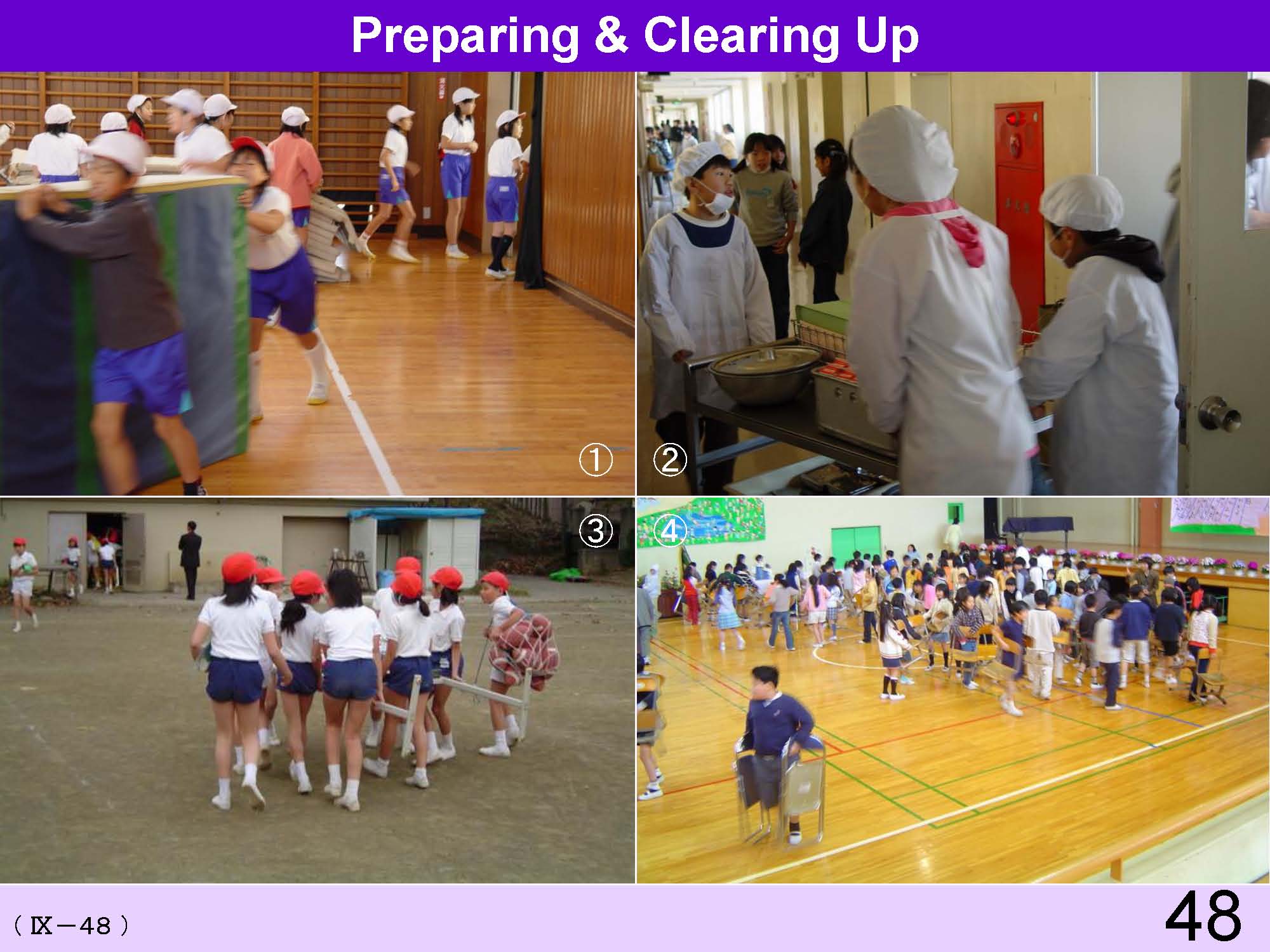 |
①Preparation for Physical Education, 5th grade, December 2003 ②Preparation for school lunch, 6th grade, December 2003 ③Clearing in Physical Education, 4th grade, November 2003 ④Clearing at Entrance Ceremony, April 2004 All the students help with preparations and clearing-up during and after class and school events. |
| 49 | 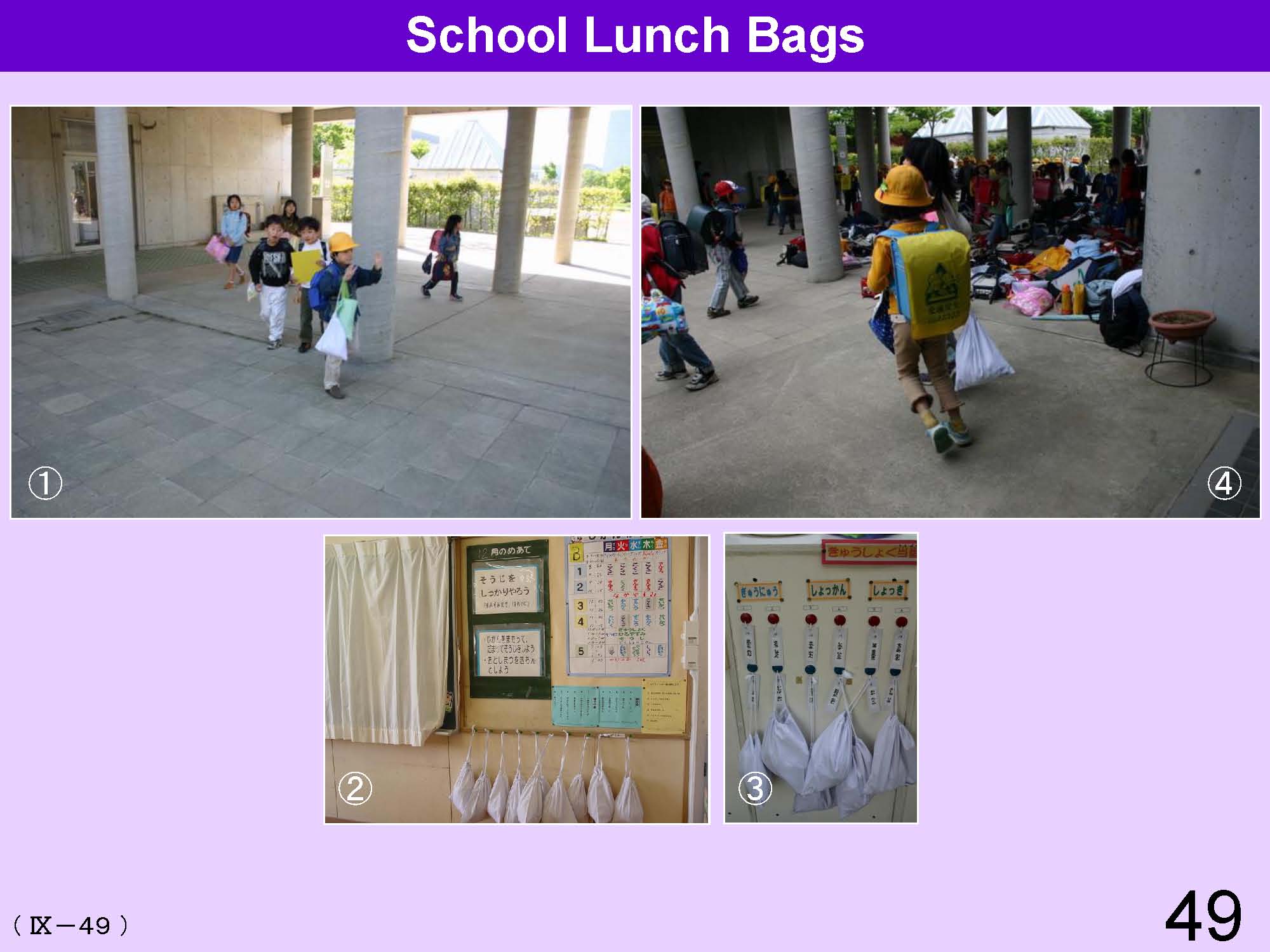 |
School lunch bags with an apron and coif are hung on the wall. Students wear an apron and a coif when it’s their turn to serve lunch. When they finish their task for the week, they wash their apron and coif, and hand them to the next students who will be responsible for the task. ①Going to school with a school lunch bag on Monday morning ②③School lunch bags on the wall, ④ Going home with a school lunch bag on Friday |
| 50 | 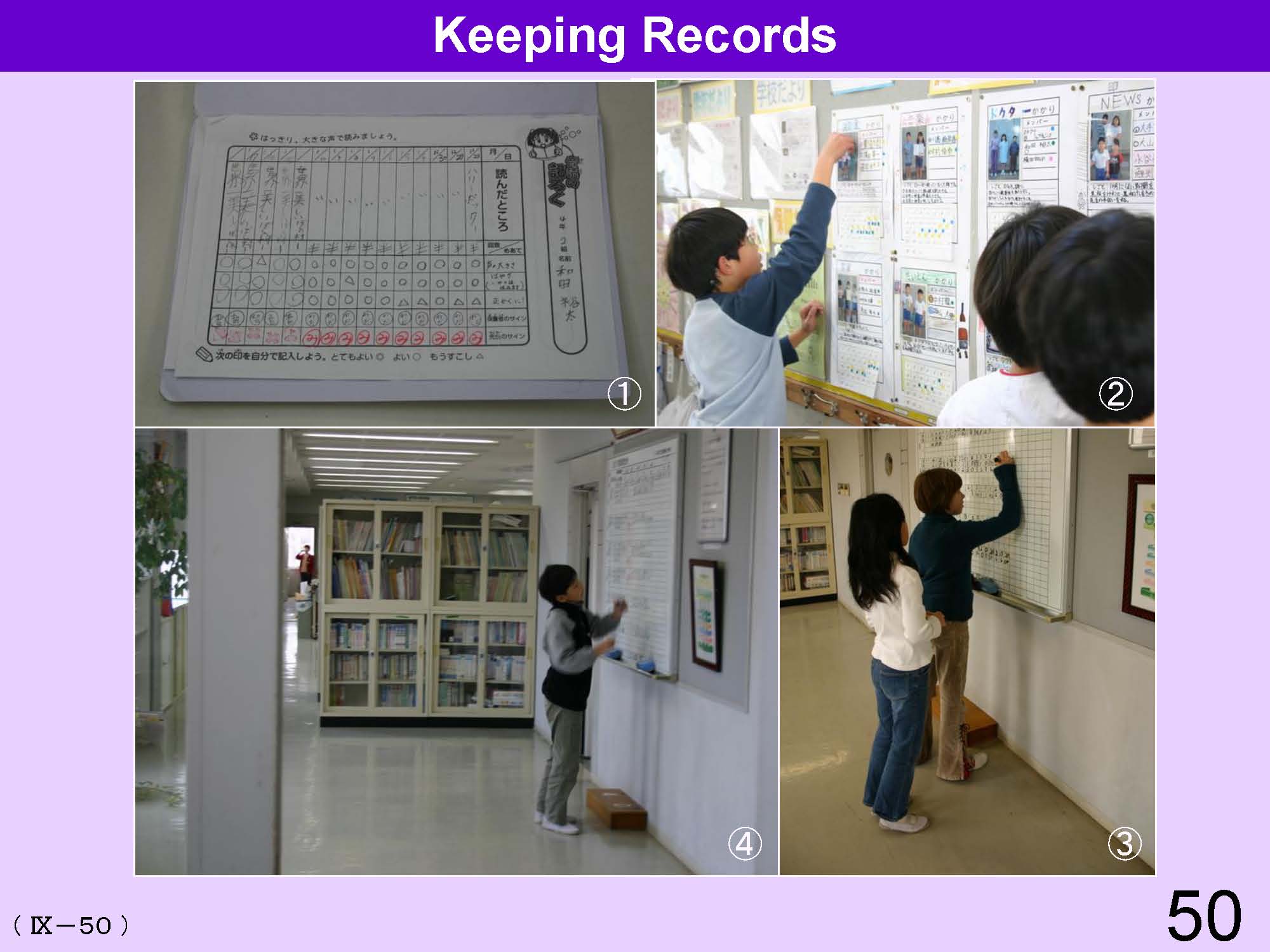 |
①Checking reading homework, ②Students are recording their assigned jobs anytime after they finish them, 4th grade, January 2005, ③Students responsible for hygiene check ups for a class record student attendance every morning, 4th grade, February 2005, ④Students responsible for hygiene check ups for a class record attendance of students for every morning, 3rd grade, November 2004 Students record in turn student names for reading books, job assignments and attendance. They are accustomed to such responsibilities for record keeping. Students are responsible for attendance and general hygiene checks. |
| 51 | 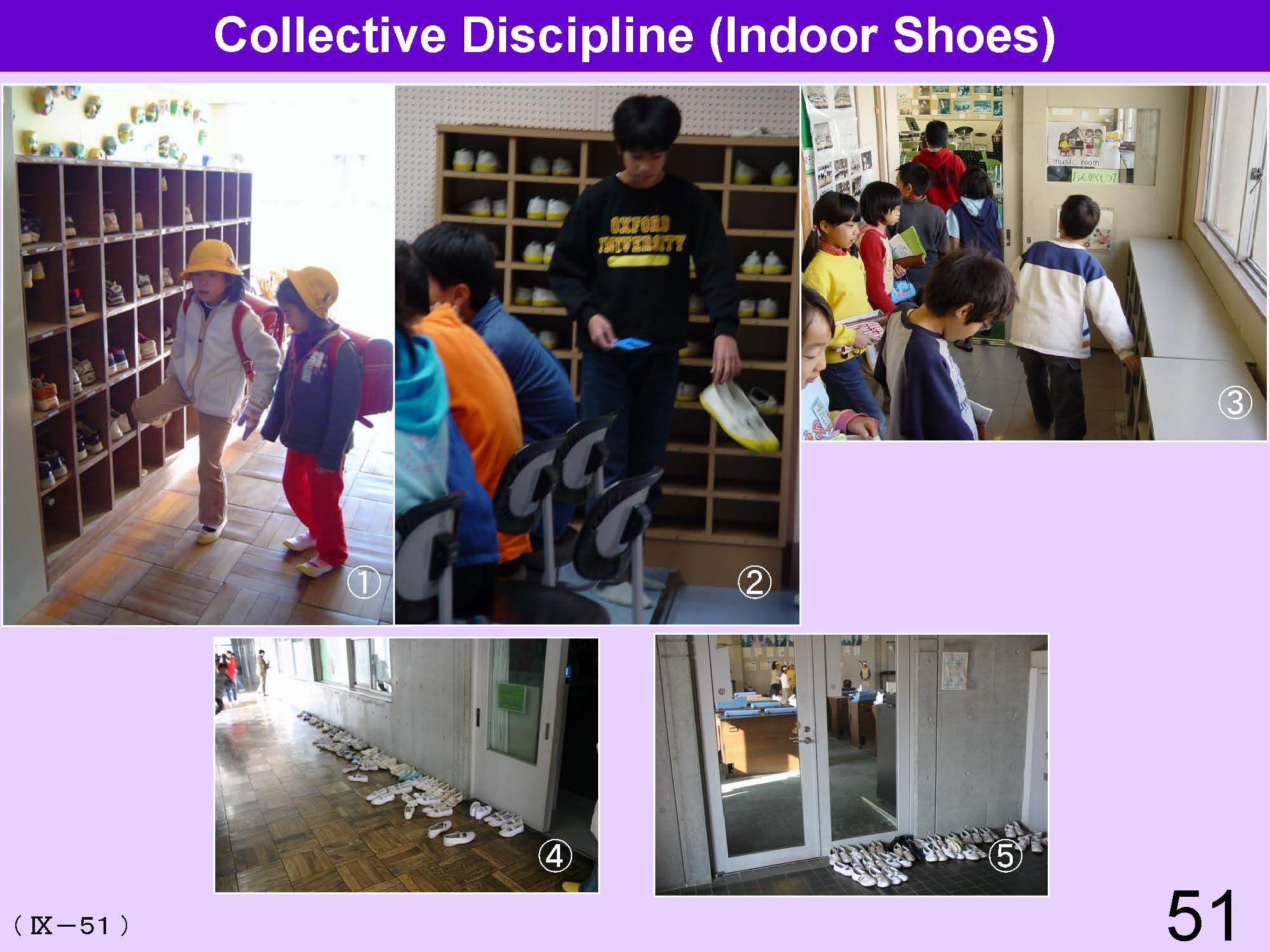 |
Students usually change their shoes inside and outside of school. ①In school students wear indoor shoes. ②④Computer room ③⑤Music room |
| 52 | 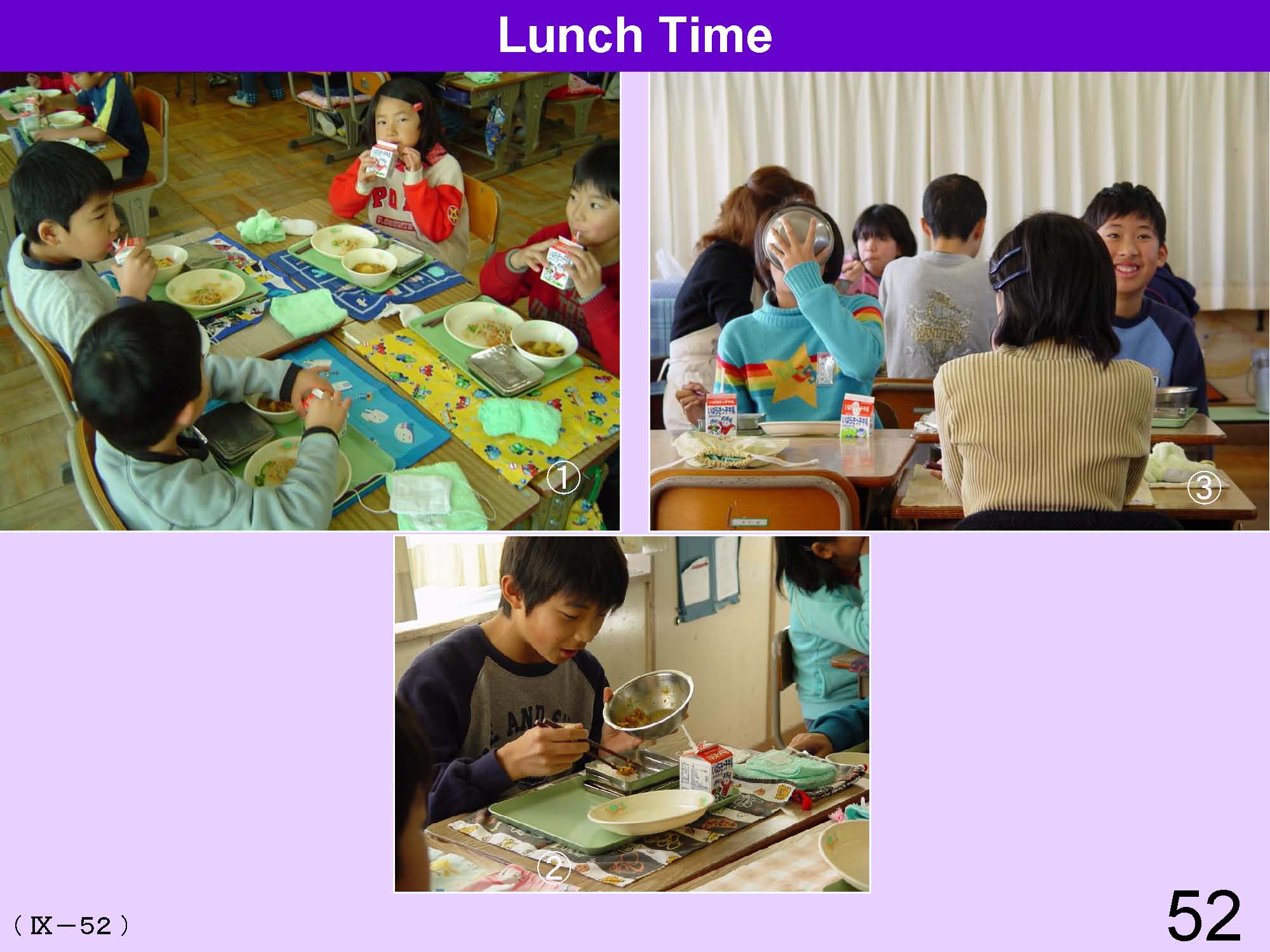 |
①Eating lunch sitting in a chair, 1st grade, December 2003 ②Using chopsticks, 6th grade, December 2003 ③Drinking a bowl of soup, 6th grade, December 2003 |
| 53 | 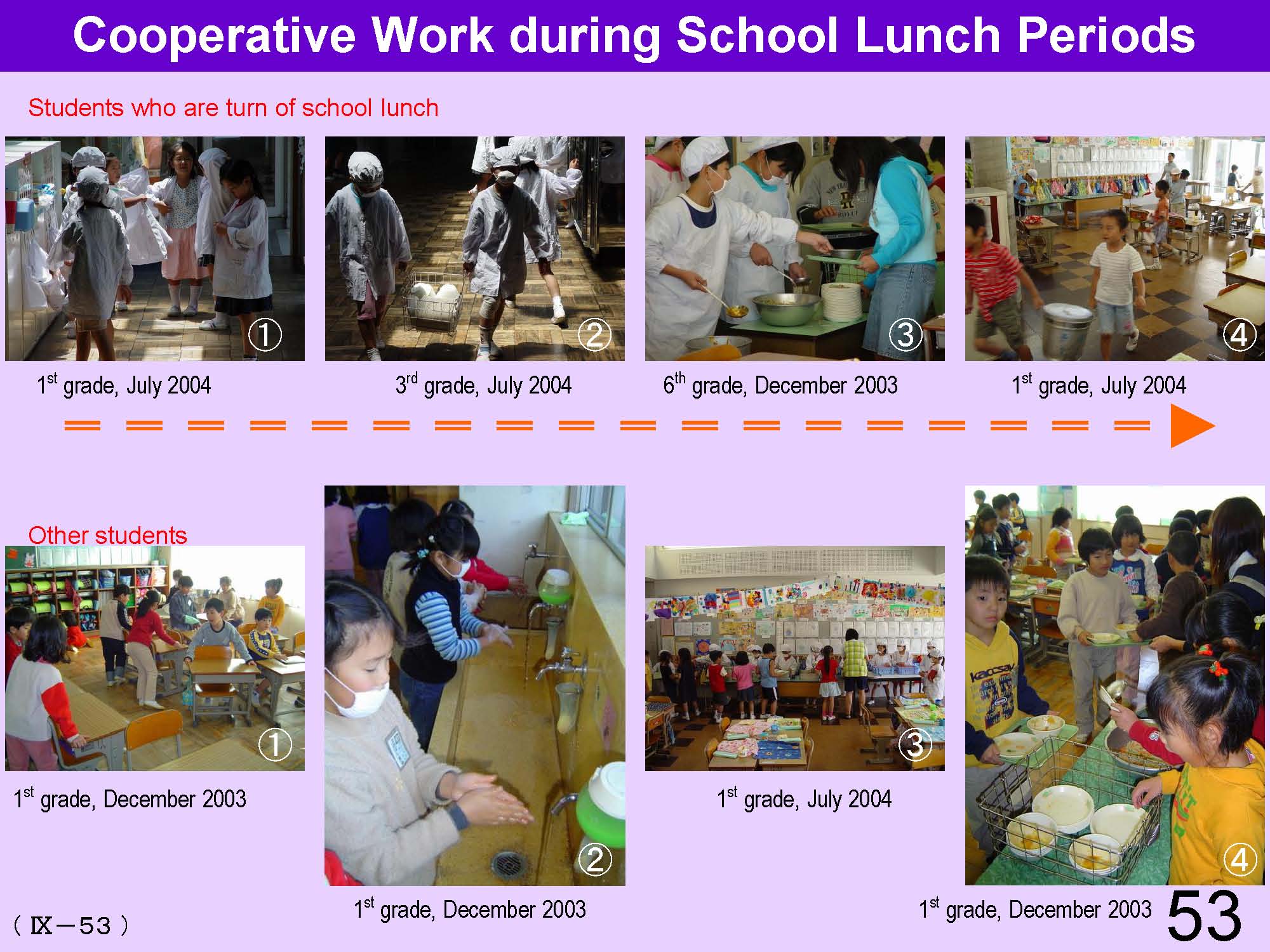 |
The division of tasks between students at school lunch time makes it possible for students to have lunch regularly: a group of students are responsible for serving lunch, while another group arranges desks and chairs for lunch. They take turns for these tasks. ①Putting on a apron and a coif. ②Carrying school lunch container to the homeroom. ③Distributing the school lunch. ④Returning the school lunch containers to the school lunch room. Students who are not involved in the tasks. ⑤Arranging desks. ⑥Washing hands. ⑦Lining up to receive school lunch. ⑧Returning the dishes. |
| 54 | 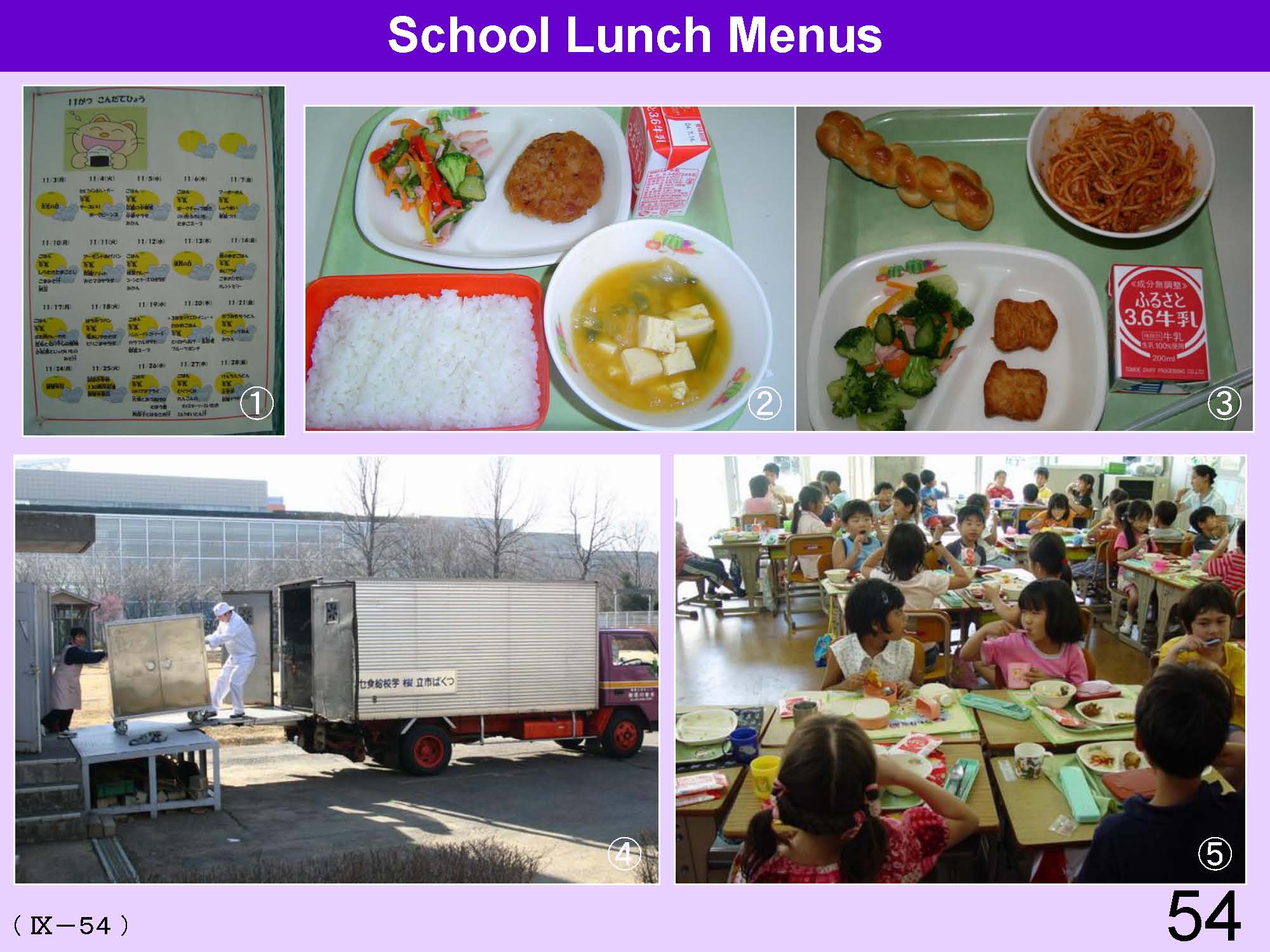 |
①School lunch menus for a month, ②School lunch with bread, ③School lunch with rice ④School lunch is delivered from the school lunch center by truck everyday. ⑤ Students who by exception are permitted to bring a box lunch from home. (left side), 1st grade The nutritional balance and calories are considered in the lunch contents. (the school lunch law →Ⅱ-43) |
| 55 | 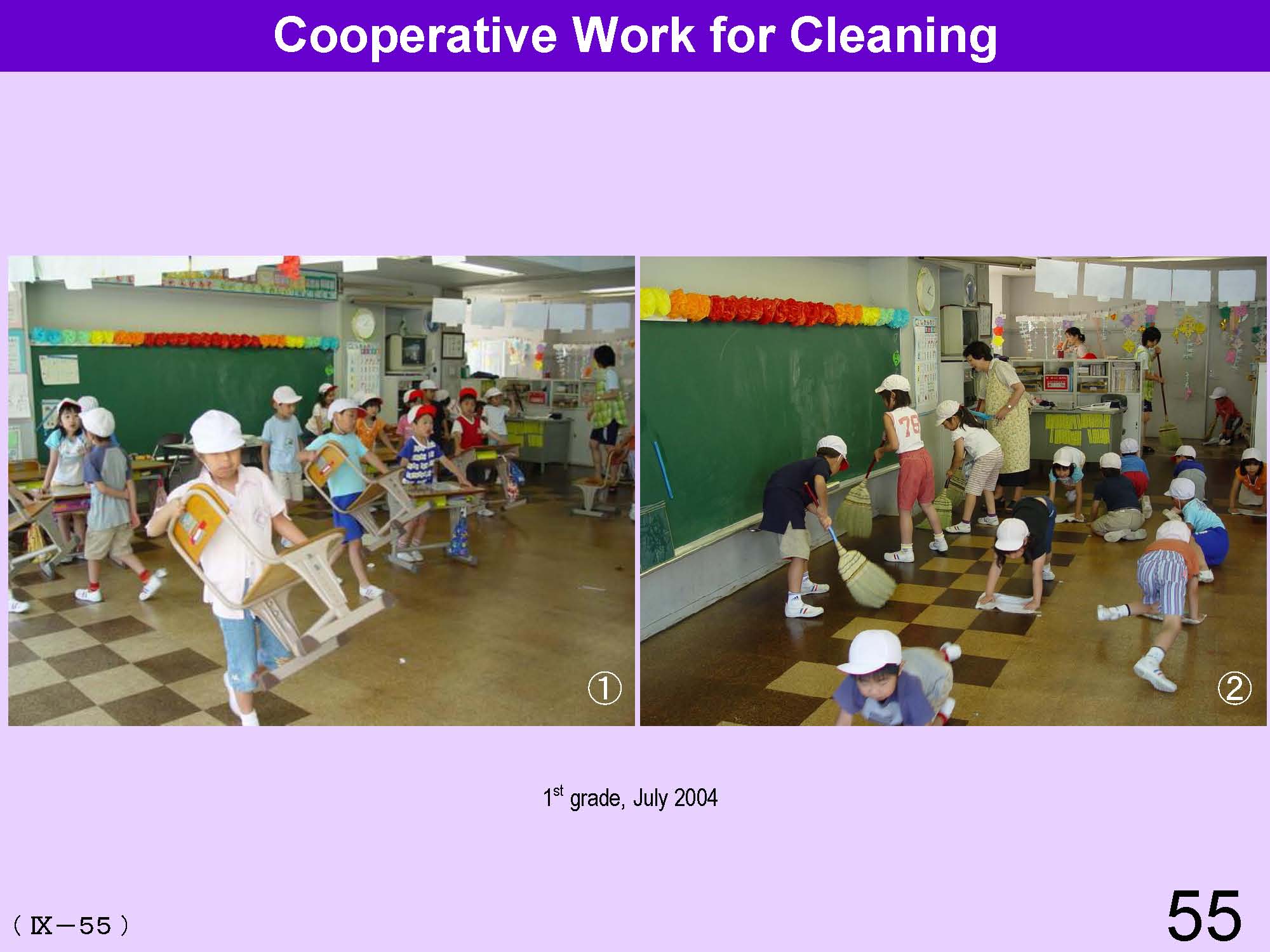 |
①Moving desks and chairs. ②Students are sweeping the homeroom with a broom and students are wiping the floor with a damp cloth. Cleaning the school is done by all the students. It is considered to be one of the educational activities. |
| 56 | 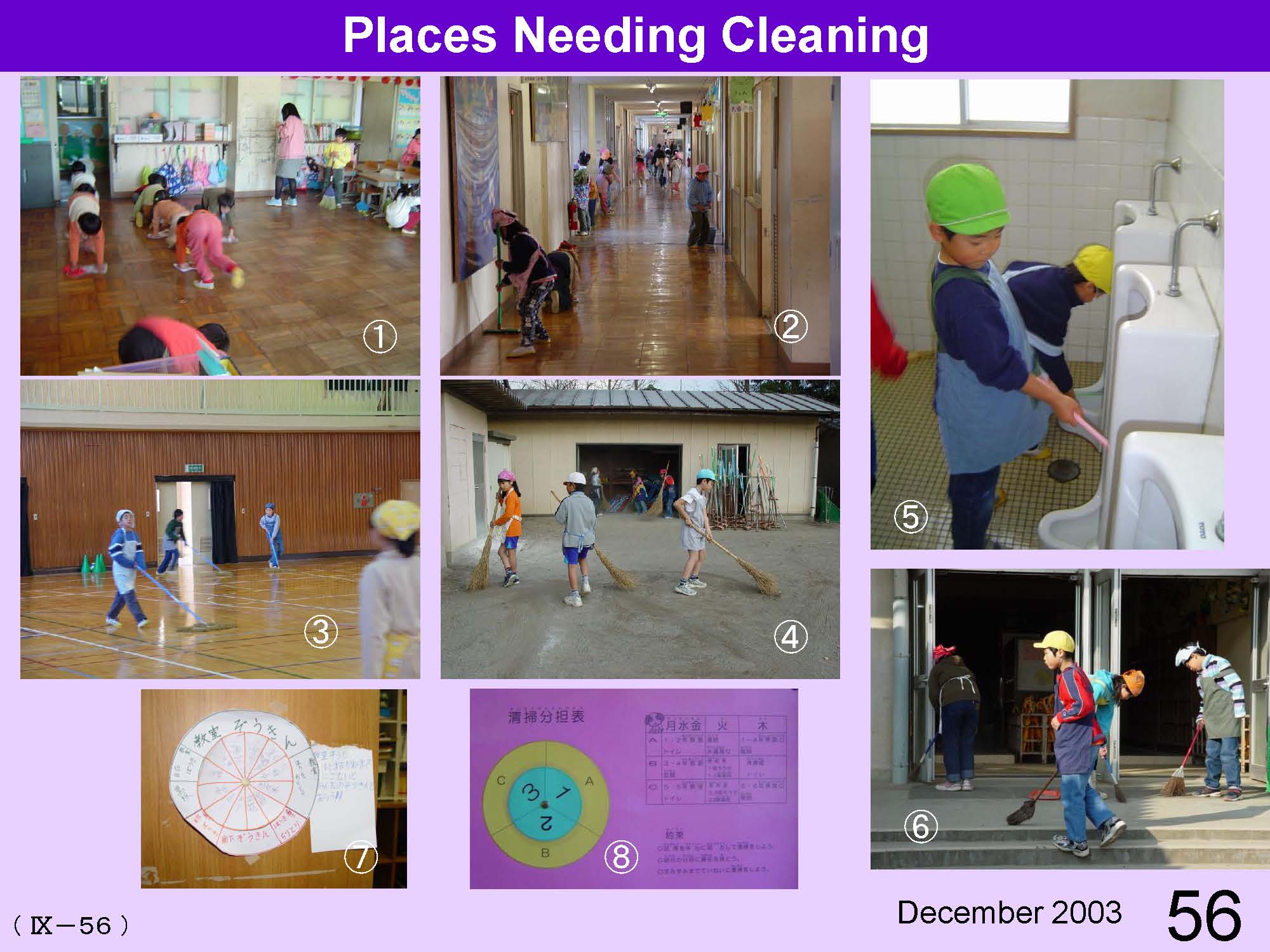 |
①A homeroom teacher is helping with homeroom cleaning. 1st grade, ②Corridor, ③Gymnasium, ④School yard, ⑤Lavatory, ⑥Entrance, ⑦⑧Turn table of cleaning areas. |
| 57 | 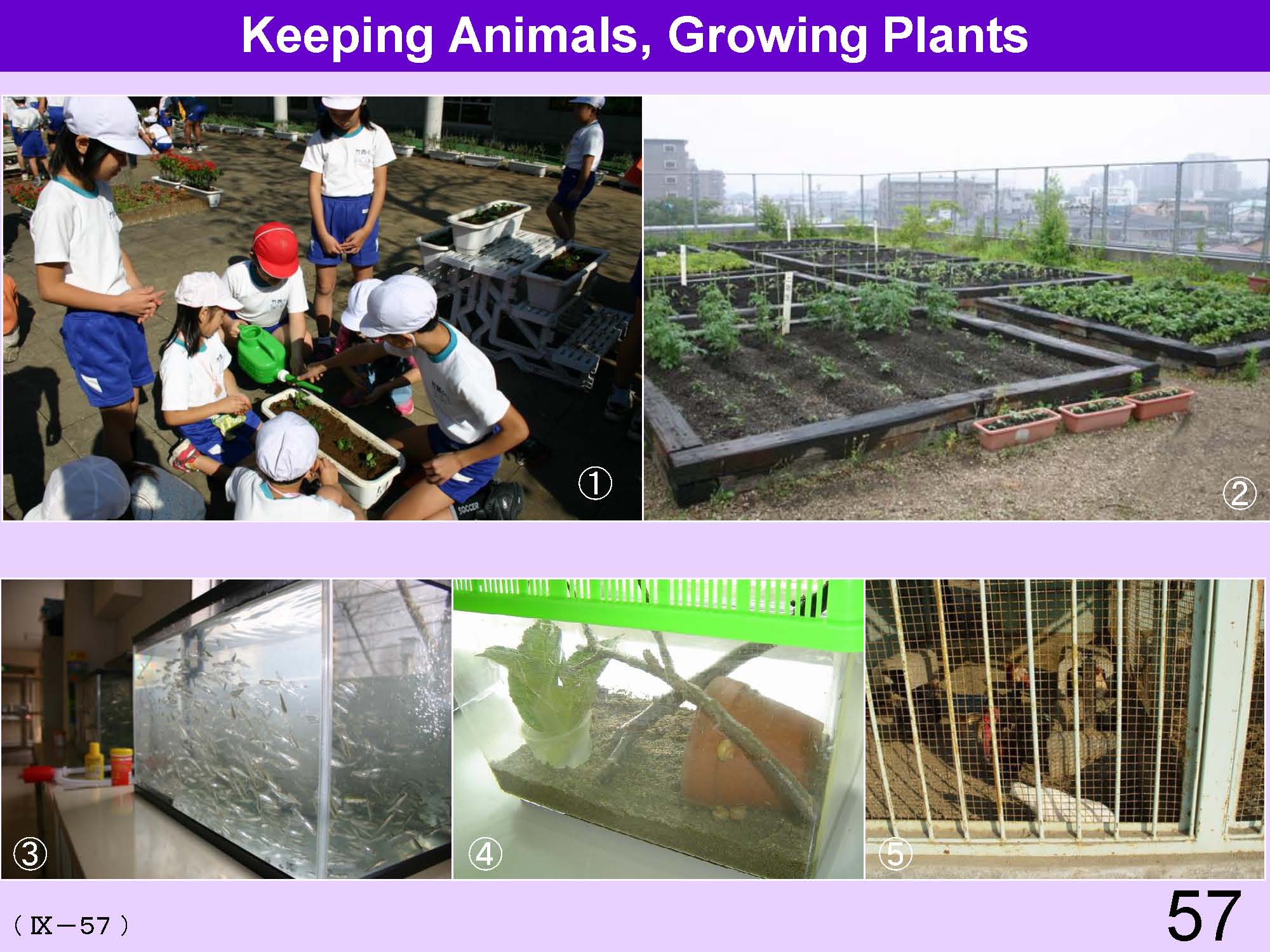 |
①Planting flower seedlings in a planter, 1-6th grade, November 2004 ②Roof gardens on top of the school building, June 2005 ③Small salmon will be later released at the mouth of the river, May 2005 ④Snails, July 2004 ⑤Chickens All the programs are related to life and the natural environment. |
| 58 | 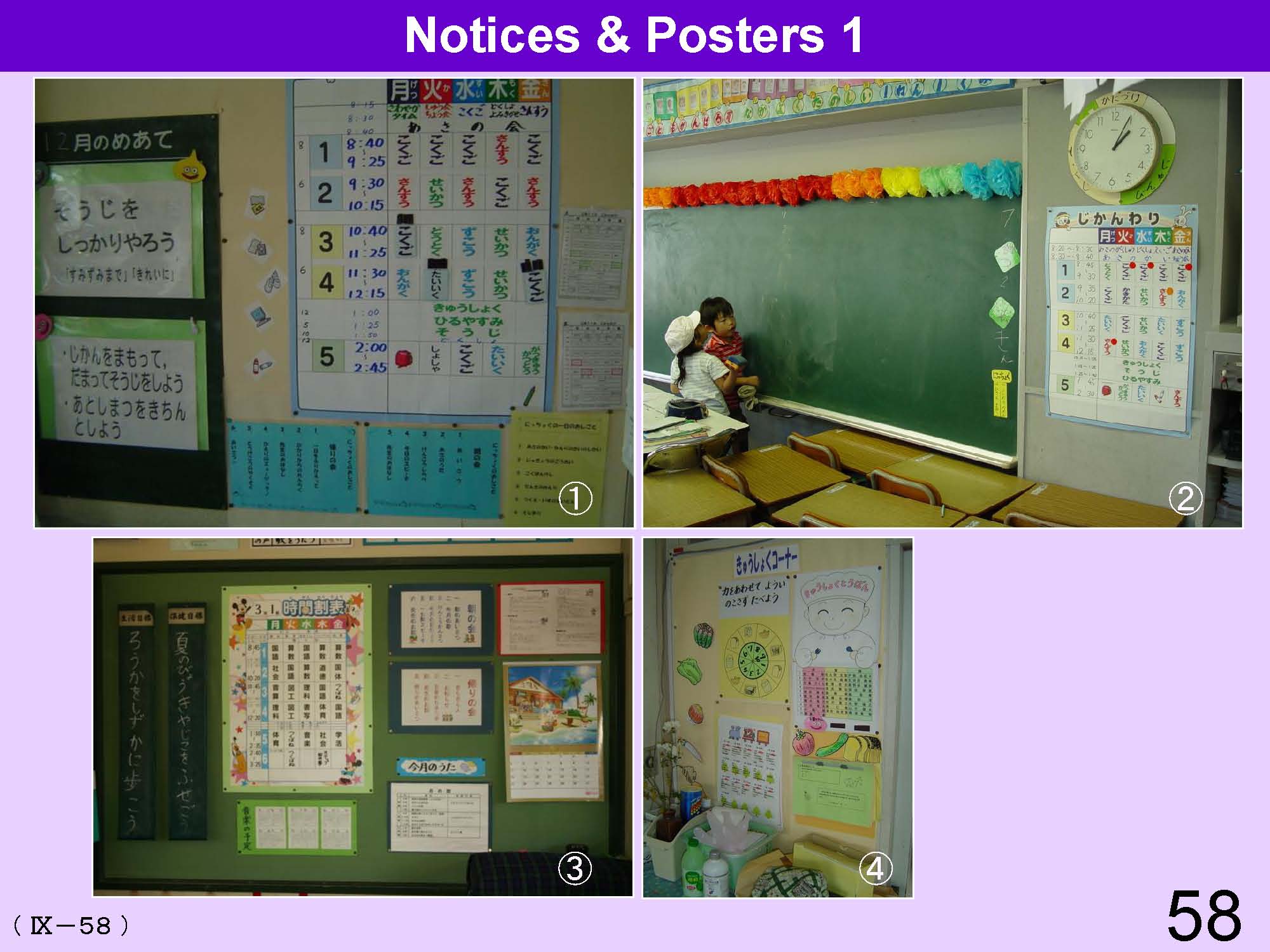 |
Around the blackboard: These are pictures of the blackboard in front of class and around the blackboard. The date and the names of students who have duties on that day are written at the bottom right corner of the blackboard and are updated daily (②). Posters of monthly goals, the slogan of the class (①), time schedule (①), the names of students in charge of retrieving and serving lunch from the kitchen, and the lunch menu are posted on the right side of the blackboard (④), these are ways to communicate with the students. Cards for a morning meeting (①③), the meeting at the end of the day, and the names of the students who have duties on that day enable students to know what their roles are for the day. The posters around the blackboard are mainly about what students need to do in their daily school life, and what the teachers want to let the students know, and therefore the space is used more as a bulletin boardas compared with other spaces in the classroom. It is also one of students cooperative responsibilities to make notice, to make notices, posters and attach these to the blackboard. |
| 59 | 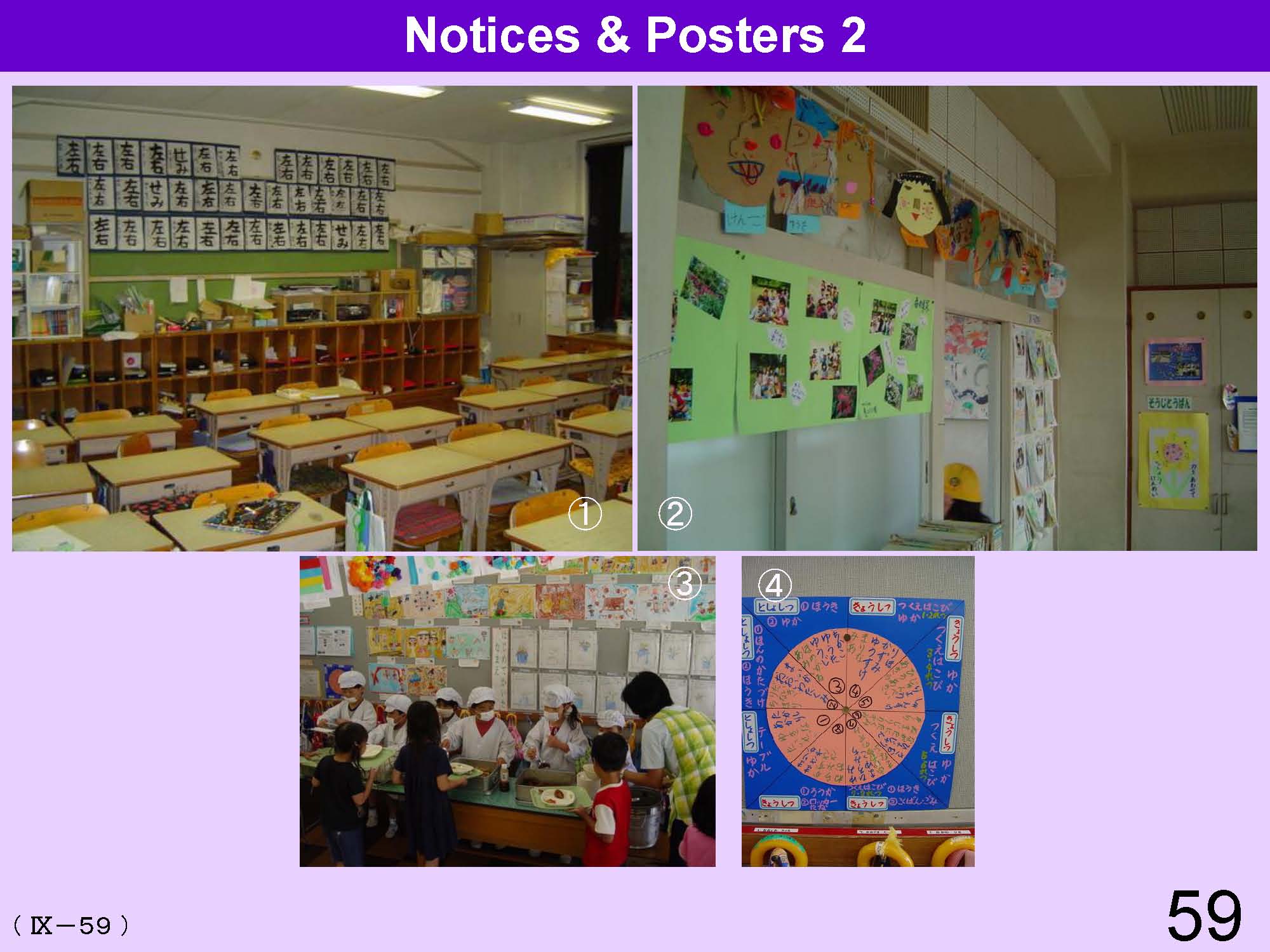 |
The side walls and back walls in the homeroom: A rotary figure with the name of the students and pictures shows who is in charge of particular class tasks. Students take turns in cleaning different areas in their classrooms and school s(④). The school lunch newsletter, the grade newsletter, and the school newsletter are made by non homeroom teachers. In addition to these, there are special student creations in the classes (Japanese calligraphy (①), drawing (②③), handcraft (②③), and compositions), and the contents relate to the students individually. |
| 60 | 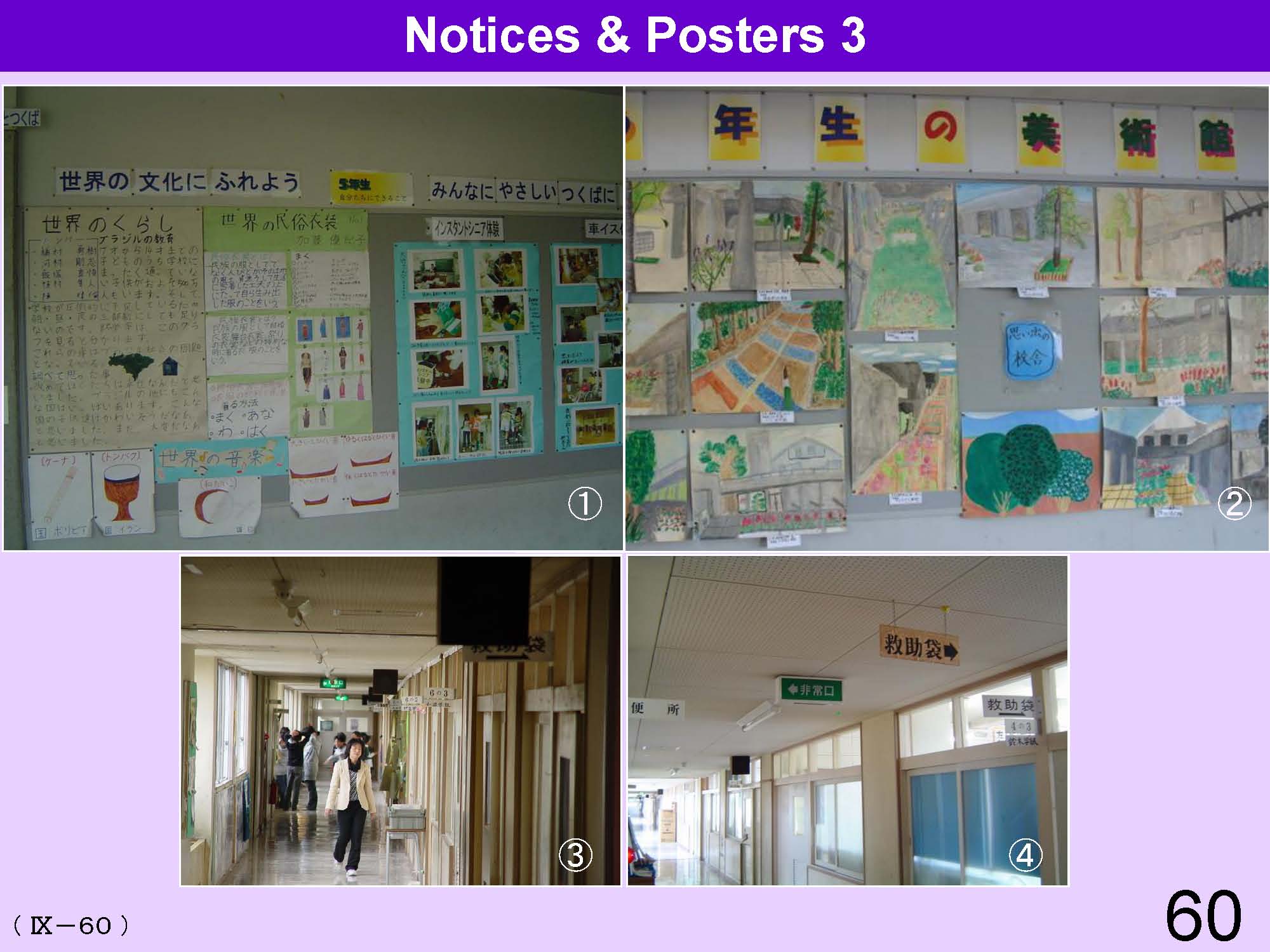 |
Hallway: There are signs at the entrance of each classroom. The grade, classroom number and name of home room teacher are written on the sign(③). Signs for emergency exits and emergency goods are also visible(④). Social topics are written on posters, lunch news and children’s newspapers on the wall. In addition to grade news and health news, notices and introduction of activities at grade units, such as the period of integrated study and (international understanding, welfare activities) school trip are visible. ①5th grade June 2004 ②6th grade November 2004 ③,④December 2003 |
| 61 | 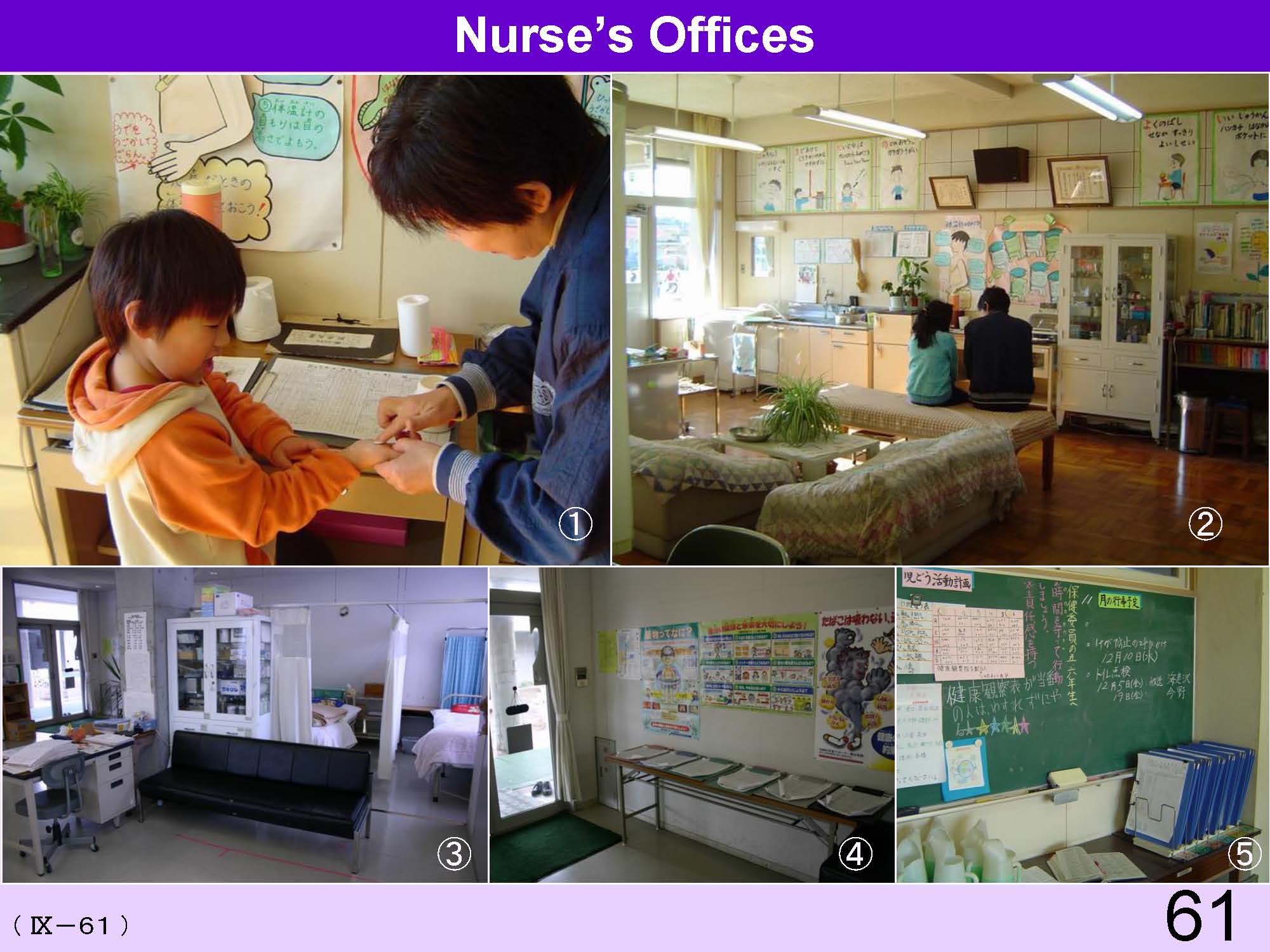 |
①A nurse treats a student’s injury, December 2003 ②A nurse counsels a student, December 2003 ③A bed with curtains, February 2005 ④Health check records, February 2005 ⑤Bulletin board on the side of the nurse’s office door Every school has a nurse’s office. |
| 62 | 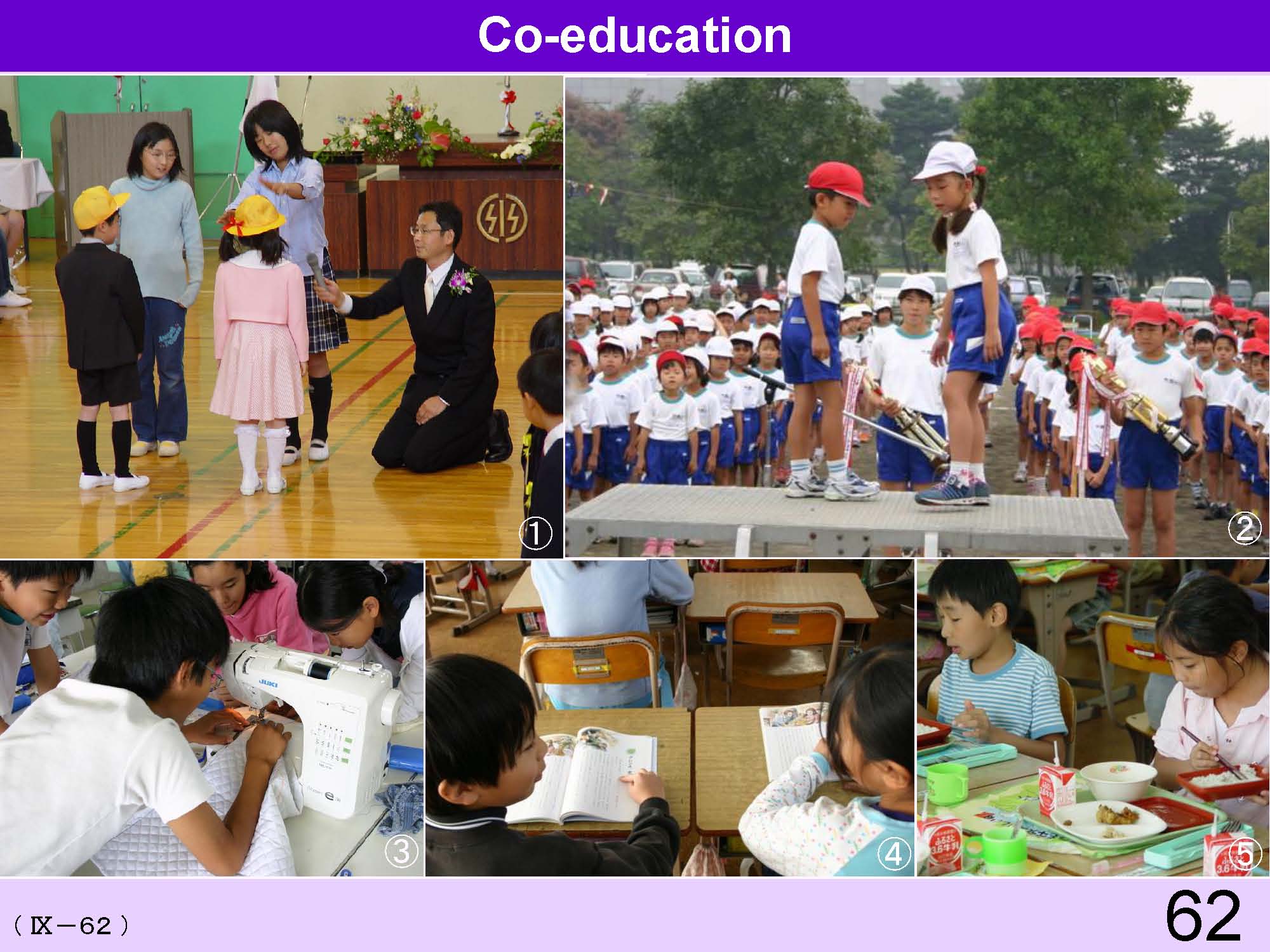 |
At school events, both boys and girls serve as student representatives. In classrooms boys and girls sit side by side. In a group study activity boys and girls do the same work. ①Entrance ceremony for new 1st grade students, April 2004, ②Athletic Meeting, 1st grade, September 2004 ③Home Economics, 5th grade, November 2004, ④Moral Education, 4th grade November 2004 ⑤School Lunch, 1st grade, July 2004 |
| 63 | 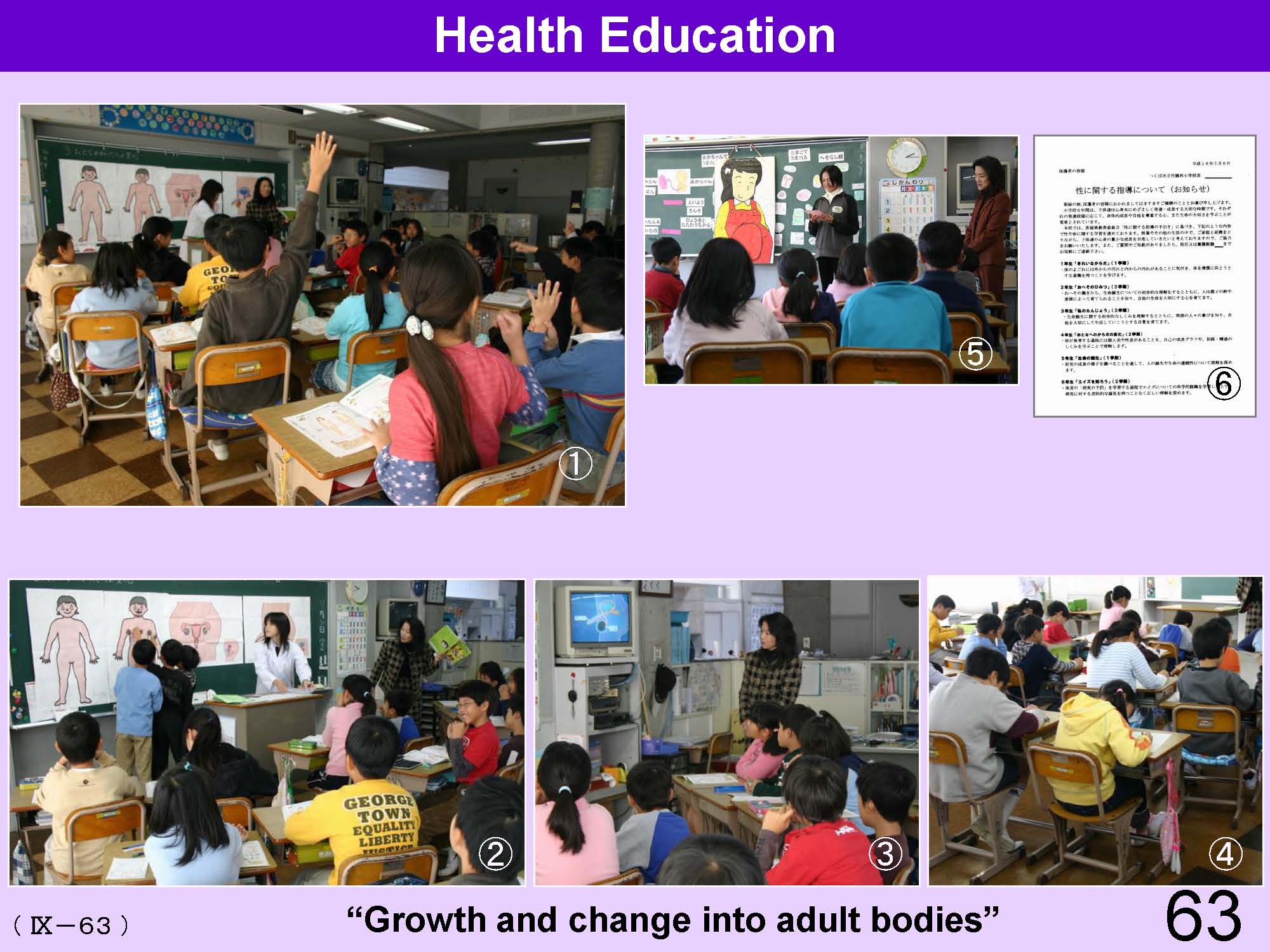 |
①Team teaching by a homeroom teacher and nurse teacher, 4th grade, November 2004, ②Study with students work, 4th grade, November 2004, ③Watching a video program, 4th grade, November 2004, ④Remarks, 4th grade, November 2004, ⑤A notice from the principal to the students’ parents. <>br 1st grade 「Clean body」(1st semester), 2nd grade 「The secret of the navel」(3rd semester), 3rd grade 「My birth」(3rd semester), 4th grade 「Changes into an adult body」(2nd semester), 5th grade 「Birth of new life」(1st semester), 6th grade 「Let’s learn about AIDS」(2nd semester), (based on “a guide book for sex education”(Prefectural Board of Education)) |
| 64 | 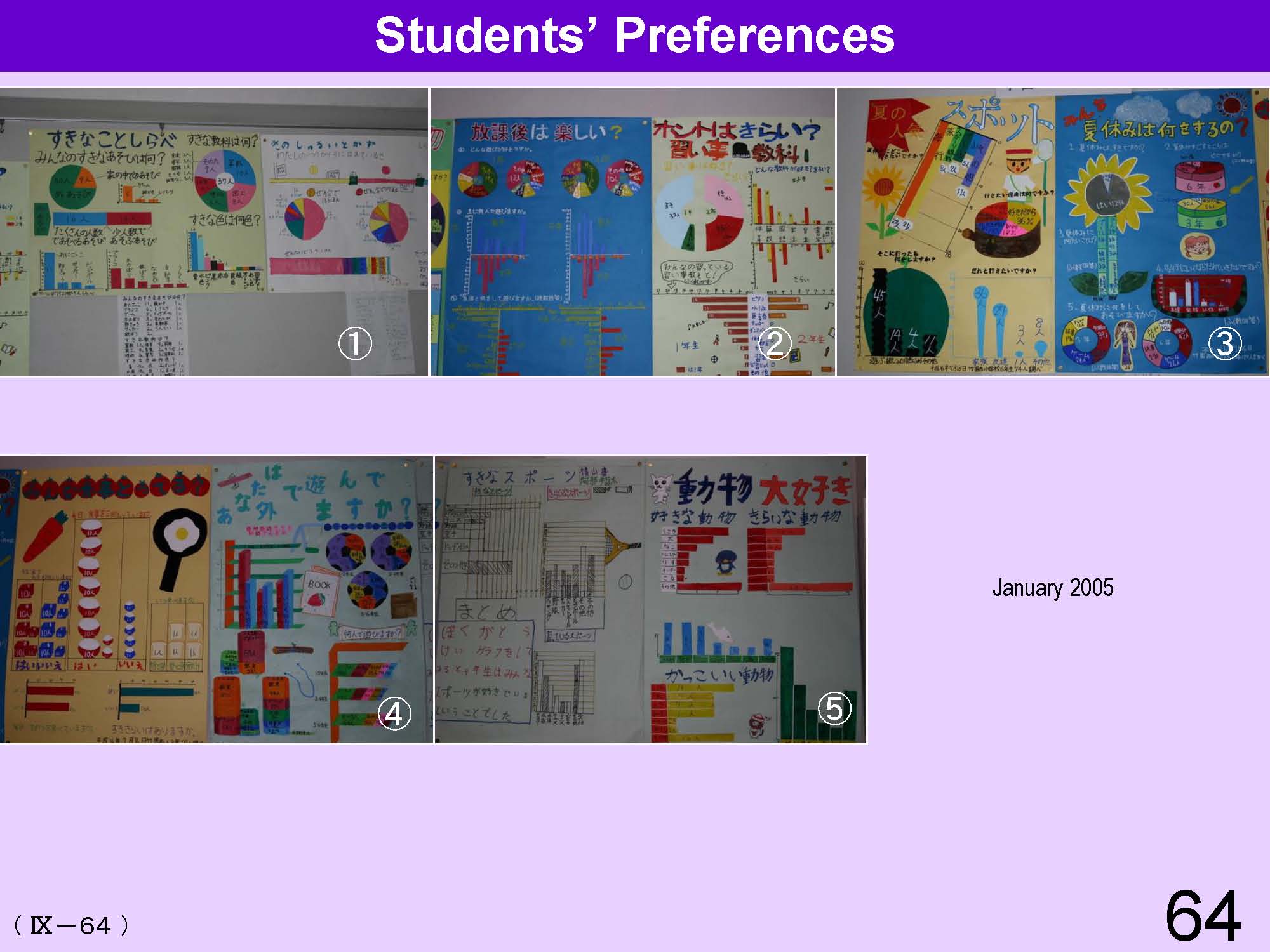 |
①Posters: A survey of students’ favorite game and color ②Posters: A survey of students’ favorite subject and lesson ③Posters: “What will you do in the summer vacation?” ④Posters: “Do you have a meal three times a day?” and “Do you play outside?” ⑤Posters: A survey of students’ favorite sports and animals |
| 65 | 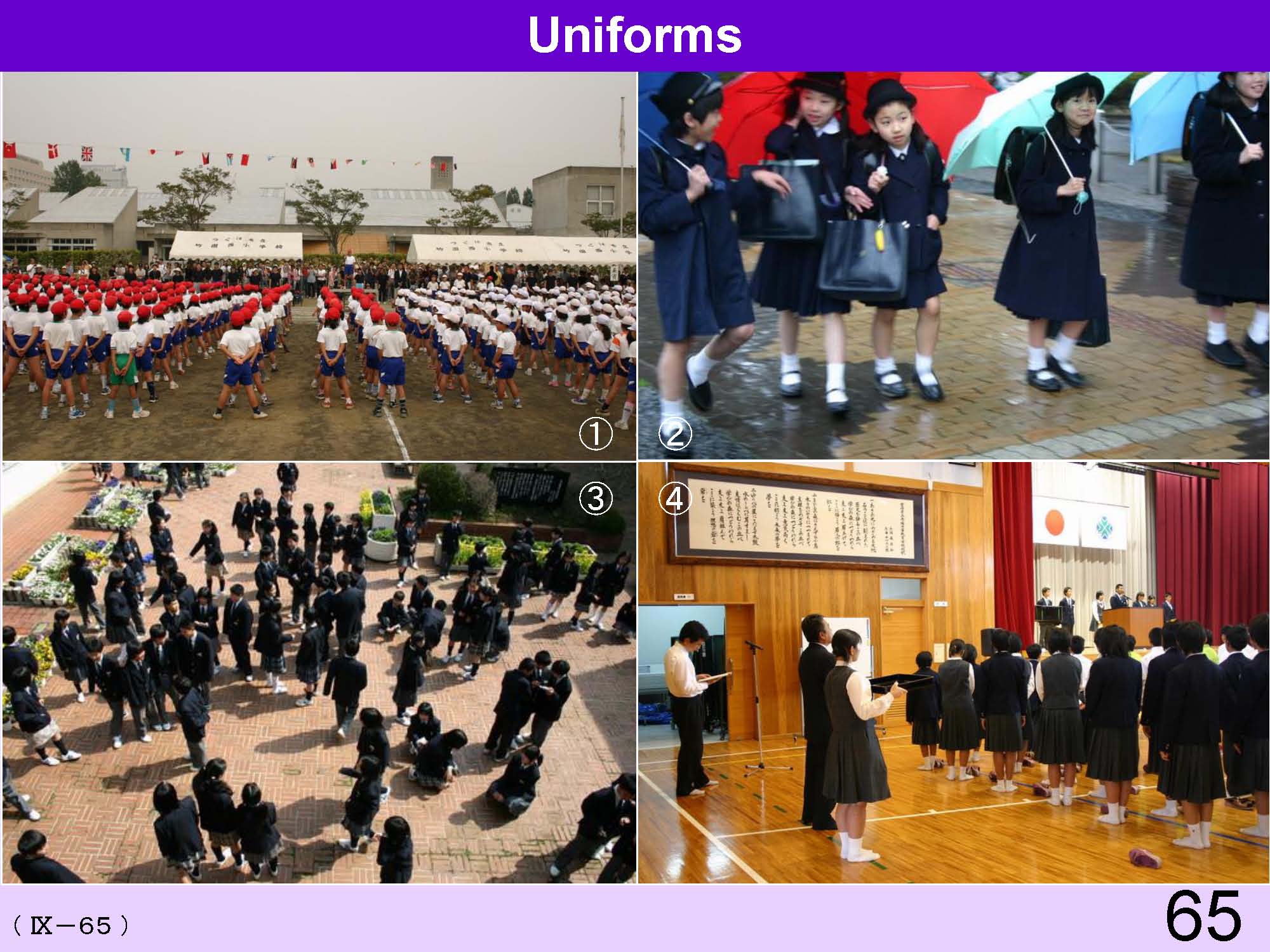 |
①Gym suits (in primary school, September 2004) ②Students wear school uniforms (in an elementary school attached to a national university, March 2005) ③Students wear school uniforms (in a lower secondary school, April 2005) ④Students wear school uniforms (in a six-year secondary school, October 2004) |
| 66 | 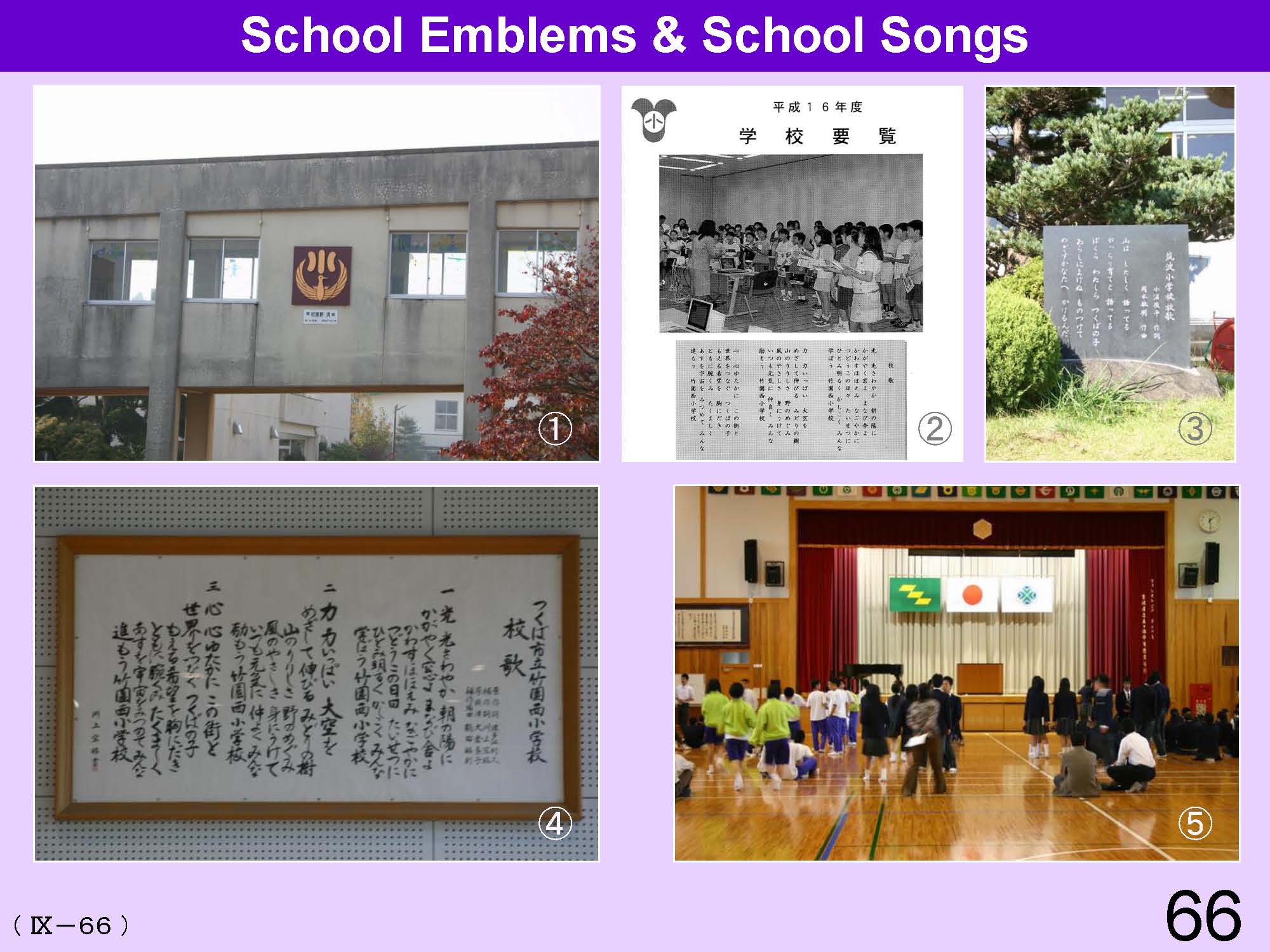 |
①School emblem (primary school) ②School emblem and school song (school pamphlet, primary school) ③④School song (primary school) ⑤Prefectural flag, National flag and School emblem (six-year secondary school) Every school has its own emblem and song. By using the school emblem and song, students nurture their love for and attachment to their school. |
| 67 | 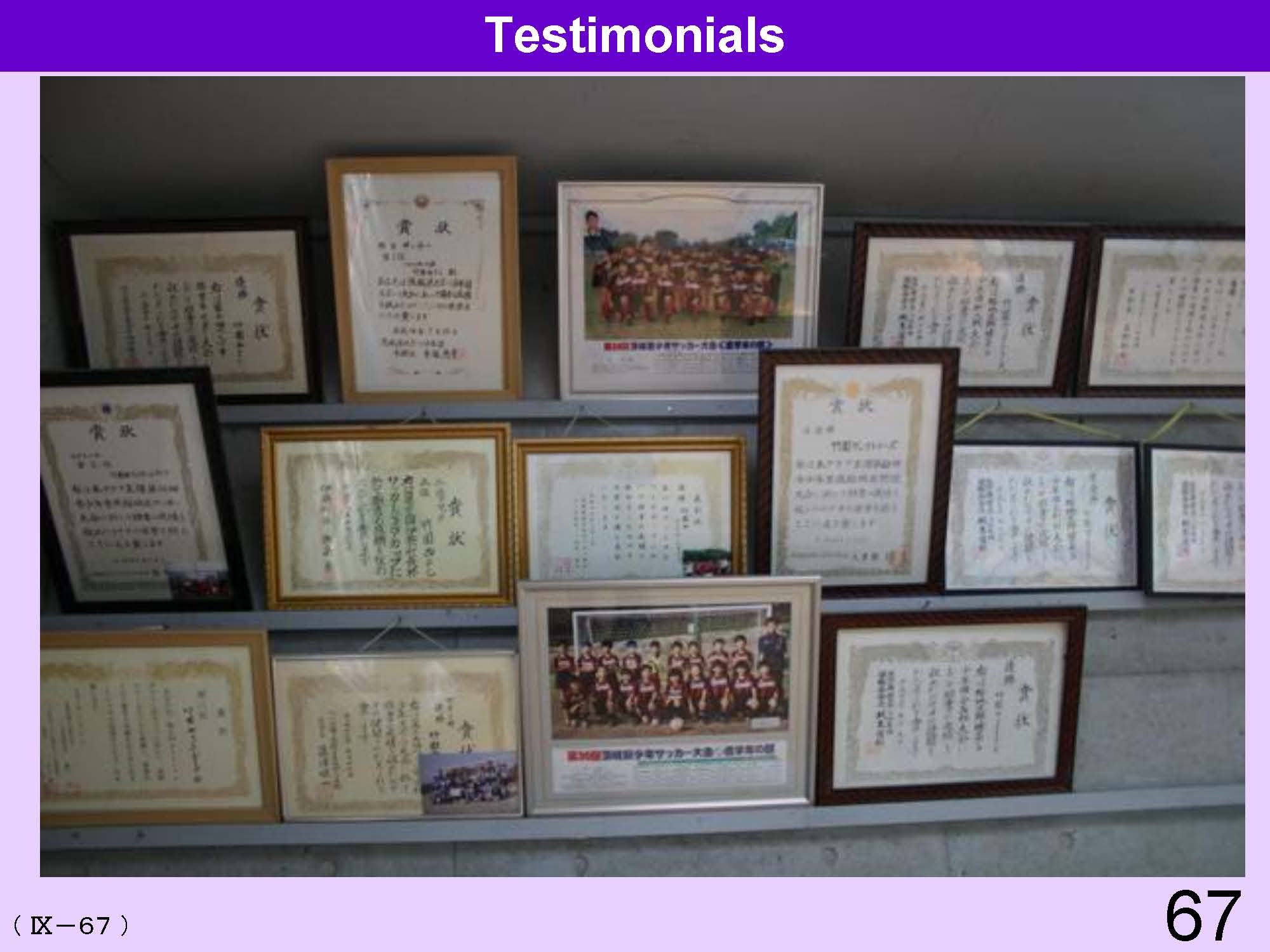 |
|
| 68 |  |
①②The national flag and the school emblem flag ②School clock |
| 69 | 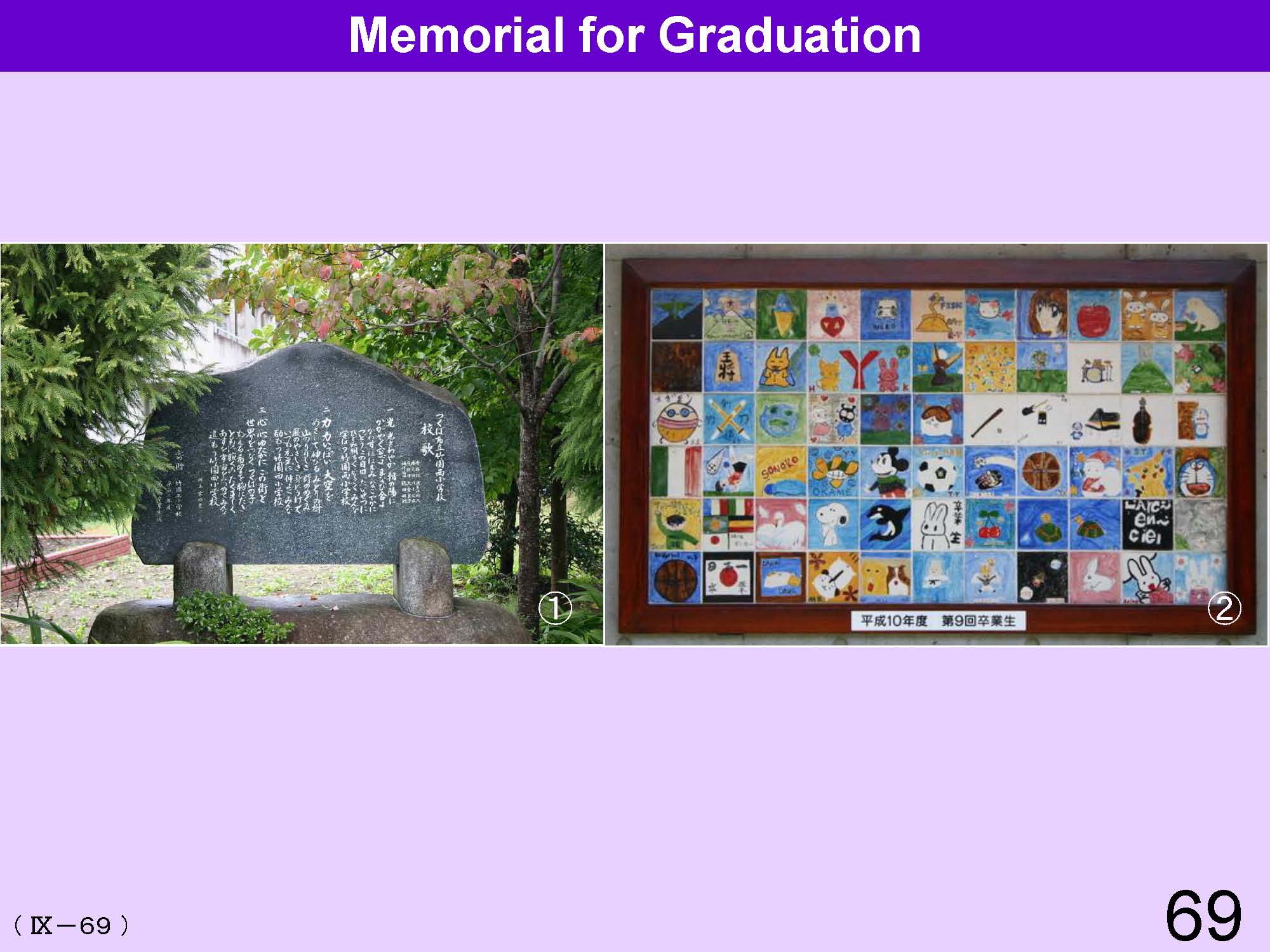 |
Graduates donate memorials to their school. ①The lyrics of the school song are carved on a stone monument ②Tiles made by the graduates |
| 70 | 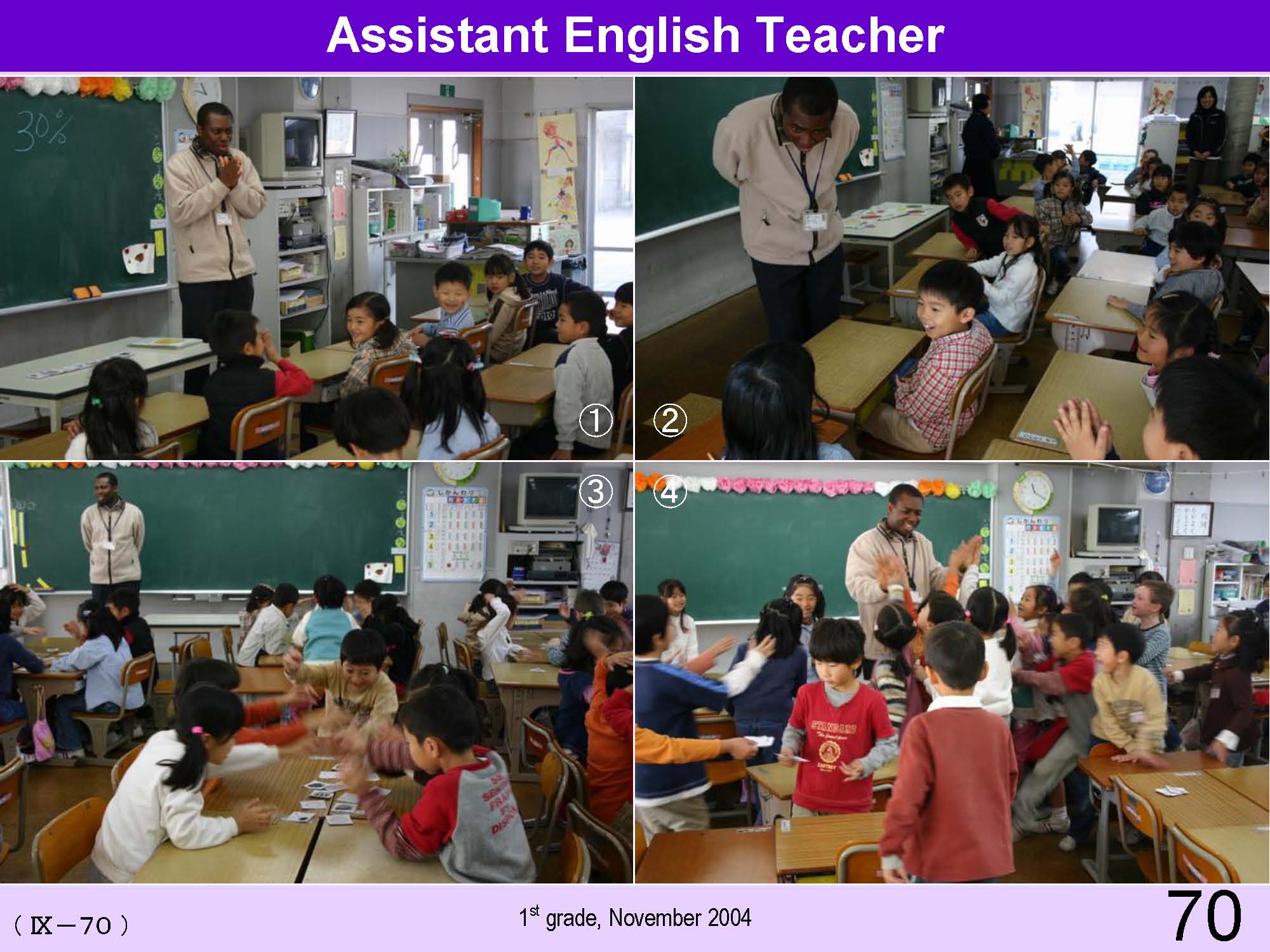 |
An English lesson by an AET (Assistant English Teacher): AETs are employed by the Board of Education in each city. ①②An AET reviews the last lesson ③An AET employs an English card game. ④With an AET after class |
| 71 | 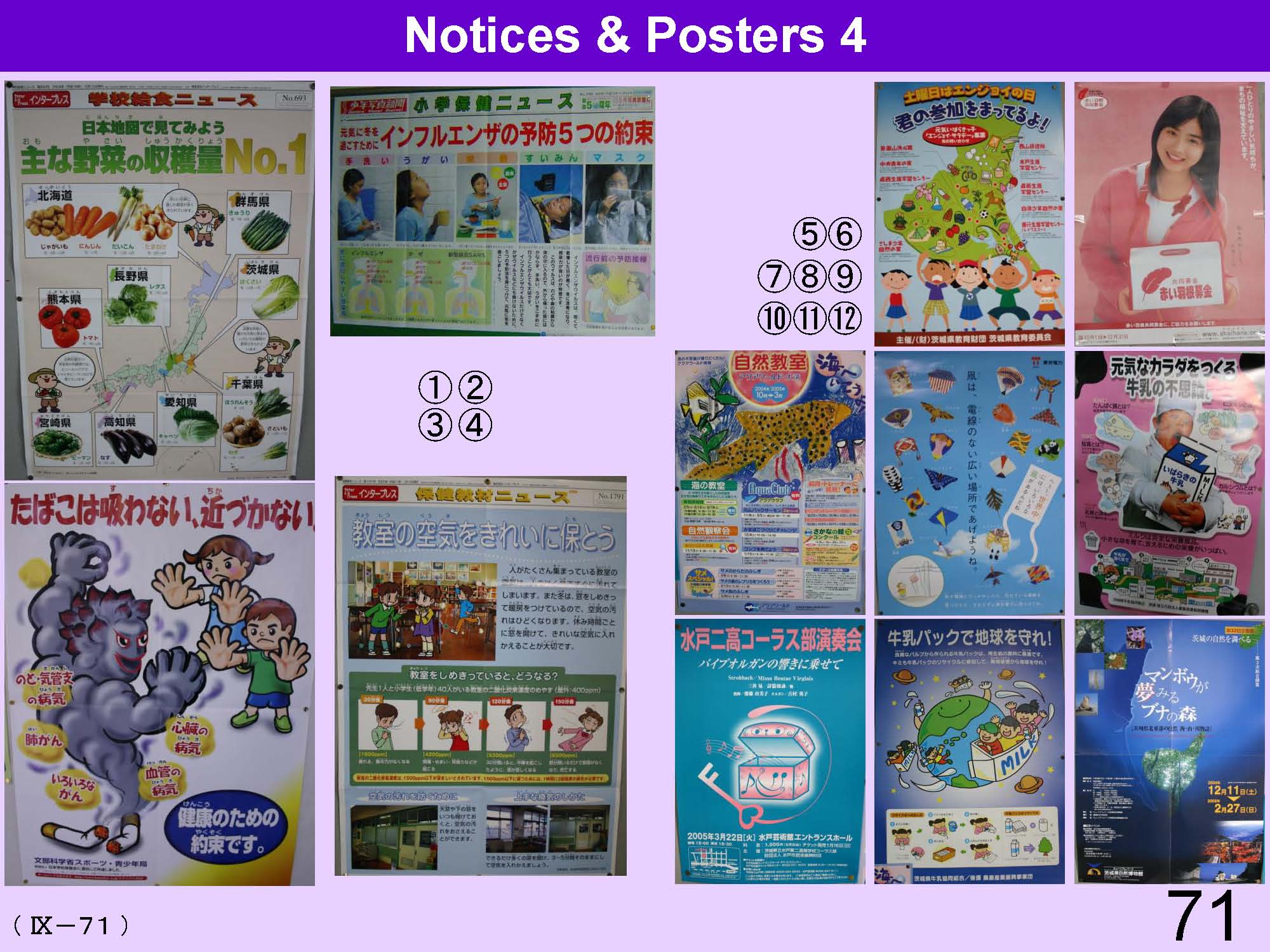 |
Posters and newspapers which are sent by various external organizations are posted in school areas . |
| 72 | 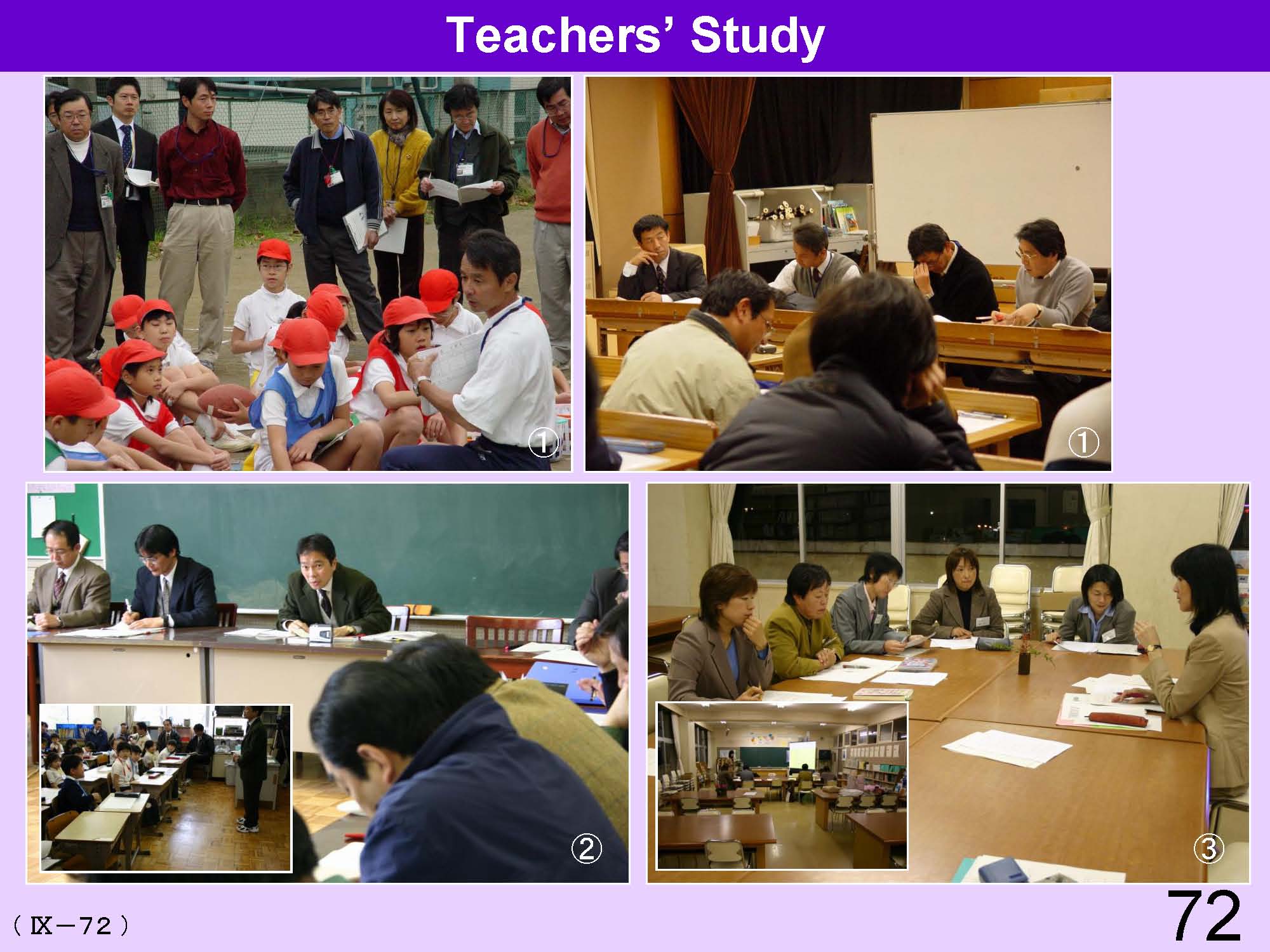 |
①In-service training within own school:class visit by teachers and reflection meeting (Physical education, 4th grade, November 2003) ②In-service training within own school:class visit by teachers and reflection meeting (Moral education, 1st grade, March 2005) ③In-service training within own school:Teachers from several schools gather with lesson plans and discuss them. A guidance director from prefectural training center joins in at the request of teachers. (Japanese language teachers of several elementary schools and lower secondary schools November 2004) In-service training and study meetings for teachers are conducted quite often. |
| TOP | ||
Please send your comments and concerns here
kamada@criced.tsukuba.ac.jp
Center for Research on International Cooperation in Educational Development (CRICED) University of Tsukuba
1-1-1, Tennodai, Tsukuba-shi, IBARAKI
305-8572 JAPAN